Sony Group DSXS310BT FM/AM Digital Media Player User Manual DSX S310BTX
Sony Corporation FM/AM Digital Media Player DSX S310BTX
User_Manual
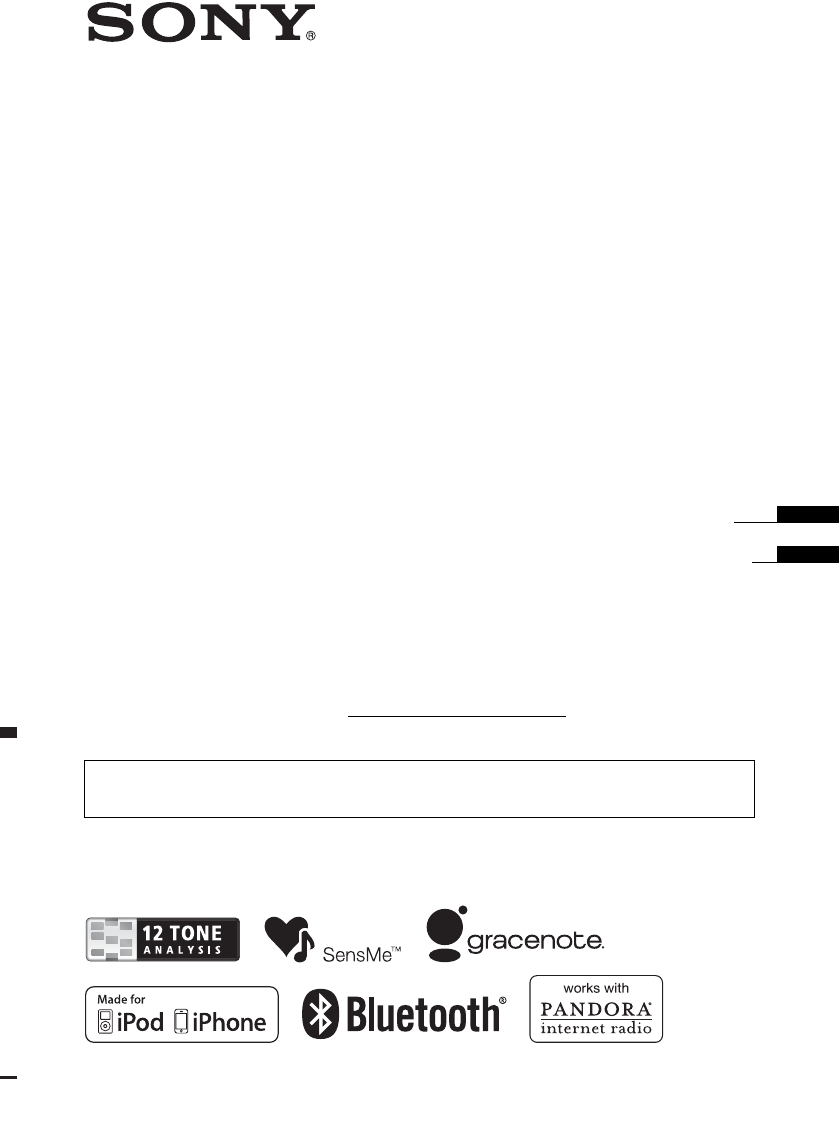
©2011 Sony Corporation
Operating Instructions
Manual de instrucciones
Owner’s Record
The model and serial numbers are located on the bottom of the unit.
Record the serial number in the space provided below.
Refer to these numbers whenever you call upon your Sony dealer regarding this product.
Model No. DSX-S310BTX Serial No.
To cancel the demonstration (Demo) display, see page 8.
Para cancelar la pantalla de demostración (Demo), consulte la página 8.
4-286-015-11(1)
DSX-S310BTX
US
ES
FM/AM
Digital Media Player

2
Warning
This device complies with Part 15 of the FCC
Rules. Operation is subject to the following two
conditions: (1) this device may not cause harmful
interference, and (2) this device must accept any
interference received, including interference that
may cause undesired operation.
This equipment complies with FCC radiation
exposure limits set forth for an uncontrolled
environment and meets the FCC radio frequency
(RF) Exposure Guidelines in Supplement C to
OET65. This equipment has very low levels of
RF energy that it deemed to comply without
maximum permissive exposure evaluation
(MPE). But it is desirable that it should be
installed and operated keeping the radiator at
least 20 cm or more away from person’s body
(excluding extremities: hands, wrists, feet and
ankles).
ZAPPIN and Quick-BrowZer are trademarks of
Sony Corporation.
The Bluetooth word mark and logos are owned
by the Bluetooth SIG, Inc. and any use of such
marks by Sony Corporation is under license.
Other trademarks and trade names are those of
their respective owners.
Be sure to install this unit in the dashboard of
the car for safety. For installation and
connections, see the supplied installation/
connections manual.
This equipment has been tested and found to
comply with the limits for a Class B digital
device, pursuant to Part 15 of the FCC Rules.
These limits are designed to provide reasonable
protection against harmful interference in a
residential installation. This equipment
generates, uses, and can radiate radio frequency
energy and, if not installed and used in
accordance with the instructions, may cause
harmful interference to radio communications.
However, there is no guarantee that interference
will not occur in a particular installation. If this
equipment does cause harmful interference to
radio or television reception, which can be
determined by turning the equipment off and on,
the user is encouraged to try to correct the
interference by one or more of the following
measures:
–
Reorient or relocate the receiving antenna.
–
Increase the separation between the equipment
and receiver.
–
Connect the equipment into an outlet on a
circuit different from that to which the receiver
is connected.
–
Consult the dealer or an experienced radio/TV
technician for help.
You are cautioned that any changes or
modifications not expressly approved in this
manual could void your authority to operate this
equipment.
This transmitter must not be co-located or
operated in conjunction with any other antenna
or transmitter.
For the State of California, USA only
Perchlorate Material – special handling may apply,
See www.dtsc.ca.gov/hazardouswaste/perchlorate
Perchlorate Material: Lithium battery contains
perchlorate
HD Radio
TM
is a proprietary trademark of
iBiquity Digital Corp.
The “SAT Radio Ready”
logo indicates that this
product will control a
satellite radio tuner module
(sold separately). Please see your nearest
authorized Sony dealer for details on the
satellite radio tuner module.
Please refer to the manuals included in the
satellite radio tuner module. Sirius or XM
Subscription required.
“SAT Radio,” “SAT Radio Ready,” the SAT
Radio and SAT Radio Ready logos and all
related marks are trademarks of Sirius XM
Radio Inc. and XM Satellite Radio Inc.

3
12 TONE ANALYSIS and its
logo are trademarks of Sony
Corporation.
“WALKMAN” and
“WALKMAN” logo are
registered trademarks of
Sony Corporation.
SensMe and the SensMe logo are
trademarks or registered
trademarks of Sony Ericsson
Mobile Communications AB.
Music recognition technology and related data
are provided by Gracenote®. Gracenote is the
industry standard in music recognition
technology and related content delivery. For
more information, please visit
www.gracenote.com.
CD, DVD, Blu-ray Disc, and music and
videorelated data from Gracenote, Inc., copyright
© 2000 to present Gracenote. Gracenote
Software, copyright © 2000 to present
Gracenote. One or more patents owned by
Gracenote apply to this product and service. See
the Gracenote website for a non-exhaustive list
of applicable Gracenote patents.
Gracenote, CDDB, MusicID, MediaVOCS, the
Gracenote logo and logotype, and the ”Powered
by Gracenote” logo are either registered
trademarks or trademarks of Gracenote in the
United States and/or other countries.
Microsoft, Windows, Windows Vista and
Windows Media and logos are trademarks or
registered trademarks of Microsoft Corporation
in the United States and/or other countries.
This product contains technology subject to
certain intellectual property rights of Microsoft.
Use or distribution of this technology outside of
this product is prohibited without the appropriate
license(s) from Microsoft.
iPhone®, iPod®, iPod classic®, iPod nano®,
and iPod touch® are trademarks of Apple Inc.,
registered in the U.S. and other countries.
PANDORA, the PANDORA logo, and the
Pandora trade dress are trademarks or registered
trademarks of Pandora Media, Inc., used with
permission.
Android is a trademark of Google Inc. Use of this
trademark is subject to Google Permissions.
BlackBerry® is the property of Research In
Motion Limited and is registered and/or used in
the U.S. and countries around the world. Used
under license from Research In Motion Limited.
Warning if your car’s ignition has no
ACC position
Be sure to set the Auto Off function (page 42).
The unit will shut off completely and
automatically in the set time after the unit is
turned off, which prevents battery drain.
If you do not set the Auto Off function, press
and hold (SOURCE/OFF) until the display
disappears each time you turn the ignition off.
Apple, Macintosh and iTunes are trademarks of
Apple Inc., registered in the U.S. and other
countries.
MPEG Layer-3 audio coding technology and
patents licensed from Fraunhofer IIS and Thomson.

4
Table of Contents
Getting Started
Notes on Bluetooth . . . . . . . . . . . . . . . . . . . . . . 7
Resetting the unit. . . . . . . . . . . . . . . . . . . . . . . . 7
Canceling the Demo mode . . . . . . . . . . . . . . . . 8
Preparing the card remote commander . . . . . . . 8
Setting the clock . . . . . . . . . . . . . . . . . . . . . . . . 8
Detaching the front panel . . . . . . . . . . . . . . . . . 8
Attaching the front panel . . . . . . . . . . . . . . . 9
Quick Guide for Bluetooth function
3 steps to Bluetooth function. . . . . . . . . . . . . . 10
Buttons and icons . . . . . . . . . . . . . . . . . . . . . . 11
1Pairing . . . . . . . . . . . . . . . . . . . . . . . . . . . . 12
2Connecting . . . . . . . . . . . . . . . . . . . . . . . . . 12
3Handsfree calling/Music streaming/Playing
back Pandora . . . . . . . . . . . . . . . . . . . . . . . . . . 13
Location of controls and basic
operations
Main unit. . . . . . . . . . . . . . . . . . . . . . . . . . . 14
RM-X306 Card Remote Commander . . . . . 16
Radio
Storing and receiving stations . . . . . . . . . . . . . 18
Storing automatically — BTM . . . . . . . . . . 18
Storing manually. . . . . . . . . . . . . . . . . . . . . 18
Receiving the stored stations . . . . . . . . . . . 18
Tuning automatically . . . . . . . . . . . . . . . . . 18
RDS . . . . . . . . . . . . . . . . . . . . . . . . . . . . . . . . . 19
Overview. . . . . . . . . . . . . . . . . . . . . . . . . . . 19
Selecting PTY . . . . . . . . . . . . . . . . . . . . . . . 19
Setting CT. . . . . . . . . . . . . . . . . . . . . . . . . . 19
USB devices
Playing back a USB device. . . . . . . . . . . . . . . 20
Playing back via the USB (internal)
connector . . . . . . . . . . . . . . . . . . . . . . . . . . 20
Playing back via the USB (external)
connector . . . . . . . . . . . . . . . . . . . . . . . . . . 21
Display items . . . . . . . . . . . . . . . . . . . . . . . 21
Repeat play. . . . . . . . . . . . . . . . . . . . . . . . . 22
Shuffle play . . . . . . . . . . . . . . . . . . . . . . . . 22
Enjoying music according to your mood
— SensMe™. . . . . . . . . . . . . . . . . . . . . . . . . . 22
Before using the SensMe™ function . . . . . 22
Installing “SensMe™ Setup” and “Content
Transfer” in your computer . . . . . . . . . . . . 23
Registering a USB device using “SensMe™
Setup”. . . . . . . . . . . . . . . . . . . . . . . . . . . . . 23
Transferring tracks to the USB device using
“Content Transfer”. . . . . . . . . . . . . . . . . . . 23
Playing tracks in the channel
— SensMe™ channels. . . . . . . . . . . . . . . . 24
iPod
Playing back iPod . . . . . . . . . . . . . . . . . . . . . . 25
Playing back via the USB (internal)
connector . . . . . . . . . . . . . . . . . . . . . . . . . . 25
Playing back via the USB (external)
connector . . . . . . . . . . . . . . . . . . . . . . . . . . 26
Display items . . . . . . . . . . . . . . . . . . . . . . . 27
Repeat play. . . . . . . . . . . . . . . . . . . . . . . . . 27
Shuffle play . . . . . . . . . . . . . . . . . . . . . . . . 28
Operating an iPod directly
— Passenger control . . . . . . . . . . . . . . . . . . . . 28
Pandora® via USB (iPhone)
Playing back Pandora . . . . . . . . . . . . . . . . . . . 29
Playing back via the USB (external)
connector . . . . . . . . . . . . . . . . . . . . . . . . . . 29
“Thumbs” feedback . . . . . . . . . . . . . . . . . . 29
Station list. . . . . . . . . . . . . . . . . . . . . . . . . . 30
Bookmarking . . . . . . . . . . . . . . . . . . . . . . . 30

5
Searching for a track
Searching a track by name
— Quick-BrowZer™. . . . . . . . . . . . . . . . . . . . 30
Searching by skip items
— Jump mode. . . . . . . . . . . . . . . . . . . . . . . 30
Searching by alphabetical order
— Alphabet search . . . . . . . . . . . . . . . . . . . 31
Searching a track by listening to track passages
— ZAPPIN™ . . . . . . . . . . . . . . . . . . . . . . . . . 31
In the case of “SensMe™ channels”
playback . . . . . . . . . . . . . . . . . . . . . . . . . . . 31
Bluetooth (Handsfree calling and
Music streaming)
Bluetooth Operations. . . . . . . . . . . . . . . . . . . . 32
About Bluetooth icons . . . . . . . . . . . . . . . . 32
Installing the microphone . . . . . . . . . . . . . . 32
Pairing . . . . . . . . . . . . . . . . . . . . . . . . . . . . . . . 32
Connecting. . . . . . . . . . . . . . . . . . . . . . . . . . . . 33
Connecting a cellular phone . . . . . . . . . . . . 33
Connecting an audio device . . . . . . . . . . . . 33
Handsfree calling. . . . . . . . . . . . . . . . . . . . . . . 34
Making calls . . . . . . . . . . . . . . . . . . . . . . . . 34
Receiving calls . . . . . . . . . . . . . . . . . . . . . . 34
Operations during a call . . . . . . . . . . . . . . . 34
Call transfer. . . . . . . . . . . . . . . . . . . . . . . . . 35
Phonebook management . . . . . . . . . . . . . . . 35
Preset dial . . . . . . . . . . . . . . . . . . . . . . . . . . 36
Voice dial activation . . . . . . . . . . . . . . . . . . 36
SMS indicator . . . . . . . . . . . . . . . . . . . . . . . 36
Music streaming . . . . . . . . . . . . . . . . . . . . . . . 37
Listening to music from an audio
device . . . . . . . . . . . . . . . . . . . . . . . . . . . . . 37
Operating an audio device with this
unit . . . . . . . . . . . . . . . . . . . . . . . . . . . . . . . 37
Other settings. . . . . . . . . . . . . . . . . . . . . . . . . . 37
Initializing Bluetooth Settings . . . . . . . . . . 37
Pandora via Bluetooth (Android™
& BlackBerry® phones)
Playing back Pandora . . . . . . . . . . . . . . . . . . . 38
Playing back via Bluetooth . . . . . . . . . . . . . 38
“Thumbs” feedback . . . . . . . . . . . . . . . . . . 38
Station list . . . . . . . . . . . . . . . . . . . . . . . . . . 39
Bookmarking . . . . . . . . . . . . . . . . . . . . . . . 39
Sound Settings and Setup Menu
Changing the sound settings . . . . . . . . . . . . . . 39
Adjusting the sound characteristics . . . . . . 39
Enjoying sophisticated sound functions
— Advanced Sound Engine . . . . . . . . . . . . . . 40
Selecting the sound quality
— EQ7 Preset. . . . . . . . . . . . . . . . . . . . . . . 40
Customizing the equalizer curve
— EQ7 Parametric Tune . . . . . . . . . . . . . . 40
Optimizing sound by Time Alignment
— Listening Position . . . . . . . . . . . . . . . . . 41
Precisely calibrating by Time Alignment
— Listening Position Custom Tune. . . . . . 41
DM+ Advanced . . . . . . . . . . . . . . . . . . . . . 42
Using rear speakers as subwoofer
— Rear Bass Enhancer. . . . . . . . . . . . . . . . 42
Compensating volume level
— Dynamic Loudness . . . . . . . . . . . . . . . . 42
Adjusting setup items — MENU . . . . . . . . . . 42
Additional Information
Precautions . . . . . . . . . . . . . . . . . . . . . . . . . . . 44
Playback order of MP3/WMA/
AAC files . . . . . . . . . . . . . . . . . . . . . . . . . . 44
About Device Inside Alert . . . . . . . . . . . . . 44
About iPod . . . . . . . . . . . . . . . . . . . . . . . . . 44
About Bluetooth function. . . . . . . . . . . . . . 44
Maintenance . . . . . . . . . . . . . . . . . . . . . . . . . . 45
Removing the unit. . . . . . . . . . . . . . . . . . . . . . 46
Specifications . . . . . . . . . . . . . . . . . . . . . . . . . 47
Troubleshooting . . . . . . . . . . . . . . . . . . . . . . . 48
Error displays/Messages. . . . . . . . . . . . . . . 50

6
Support site
If you have any questions or for the latest support information on this
product, please visit the web site below:
http://esupport.sony.com
http://www.sony.com/mobileAV
Provides information on:
• Models and manufacturers of compatible digital audio players
• Supported MP3/WMA/AAC files
• Models and manufacturers of compatible cellular phones and the FAQ
about Bluetooth function
• System requirements for using SensMe
TM

7
2
Getting Started
Notes on Bluetooth
Caution
IN NO EVENT SHALL SONY BE LIABLE FOR
ANY INCIDENTAL, INDIRECT OR
CONSEQUENTIAL DAMAGES OR OTHER
DAMAGES INCLUDING, WITHOUT
LIMITATION, LOSS OF PROFITS, LOSS OF
REVENUE, LOSS OF DATA, LOSS OF USE OF
THE PRODUCT OR ANY ASSOCIATED
EQUIPMENT, DOWNTIME, AND
PURCHASER’S TIME RELATED TO OR
ARISING OUT OF THE USE OF THIS
PRODUCT, ITS HARDWARE AND/OR ITS
SOFTWARE.
IMPORTANT NOTICE!
Safe and efficient use
Changes or modifications to this unit not expressly
approved by Sony may void the user’s authority to
operate the equipment.
Please check for exceptions, due to national
requirement or limitations, in usage of Bluetooth
equipment before using this product.
Driving
Check the laws and regulations on the use of cellular
phones and handsfree equipment in the areas where
you drive.
Always give full attention to driving and pull off the
road and park before making or answering a call if
driving conditions so require.
Connecting to other devices
When connecting to any other device, please read its
user guide for detailed safety instructions.
Radio frequency exposure
RF signals may affect improperly installed or
inadequately shielded electronic systems in cars,
such as electronic fuel injection systems, electronic
antiskid (antilock) braking systems, electronic speed
control systems or air bag systems. For installation
or service of this device, please consult with the
manufacturer or its representative of your car. Faulty
installation or service may be dangerous and may
invalidate any warranty that may apply to this
device.
Consult with the manufacturer of your car to ensure
that the use of your cellular phone in the car will not
affect its electronic system.
Check regularly that all wireless device equipment
in your car is mounted and operating properly.
Emergency calls
This Bluetooth car handsfree and the electronic
device connected to the handsfree operate using
radio signals, cellular, and landline networks as well
as user-programmed function, which cannot
guarantee connection under all conditions.
Therefore do not rely solely upon any electronic
device for essential communications (such as
medical emergencies).
Remember, in order to make or receive calls, the
handsfree and the electronic device connected to the
handsfree must be switched on in a service area with
adequate cellular signal strength.
Emergency calls may not be possible on all cellular
phone networks or when certain network services
and/or phone features are in use.
Check with your local service provider.
Resetting the unit
Before operating the unit for the first time, or
after replacing the car battery or changing the
connections, you must reset the unit.
Detach the front panel (page 8) and press the
RESET button (page 14) with a pointed object,
such as a ball-point pen.
Note
Pressing the RESET button will erase the clock setting
and some stored contents.
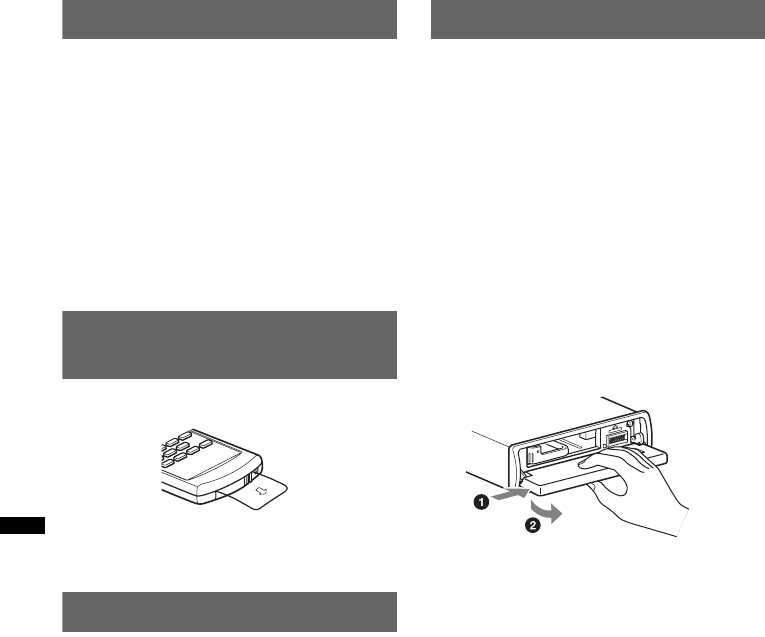
8
Canceling the Demo mode
You can cancel the demonstration display which
appears during turning off.
1Press and hold the multi-way encoder.
The setup display appears.
2Rotate the multi-way encoder to select
“Demo,” then press it.
3Rotate the multi-way encoder to select
“off.”
4Press and hold the multi-way encoder.
The setup is complete and the display returns
to normal reception/play mode.
Preparing the card remote
commander
Remove the insulation film.
Tip
For how to replace the battery, see page 45.
Setting the clock
The clock uses a 12-hour digital indication.
1Press and hold the multi-way encoder.
2Rotate the multi-way encoder to select
“Clock Adjust,” then press it.
The clock adjustment display appears.
3Rotate the multi-way encoder to set
the hour and minute.
To move the digital indication, push the
multi-way encoder left/right.
4After setting the minute, press the
multi-way encoder.
The clock starts.
Tip
You can set the clock automatically with the RDS
feature (page 19).
Detaching the front panel
You can detach the front panel of this unit to
prevent theft.
Caution alarm
If you turn the ignition switch to the OFF
position without detaching the front panel, the
caution alarm will sound for a few seconds.
The alarm will only sound if the built-in
amplifier is used.
1Press and hold (SOURCE/OFF).
The unit is turned off.
2Press (OPEN).
The front panel is flipped down.
3Slide the front panel to the right, then
gently pull out the left end of the front
panel.
Notes
•Do not drop or put excessive pressure on the front
panel and display window.
•Do not subject the front panel to heat/high
temperature or moisture. Avoid leaving it in a parked
car or on a dashboard/rear tray.
•Do not detach the front panel during playback of the
USB device, otherwise USB data may be damaged.
•If “Device Inside” (page 44) appears in the display or
the Device Inside Alert LED flashes, detach the front
panel and remove the USB device or iPod.
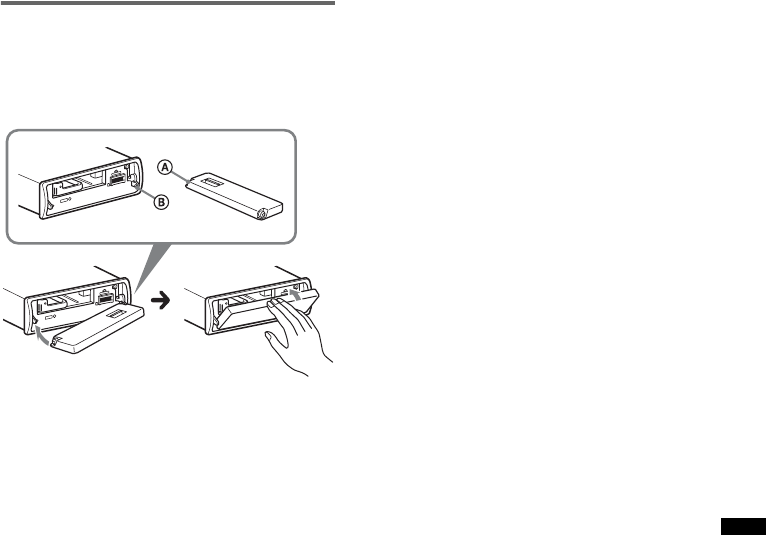
9
Attaching the front panel
Place the hole A of the front panel onto the
spindle B on the unit, then lightly push the left
side in.
Press (SOURCE/OFF) on the unit to operate the
unit.
Note
Do not put anything on the inner surface of the front
panel.

10
Quick Guide for Bluetooth function
For full details on operation, see “Bluetooth (Handsfree calling and Music streaming)” (page 32) and
the Bluetooth device operating instructions.
3 steps to Bluetooth function
1Pairing
First, register (“pair”) the Bluetooth device (cellular phone, etc.) with this unit. Pairing is no
longer required after the first time.
2Connecting
After pairing is made, connect this unit and the Bluetooth device. Depending on the device,
connection is automatically made along with the pairing.
3Handsfree calling/Music streaming/Playing back Pandora
You can make/receive a handsfree call, listen to audio and Pandora internet radio through this unit.
Support site
http://esupport.sony.com
http://www.sony.com/mobileAV

11
Buttons and icons
Icon status descriptions
Lit Bluetooth signal is on.
Flashing Pairing is in standby mode.
None Bluetooth signal is off.
Lit Connected to a cellular phone.
Flashing Connection is in progress.
None No cellular phone is connected for handsfree calling.
Lit Connected to a device.
Flashing Connection is in progress.
None No device is connected for music streaming.
Lit Some unread SMS messages exist.
Flashing A new SMS message has been received.
None No unread SMS messages exist.
Icons
Multi-way encoder
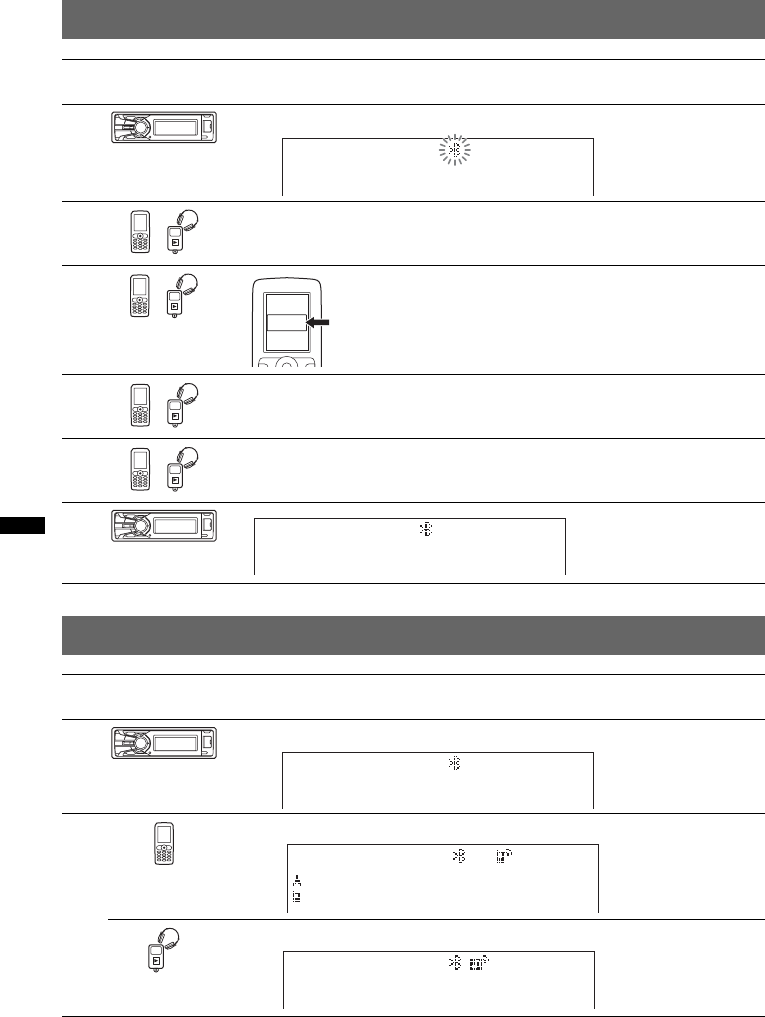
12
1Pairing
2Connecting
Note
You can connect from this unit to a Bluetooth device (page 33).
If you cannot connect from this unit to the Bluetooth device, start pairing again.
Operated
device
Operation
1Press and hold (BLUETOOTH) for 2 or more seconds.
2Search for this unit.
3
4If passkey input is required on the display of the device to be connected,
input “0000.”
5Follow the display directions.
6
Operated
device
Operation
1Press (BLUETOOTH).
2Connect to this unit using a cellular phone.
Connect to this unit using an audio device.
t
XXXXXXX
DR-BT30Q
Sony
Automotive
Select “Sony Automotive.”
(Pairing successful)
t
t
t
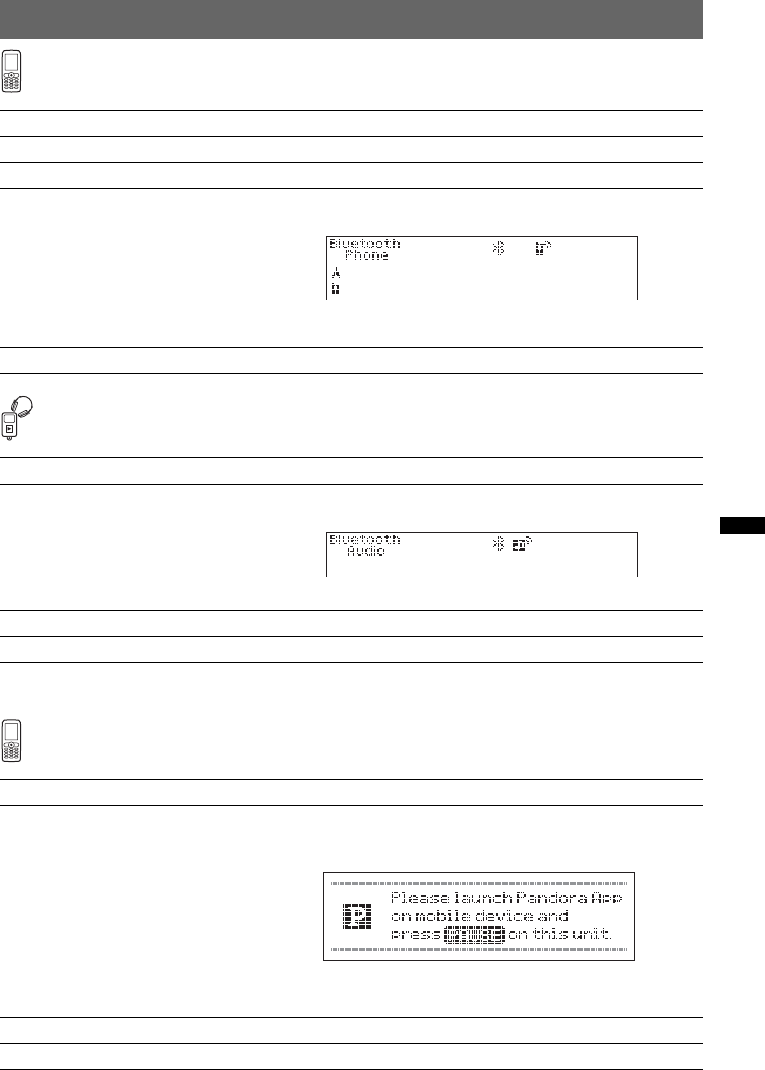
13
3Handsfree calling/Music streaming/Playing back Pandora
Handsfree calling
Music streaming
*The operation may differ depending on the audio device.
Playing back Pandora
To Operation
Receive a call/end a call Press the multi-way encoder.
Reject a call Press (SOURCE/OFF).
Redial 1Press (SOURCE/OFF) repeatedly until “Bluetooth Phone”
appears.
2Press and hold the multi-way encoder for 2 or more
seconds.
Transfer a call Press (MODE).
To Operation
Listen 1Press (SOURCE/OFF) repeatedly until “Bluetooth Audio”
appears.
2Start playback on the audio device.
Playback/pause* Press (PAUSE).
Skip tracks* Push the multi-way encoder left/right.
To Operation
Listen 1Press (SOURCE/OFF) repeatedly until “Please launch
Pandora App on mobile device and press (PAUSE) on this
unit.” appears.
2Launch Pandora on the Bluetooth device.
3Press (PAUSE).
Playback/pause Press (PAUSE).
Skip tracks Push the multi-way encoder right.
t
t
t

14
Location of controls and basic operations
Main unit
Front panel removed
This section contains instructions on the location
of controls and basic operations. For details, see
the respective pages.
ASOURCE/OFF button*1
Press to turn on the power/change the source
(Radio/USB/SensMe™*2/Pandora USB/
Bluetooth Audio/Bluetooth Pandora/
Bluetooth Phone).
Press for 1 second to turn off the power.
Press for 2 seconds or more to turn off the
power and the display disappears.
B (BROWSE) button*3 page 18, 30,
33, 34, 35
To list up (Radio); enter the Quick-
BrowZer™ mode (USB); list the station
(Pandora USB/Bluetooth Pandora); list the
phonebook (Bluetooth Phone).
CPAUSE button
To pause playback. To cancel, press again.
D (SensMe™) button page 24
EMulti-way encoder (ENTER/SOUND/
MENU/ (handsfree)/ (end call)
button)
Rotate to: Adjust the volume/select a menu
item.
Push up/down/left/right to: Select a menu
item.
Press to: Enter sound setting/apply a setting.
Press and hold to: Enter menu.
Radio:
Push up/down to:
– Receive stored station.
Push left/right to:
– Tune in stations automatically (push).
– Find a station manually (push and hold).
USB:
Push up/down to:
– Skip albums (push).
– Skip albums continuously (push and hold).
Push left/right to:
– Skip tracks (push).
– Skip tracks continuously (push, then push
again within about 2 seconds and hold).
– Reverse/fast-forward a track (push and
hold).

15
Pandora USB:
Push right to:
–Skip tracks
Push up/down to:
–Thumbs up/down (push for 1 second).
Bluetooth Audio*4:
Push left/right to:
– Skip tracks (push).
– Reverse/fast-forward a track (push and
hold).
Bluetooth Pandora:
Push right to:
–Skip tracks
Push up/down to:
–Thumbs up/down (push for 1 second).
Bluetooth Phone:
Press to receive/end a call.
Press and hold to redial.
FReceptor for the card remote
commander
GDisplay window
HOPEN button page 8
IUSB (external) connector page 21, 26
To connect to the USB device.
J (BACK)/MODE button
Press to: Select the radio band (FM/AM)*1/
switch the USB device (internal/external)/
return to the previous display.
Press and hold to: Enter/cancel the passenger
control*5/enter the bookmark mode (Pandora
USB/Bluetooth Pandora).
KBLUETOOTH button page 32
For Bluetooth signal on/off, pairing.
LZAP/SHUF button page 22, 28, 31
To enter ZAPPIN™ mode (press); select
shuffle play mode (press and hold).
MPTY/CAT button*6 page 19
To select PTY in RDS.
NDSPL (display)/SCRL (scroll) button
page 21, 27
To change display items (press); scroll the
display item (press and hold).
OUSB (internal) connector page 20, 25
To connect to the USB device.
PTUNE TRAY page 20, 25
Tray unit to place a USB device or an iPod.
QDevice Inside Alert LED page 44
RRESET button page 7
*1 If an HD Radio tuner or SAT tuner is
connected:when (SOURCE/OFF) is pressed, the
connected device (“HD,” “XM” or “SR”) will appear
in the display. Furthermore, if (MODE) is pressed,
you can switch the HD Radio tuner band or SAT
tuner band.
*2 When a USB device set up for the SensMe™
function is connected.
*3 If an HD Radio tuner or SAT tuner is connected: the
list will include HD Radio or SAT Radio accordingly.
*4 When a Bluetooth audio device (supports AVRCP
of Bluetooth technology) is connected. Depending
on the device, certain operations may not be
available.
*5 When an iPod is connected to the USB (external)
connector.
*6 When the SAT tuner is connected.
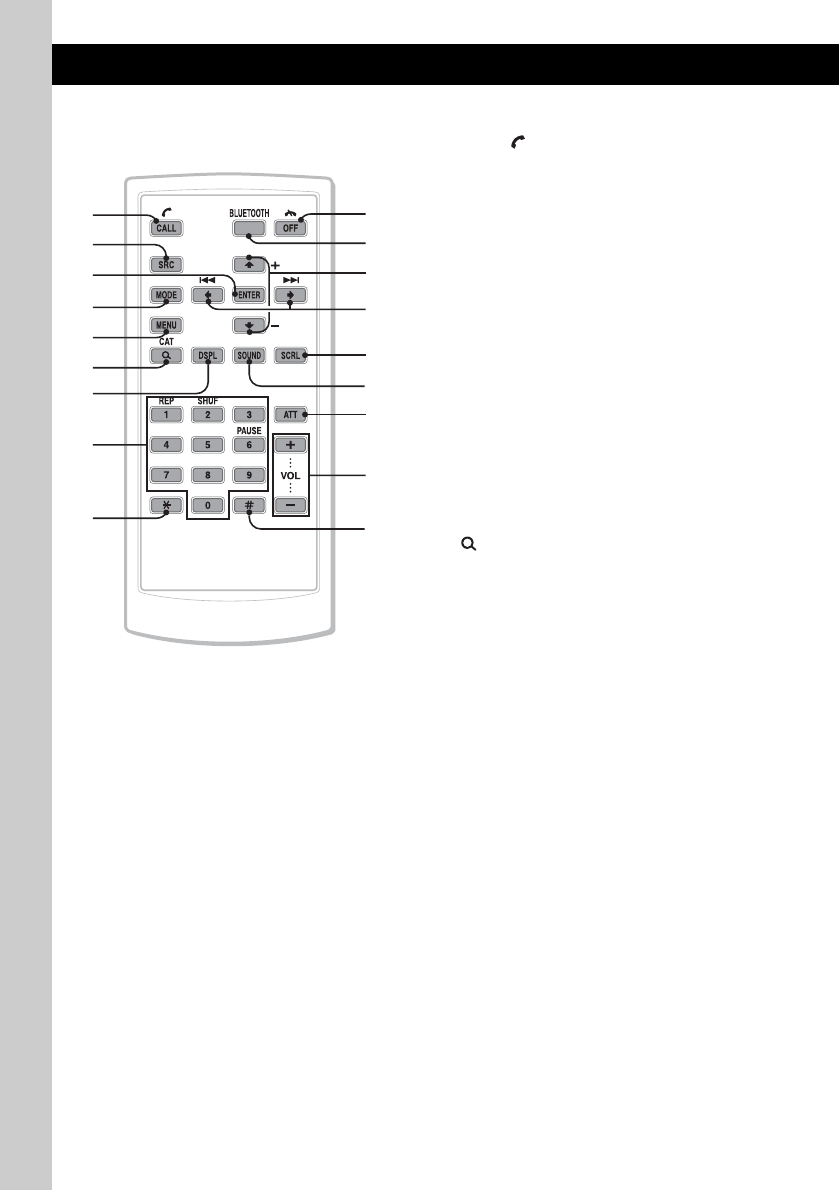
16
RM-X306 Card Remote
Commander
Remove the insulation film before use (page 8).
ACALL/ (handsfree) button
To change the source (Bluetooth Phone).
Bluetooth Phone:
To receive a call.
BSRC (source) button*1
To turn on the power; change the source
(Radio/USB/SensMe™*2/Pandora USB/
Bluetooth Audio/Bluetooth Pandora/
Bluetooth Phone).
CENTER button
To apply a setting.
DMODE button
Press to: Select the radio band (FM/AM)*1/
switch the USB device (internal/external).
Press and hold to: Enter/cancel the passenger
control*3/enter the bookmark mode (Pandora
USB/Bluetooth Pandora).
EMENU button
To enter menu.
F (BROWSE)/CAT*4 button
To list up (Radio); enter the Quick-
BrowZer™ mode (USB); list the station
(Pandora USB/Bluetooth Pandora); list the
phonebook (Bluetooth Phone).
GDSPL (display) button
To change display items.
HNumber buttons
Radio:
(1) to (6):
To receive stored stations (press); store
stations (press and hold).
USB:
(1): REP page 22, 27
(2): SHUF page 22, 28
(6): PAUSE
To pause playback. To cancel, press
again.
Pandora USB:
(6): PAUSE page 29
To pause playback. To cancel, press
again.
Bluetooth Audio*5:
(1): REP page 37
(2): SHUF page 37
(6): PAUSE page 37
To pause playback. To cancel, press
again.
Bluetooth Pandora:
(6): PAUSE page 38
To pause playback. To cancel, press
again.
qd
qs
qf
qh
qj
qg
qk
2
3
4
1
5
6
9
7
8
0
qa

17
Bluetooth Phone:
To input numbers (phone number, etc.).
I button page 34, 35
JOFF/ (end call) button
To turn off the power; stop the source; end or
reject a call.
KBLUETOOTH button page 32
For Bluetooth signal on/off, pairing.
LM (+)/m (–) buttons
The same as pushing the multi-way encoder
up/down on the unit.
M< (.)/, (>) buttons
The same as pushing the multi-way encoder
left/right on the unit.
NSCRL (scroll) button
To scroll the display item.
OSOUND button
To enter sound setting.
PATT (attenuate) button
To attenuate the sound. To cancel, press
again.
QVOL (volume) +/– button
To adjust volume.
R button page 34, 35
*1 If an HD Radio tuner or SAT tuner is
connected:when (SRC) is pressed, the connected
device (“HD,” “XM” or “SR”) will appear in the
display.
Furthermore, if (MODE) is pressed, you can switch
the HD Radio tuner band or SAT tuner band.
*2 When a USB device set up for the SensMe™
function is connected.
*3 When an iPod is connected to the USB (external)
connector.
*4 When the SAT tuner is connected.
*5 When a Bluetooth audio device (supports AVRCP
of Bluetooth technology) is connected. Depending
on the device, certain operations may not be
available.
Note
If the unit is turned off and the display disappears, it
cannot be operated with the card remote commander
unless (SOURCE/OFF) on the unit is pressed to
activate the unit first.

18
Radio
Storing and receiving stations
Caution
When tuning in stations while driving, use Best
Tuning Memory (BTM) to prevent an accident.
Storing automatically — BTM
1Press (SOURCE/OFF) repeatedly until
“TUNER” appears.
To change the band, press (MODE)
repeatedly. You can select from FM1, FM2,
FM3, AM1 or AM2.
2Press and hold the multi-way encoder.
3Rotate the multi-way encoder to select
“BTM,” then press it.
The unit stores stations in order of frequency
in the preset list.
A beep sounds when the setting is stored.
Storing manually
1While receiving the station that you
want to store, press (BROWSE).
The preset list appears.
2Push the multi-way encoder up/down
to select the preset number.
3Press and hold the multi-way encoder
until “MEM” appears.
(with the card remote commander)
1While receiving the station that you
want to store, press and hold a
number button ((1) to (6)) until
“MEM” appears.
Note
If you try to store another station on the same number
button, the previously stored station will be replaced.
Receiving the stored stations
You can list up the frequency.
1Select the band, then press
(BROWSE).
The preset list appears.
2Push the multi-way encoder up/down
to select the desired station.
3Press the multi-way encoder to receive
the station.
The display returns to normal reception
mode.
(with the card remote commander)
1Select the band, then press a number
button ((1) to (6)).
Tuning automatically
1Select the band, then push the multi-
way encoder left/right to search for the
station.
Scanning stops when the unit receives a
station. Repeat this procedure until the
desired station is received.
Tip
If you know the frequency of the station you want to
listen to, push and hold the multi-way encoder left/right
to quickly locate the approximate frequency, then push
the multi-way encoder left/right repeatedly to fine
adjust to the desired frequency (manual tuning).

19
RDS
Overview
FM stations with Radio Data System (RDS)
service send inaudible digital information along
with the regular radio program signal.
Display items
ARadio band
BClock
CPreset number
DFrequency* (Program service name), RDS
data
*While receiving the RDS station, “RDS” is displayed
on the left of the frequency indication.
RDS services
This unit automatically provides RDS services as
follows:
Notes
•Depending on the country/region, not all RDS
functions may be available.
•RDS will not work if the signal strength is too weak,
or if the station you are tuned to is not transmitting
RDS data.
Selecting PTY
1Press (PTY) during FM reception.
The current program type name appears if the
station is transmitting PTY data.
2Rotate the multi-way encoder to select
the desired program type.
3Press the multi-way encoder.
The unit starts to search for a station
broadcasting the selected program type.
Type of programs
Notes
•You cannot use this function in countries/regions
where no PTY data is available.
•You may receive a different radio program from the
one you select.
Setting CT
1Set “CT on” in setup (page 42).
Notes
•The CT function may not work even though an RDS
station is being received.
•There might be a difference between the time set by
the CT function and the actual time.
PTY (Program Types)
Displays the currently received program type.
Also searches your selected program type.
CT (Clock Time)
The CT data from the RDS transmission sets
the clock.
News (News), Information (Information),
Sports (Sports), Talk (Talk), Rock (Rock),
Classic Rock (Classic Rock), Adult Hits
(Adult Hits), Soft Rock (Soft Rock), To p 40
(Top 40), Country (Country), Oldies (Oldies),
Soft (Soft), Nostalgia (Nostalgia), Jazz
(Jazz), Classical (Classical), Rhythm and
Blues (Rhythm and Blues), Soft R&B (Soft
Rhythm and Blues), Foreign Language
(Foreign Language), Religious Music
(Religious Music), Religious Talk (Religious
Talk), Personality (Personality), Public
(Public), College (College), Weather
(Weather)

20
USB devices
For details on the compatibility of your USB
device, visit the support site.
• MSC (Mass Storage Class) type USB devices
compliant with the USB standard can be used.
• Corresponding codec is MP3 (.mp3), WMA
(.wma), AAC (.m4a) and AAC (.mp4).
• Backup of data in a USB device is
recommended.
Notes
•Connect the USB device after starting the engine.
Depending on the USB device, malfunction or
damage may occur if it is connected before starting
the engine.
•Do not place a cellular phone or a device with
wireless communication functions on the TUNE
TRAY, as it may not receive phone signals or
communication may be terminated.
•Do not leave a USB device in a parked car, as
malfunction may result.
Playing back a USB device
A USB device can be connected to the internal/
external or both USB connectors. To switch
between USB devices, press (MODE).
Playing back via the USB (internal)
connector
1Press (OPEN).
The front panel is flipped down.
2Press PUSH OPEN on the TUNE TRAY.
The TUNE TRAY opens slowly.
3Connect the USB device to the USB
connector.
4Slide in the TUNE TRAY by pressing
PUSH CLOSE on the TUNE TRAY until
it locks shut.
5Close the front panel.
6Press (SOURCE/OFF) repeatedly until
“USB” appears, and then press
(MODE) to switch the USB device.
“USB Internal” appears, and playback starts.
If a USB device is already connected, to start
playback, repeat step 6.
Press and hold (SOURCE/OFF) for 1 second to
stop playback.
Removing the USB device
1Stop the USB device playback.
2Press (OPEN).
3Press PUSH OPEN on the TUNE TRAY.
4Remove the USB device.
5Slide in the TUNE TRAY, and close the front
panel.
Support site
http://esupport.sony.com
http://www.sony.com/mobileAV
TUNE TRAY
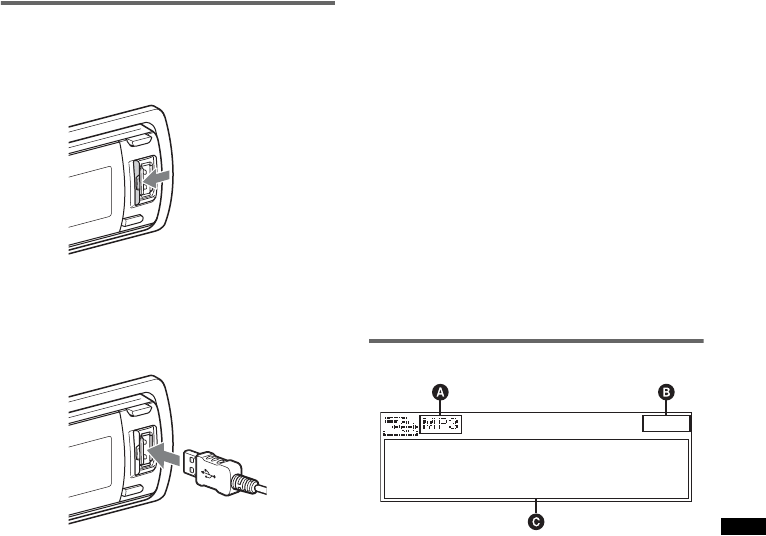
21
Playing back via the USB (external)
connector
1Slide the USB cover.
2Connect the USB device to the USB
connector.
When using a cable, use the one supplied with
the USB device to connect.
3Press (SOURCE/OFF) repeatedly until
“USB” appears, and then press
(MODE) to switch the USB device.
“USB External” appears, and playback starts.
If a USB device is already connected, to start
playback, repeat step 3.
Press and hold (SOURCE/OFF) for 1 second to
stop playback.
Removing the USB device
1Stop the USB device playback.
2Remove the USB device.
Notes for USB devices
•Do not remove the USB device during playback,
otherwise USB data may be damaged.
•Do not place non-USB devices on the TUNE TRAY,
or foreign objects, such as coins, keys, cards,
liquids, etc.
•Do not place a flammable object such as a lighter on
the TUNE TRAY, as this may cause smoke, fire, or
other accident.
•Capacity of the tray: Approx. 65 × 17 × 118 mm
(2 9/16 × 21/32 × 4 5/8 in) (w/h/d)
•If the size of the USB device alone or combined with
the USB cable cannot be placed easily in the TUNE
TRAY, the device may be exceeding the tray
capacity.
Do not slide in the TUNE TRAY or the USB cable
forcefully.
•For “WALKMAN” users, use of the optional adaptor
XA-50WM is recommended. It is designed for use
with this unit (in the TUNE TRAY) only, and should
not be used with the other USB devices.
•This unit cannot recognize USB devices via a USB
hub.
•Slide in the TUNE TRAY and close the front panel
before playback, as damage may result in the case
of an obstruction in the car, etc.
•If the front panel does not fully open because of the
dashboard shape at the installation position, detach
the front panel and open the TUNE TRAY manually.
For how to detach the front panel, see page 8.
•It is extremely dangerous to connect or remove the
USB device while driving.
•Do not use USB devices so large or heavy that they
may fall down due to vibration, or cause a loose
connection.
•If the USB is disconnected during playback, “NO
Device” appears in the display of the unit.
Display items
ASource (MP3/WMA/AAC) indication
BClock
CArtist name/Album name, Track name, Folder
number/Track number/Elapsed playing time
To change display items C, press (DSPL).
Notes
•Displayed items will differ, depending on the USB
device, recorded format and settings. For details,
visit the support site.
•The maximum number of displayable data is as
follows.
– folders (albums): 65,535*
– files (tracks): 5,000
•Do not leave a USB device in a parked car, as
malfunction may result.
•It may take time for playback to begin, depending on
the amount of recorded data.
•DRM (Digital Rights Management) files may not be
played.
•During playback or fast-forward/reverse of a VBR
(Variable Bit Rate) MP3/WMA/AAC file, elapsed
playing time may not display accurately.
•Playback of the following MP3/WMA/AAC files is not
supported.
– lossless compression
– copyright-protected
*The maximum recommended number of folders is
5,000. If the number of folders exceeds 5,000, it may
take a long time to search for folders or files.
The number of folders may not be displayed
correctly beyond 9,999.
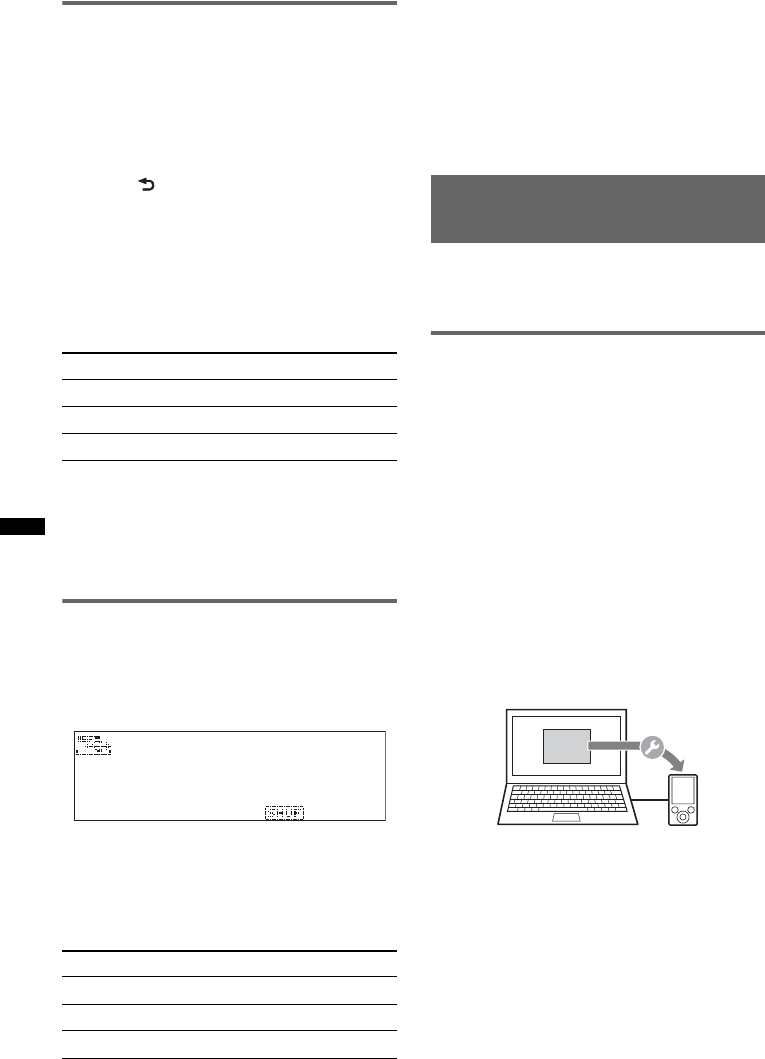
22
Repeat play
1Press and hold the multi-way encoder.
2Rotate the multi-way encoder to select
“Repeat,” then press it.
3Rotate the multi-way encoder to select
the setting, then press it.
The setting is complete.
4Press (BACK).
The setting is complete and the display
returns to normal reception/play mode.
(with the card remote commander)
1During playback, press (1) (REP)
repeatedly until the desired setting
appears.
After 3 seconds, the setting is complete.
*1 Available when selecting track by “Album” or
“Folder & File” with Quick-BrowZer (see page 30).
*2 Available when selecting track by “Artist” with
Quick-BrowZer (see page 30).
To return to normal play mode, select “Repeat
off.”
Shuffle play
1During playback, press and hold
(ZAP/SHUF).
2Press (ZAP/SHUF) repeatedly until the
desired setting appears.
(with the card remote commander)
1During playback, press (2) (SHUF)
repeatedly until the desired setting
appears.
After 3 seconds, the setting is complete.
*1 Available when selecting track by “Album” or
“Folder & File” with Quick-BrowZer (see page 30).
*2 Available when selecting track by “Artist” with
Quick-BrowZer (see page 30).
*3 Available when selecting track by “Track” or “Folder
& File” with Quick-BrowZer (see page 30).
To return to normal play mode, select “off. ”
Note
Playing tracks on shuffle play is selected from a
current USB device.
Enjoying music according to
your mood — SensMe™
Sony’s unique “SensMe™ channels” features
automatically group tracks by channel, and allow
you to enjoy music intuitively.
Before using the SensMe™
function
The following is the basic procedure required to
enjoy the SensMe™ function on the unit.
1Download the “SensMe™ Setup” and
“Content Transfer” software from the
support site
2Install the software in your computer
For more details on the installation, visit
http://esupport.sony.com
or
http://www.sony.com/mobileAV
3Registering a USB device using
“SensMe™ Setup”
Connect a USB device to your computer, and
perform registration using “SensMe™ Setup”
to enable the SensMe™ function on this unit.
Tip
Registration can be performed either along with the
installation procedure or after installation.
Select To play
Repeat Track track repeatedly.
Repeat Album*1album repeatedly.
Repeat Artist*2artist repeatedly.
Select To play
Shuffle Album*1album in random order.
Shuffle Artist*2artist in random order.
Shuffle Device*3device in random order.
SensMe™
Setup
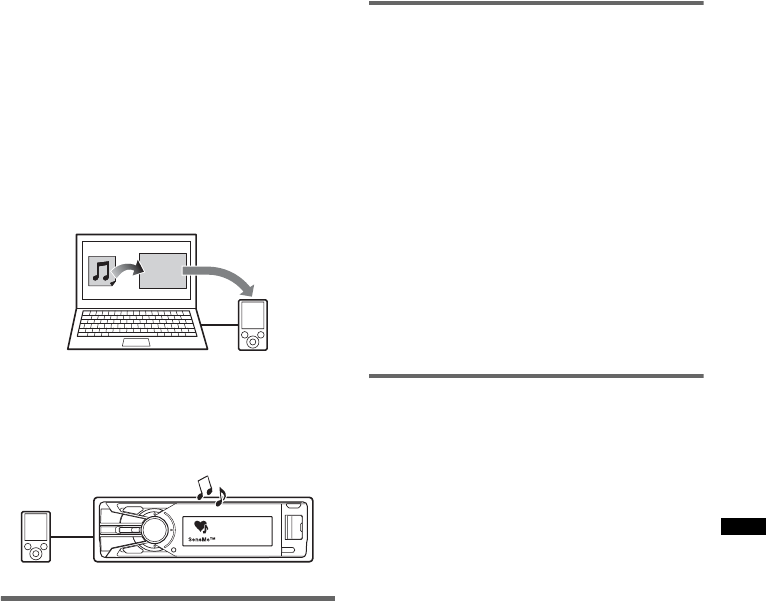
23
4Transferring tracks to the USB device
using “Content Transfer”
In order to group tracks by channel, track
sound patterns need to be analyzed by 12
TONE ANALYSIS™, which is loaded in
“Content Transfer.”
With the USB device connected to your
computer, drag and drop tracks from Windows
Explorer or iTunes, etc., to “Content
Transfer.”
Both analysis and transfer of tracks will be
performed by “Content Transfer.”
5Connecting the USB device and
enjoying the SensMe™ function on the
unit
Connect the set up USB device. You can then
enjoy “SensMe™ channels” on this unit.
Installing “SensMe™ Setup” and
“Content Transfer” in your
computer
The software (“SensMe™ Setup” and “Content
Transfer”) is required to enable the SensMe™
function on this unit.
1Download the “SensMe™ Setup” and
“Content Transfer” software from the
support site.
2Install the software in your computer.
For more details on the installation, visit
http://esupport.sony.com
or
http://www.sony.com/mobileAV
Registering a USB device using
“SensMe™ Setup”
USB device registration is required to enable the
SensMe™ function on the unit.
If registration is not performed along with the
installation procedure, follow the steps below.
1Start “SensMe™ Setup” on your
computer.
2Connect a USB device to your
computer.
3Complete registration following the
on-screen instructions.
Tip
If you connect a registered USB device containing
analyzed tracks, the USB device can be unregistered
again.
Transferring tracks to the USB
device using “Content Transfer”
To enable the SensMe™ function on this unit,
tracks need to be analyzed and transferred to the
registered USB device, using “Content Transfer.”
1Connect the registered USB device to
your computer.
For USB devices, connect with the MSC
mode.
“Content Transfer” starts automatically.
If a message appears, follow the on-screen
instructions to proceed.
2Drag and drop tracks from Windows
Explorer or iTunes, etc., to “Content
Transfer.”
The analysis and transfer of tracks start.
For details on operations, see the Help of
“Content Transfer.”
Note
The track analysis by 12 TONE ANALYSIS™ may take
time, depending on the computer environment.
Content
Transfer

24
Playing tracks in the channel
— SensMe™ channels
“SensMe™ channels” automatically group tracks
into channels by their tunes. You can select and
play a channel that fits your mood, activity, etc.
This function works for USB devices connected
to the internal/external or both USB connector.
To switch the USB device, press (MODE).
1Connect a USB device set up for the
SensMe™ function.
2Press (SensMe™).
The channel list appears, and the most
melodic or rhythmical sections* of tracks are
shuffle played.
*May not be detected correctly.
3Selecting a track from the channel list
using the multi-way encoder.
•Change the channel
Push the multi-way encoder up/down to select
the desired channel.
•Change the track
Push the multi-way encoder left/right until the
desired track appears, then press it.
Playback starts from the beginning of the
current track.
If you do not operate anything for 10 seconds,
the display returns to normal play mode.
Notes
•Depending on the track, it may not be detected
correctly or may be grouped in a channel not suited
to the track’s mood.
•If the connected USB device contains many tracks, it
may take time for “SensMe™ channels” to start, due
to data reading.
Tip
Tracks are played in random order. The order will vary
at each channel selection.
Channel list
xRecommended, Shuffle All
xBasic channels
Plays tracks according to the music type.
xIn-car channels
Plays tracks that are suitable while driving.
“Morning” (5:00 AM – 9:59 AM)
“Daytime” (10:00 AM – 3:59 PM)
“Evening” (4:00 PM – 6:59 PM)
“Night” (7:00 PM – 11:59 PM)
“Midnight” (12:00 AM – 4:59 AM)
Tracks recommended for each time of day.
Set the clock (page 8) for the channel to be
displayed accurately.
“Shuffle All”: Plays all analyzed tracks in
random order.
“Energetic”: High-spirit tracks.
“Relax”: Calm tracks.
“Mellow”: Mellow, melancholy tracks.
“Upbeat”: Happy tracks to improve your
mood.
“Emotional”: Ballad tracks.
“Lounge”: Lounge music.
“Dance”: Rhythm and rap, rhythm and blues
tracks.
“Extreme”: Intense rock tracks.
“Freeway”: Speedy, high-spirit tracks.
“Chillout Drive”: Intoned, healing ballad
tracks.
“Weekend Trip”: Delightful, bright and happy
tracks.
“Midnight Cruise”: Jazz or piano-featured
tracks with mature mood.
“Party Ride”: Up-tempo and alive tracks.
“Morning Commute”: Bright and breezy
tracks.
“Goin’ Home”: Warm and relaxing tracks.
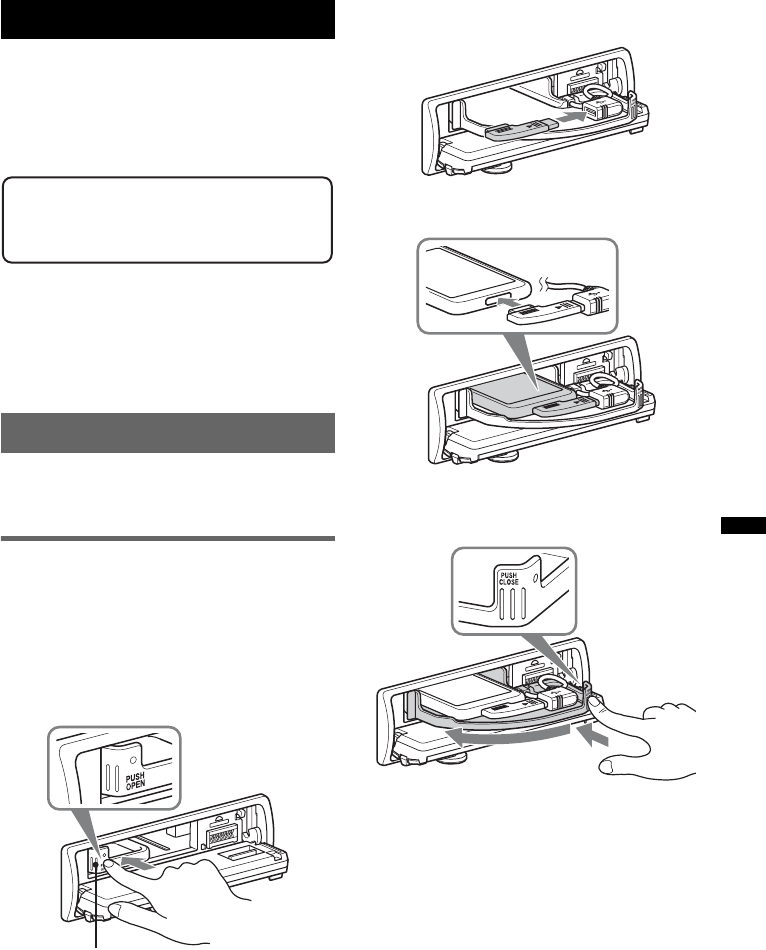
25
iPod
For details on the compatibility of your iPod, see
“About iPod” (page 44) or visit the support site.
In these Operating Instructions, “iPod” is used as
a general reference for the iPod functions on the
iPod and iPhone, unless otherwise specified by
the text or illustrations.
Notes
•Do not place a cellular phone or a device with
wireless communication functions on the TUNE
TRAY, as it may not receive phone signals or
communication may be terminated.
•Do not leave an iPod in a parked car, as malfunction
may result.
Playing back iPod
The iPod can be connected to the internal/
external or both USB connectors. To switch
between USB devices, press (MODE).
Playing back via the USB (internal)
connector
Before connecting the iPod, turn down the
volume of the unit.
1Press (OPEN).
The front panel is flipped down.
2Press PUSH OPEN on the TUNE TRAY.
The TUNE TRAY opens slowly.
3Connect the supplied adaptor to the
USB connector.
4Connect the iPod to the supplied
adaptor.
5Slide in the TUNE TRAY by pressing
PUSH CLOSE on the TUNE TRAY until
it locks shut.
6Close the front panel.
Support site
http://esupport.sony.com
http://www.sony.com/mobileAV
TUNE TRAY
continue to next page t
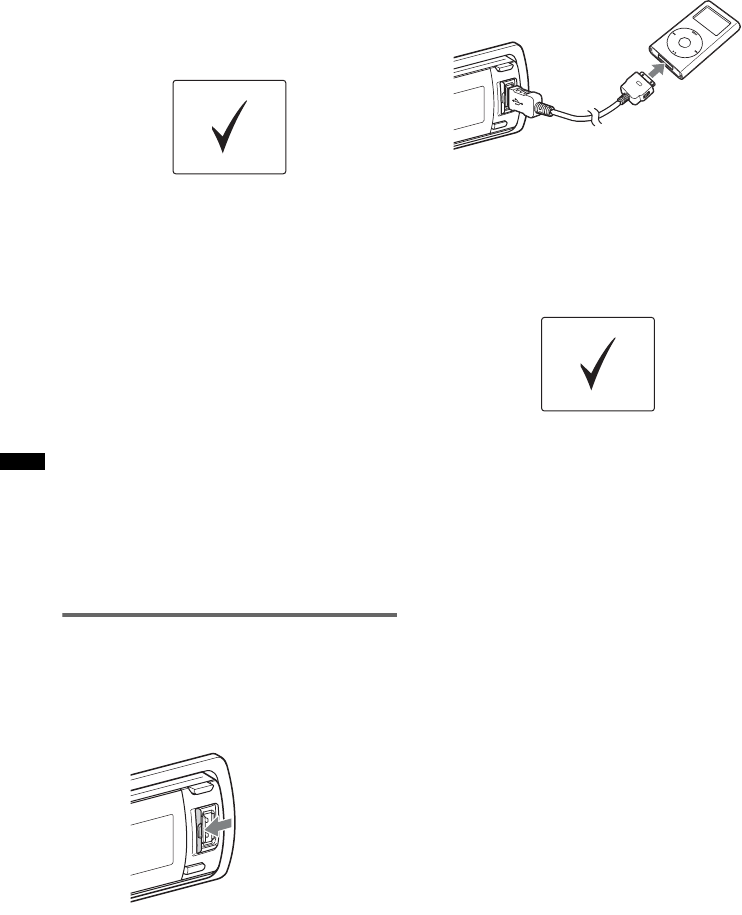
26
7Press (SOURCE/OFF) repeatedly until
“USB” appears, and then press
(MODE) to switch the USB device.
“USB Internal” appears.
The iPod will turn on automatically, and the
display will appear on the iPod screen as
below.*
The tracks on the iPod start playing
automatically from the point last played.
If an iPod is already connected, repeat step 7.
(“iPod” appears in the display when iPod is
recognized.)
*Display differs depending on the iPod, or may not
appear in the case of an iPod touch being
connected.
8Adjust the volume.
Press and hold (SOURCE/OFF) for 1 second to
stop playback.
Removing the iPod
1Stop the iPod playback.
2Press (OPEN).
3Press PUSH OPEN on the TUNE TRAY.
4Remove the iPod.
5Slide in the TUNE TRAY, and close the front
panel.
Playing back via the USB (external)
connector
Before connecting the iPod, turn down the
volume of the unit.
1Slide the USB cover.
2Connect the iPod to the USB
connector via the dock connector to
USB cable.
3Press (SOURCE/OFF) repeatedly until
“USB” appears, and then press
(MODE) to switch the USB device.
“USB External” appears.
The iPod will turn on automatically, and the
display will appear on the iPod screen as
below.*
Tip
We recommend the RC-100IP USB cable (not
supplied) to connect the dock connector.
The tracks on the iPod start playing
automatically from the point last played.
If an iPod is already connected, to start
playback, repeat step 3. (“iPod” appears in
the display when iPod is recognized.)
*In the case of an iPod touch or iPhone being
connected, or that the iPod was last played back
using passenger control, the logo will not appear on
the screen.
4Adjust the volume.
Press and hold (SOURCE/OFF) for 1 second to
stop playback.
Removing the iPod
1Stop the iPod playback.
2Remove the iPod.
Caution for iPhone
When you connect an iPhone via USB, telephone
volume is controlled by iPhone itself. In order to avoid
sudden loud sound after a call, do not increase the
volume on the unit during a telephone call.
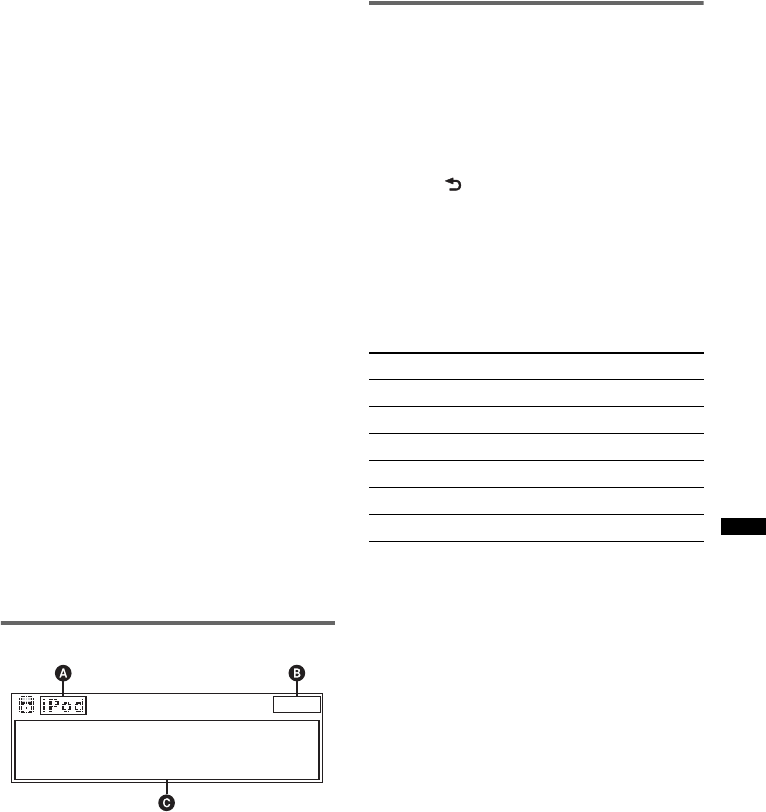
27
Notes
•Do not remove the iPod during playback, otherwise
data may be damaged.
•Do not place non-USB devices on the TUNE TRAY,
or foreign objects, such as coins, keys, cards,
liquids, etc.
•Do not place a flammable object such as a lighter on
the TUNE TRAY, as this may cause smoke, fire, or
other accident.
•For iPod users, use the supplied adaptor XA-50IP. It
is designed for use with this unit (in the TUNE TRAY)
only, and should not be used with the other USB
devices.
•This unit cannot recognize iPod via a USB hub.
•Slide in the TUNE TRAY and close the front panel
before playback, as damage may result in the case
of an obstruction in the car, etc.
•If the front panel does not fully open because of the
dashboard shape at the installation position, detach
the front panel and open the TUNE TRAY manually.
For how to detach the front panel, see page 8.
•It is extremely dangerous to connect or remove the
iPod while driving.
Tips
•When the ignition key is turned to the ACC position,
and the unit is on, the iPod will be recharged.
•If the iPod is disconnected during playback, “NO
Device” appears in the display of the unit.
Resuming mode
When the iPod is connected to the dock
connector, the mode of this unit changes to
resuming mode and playback starts in the mode
set by the iPod.
In Resuming mode, repeat/shuffle play does not
function.
Display items
ASource (iPod) indication
BClock
CArtist name/Album name, Track name,
Album number/Track number/Elapsed
playing time
To change display items C, press (DSPL).
Tip
When album/podcast/genre/artist/playlist is changed,
its item number appears momentarily.
Notes
•Playing tracks in shuffle play is selected from a
current iPod.
•Some letters stored in iPod may not be displayed
correctly.
Repeat play
1Press and hold the multi-way encoder.
2Rotate the multi-way encoder to select
“Repeat,” then press it.
3Rotate the multi-way encoder to select
the setting, then press it.
The setting is complete.
4Press (BACK).
The setting is complete and the display
returns to normal reception/play mode.
(with the card remote commander)
1During playback, press (1) (REP)
repeatedly until the desired setting
appears.
After 3 seconds, the setting is complete.
*1 Available when selecting track by “Album” with
Quick-BrowZer (see page 30).
*2 Available when selecting track by “Podcast” with
Quick-BrowZer (see page 30).
*3 Available when selecting track by “Artist” with
Quick-BrowZer (see page 30).
*4 Available when selecting track by “Playlist” with
Quick-BrowZer (see page 30).
*5 Available when selecting track by “Genre” with
Quick-BrowZer (see page 30).
To return to normal play mode, select “Repeat
off.”
Select To play
Repeat Track track repeatedly.
Repeat Album*1album repeatedly.
Repeat Podcast*2podcast repeatedly.
Repeat Artist*3artist repeatedly.
Repeat Playlist*4playlist repeatedly.
Repeat Genre*5genre repeatedly.
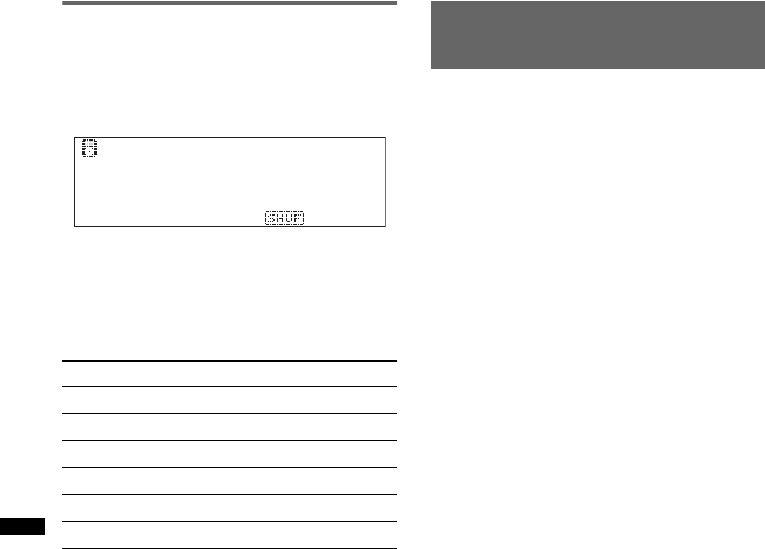
28
Shuffle play
1During playback, press and hold
(ZAP/SHUF).
2Press (ZAP/SHUF) repeatedly until the
desired setting appears.
(with the card remote commander)
1During playback, press (2) (SHUF)
repeatedly until the desired setting
appears.
After 3 seconds, the setting is complete.
*1 Available when selecting track by “Album” with
Quick-BrowZer (see page 30).
*2 Available when selecting track by “Podcast” with
Quick-BrowZer (see page 30).
*3 Available when selecting track by “Artist” with
Quick-BrowZer (see page 30).
*4 Available when selecting track by “Playlist” with
Quick-BrowZer (see page 30).
*5 Available when selecting track by “Genre” with
Quick-BrowZer (see page 30).
*6 Available when selecting track by “Track” with
Quick-BrowZer (see page 30).
To return to normal play mode, select “off.”
Operating an iPod directly
— Passenger control
You can operate an iPod connected to the dock
connector directly. This function works when the
iPod is connected to the USB (external)
connector only.
1During playback, press and hold
(MODE).
“Mode iPod” appears and you will be able to
operate the iPod directly.
To exit the passenger control
Press and hold (MODE).
Then “Mode Audio” will appear and the play
mode will change to “Resuming.”
Notes
•The volume can be adjusted only by the unit.
•If this mode is canceled, the repeat setting will be
turned off.
Select To play
Shuffle Album*1album in random order.
Shuffle Podcast*2podcast in random order.
Shuffle Artist*3artist in random order.
Shuffle Playlist*4playlist in random order.
Shuffle Genre*5genre in random order.
Shuffle Device*6device in random order.

29
Pandora® via USB (iPhone)
Pandora Radio is a FREE personalized radio
service, now available to stream music through
your iPhone.
Simply start with the name of one of your
favorite artists, songs or classical composers and
Pandora will create a “station” that plays their
music and other music like it.
You can control Pandora on a USB-connected
iPhone from this unit.
Download the latest version of Pandora and
obtain more information from www.pandora.com
For details on usable devices, visit the following
support site.
Notes
•Do not place a cellular phone or a device with
wireless communication functions on the TUNE
TRAY, as it may not receive phone signals or
communication may be terminated.
•Certain Pandora service functions may not be
available.
•Pandora’s service is currently only available in the
U.S.
Playing back Pandora
Playing back via the USB (external)
connector
Before connecting the iPhone, turn down the
volume of the unit.
1Slide the USB cover.
2Connect the iPhone to the USB
connector via the dock connector to
USB cable.
3Press (SOURCE/OFF) repeatedly until
“Pandora USB” appears, and then
press (MODE) to switch the USB
device.
“Pandora USB EXT” and “Please launch
Pandora Application on mobile device.”
appear.
4Launch Pandora on the iPhone.
5Adjust the volume on this unit.
To pause playback
Press (PAUSE). To cancel, press again.
To skip a song
Push the multi-way encoder right.
Notes
•You cannot skip back to the previous song.
•Pandora limits the number of skips allowed.
“Thumbs” feedback
The “Thumbs Up” or “Thumbs Down” feedback
allows you to personalize stations to suit your
preference.
Thumbs Up
During playback, push and hold the multi-way
encoder up for 1 second.
Thumbs Down
During playback, push and hold the multi-way
encoder down for 1 second.
Note
Under certain circumstances, “Thumbs” feedback may
be unavailable, and “Cannot Thumbs Up/Down” will be
displayed.
Support site
http://esupport.sony.com
http://www.sony.com/mobileAV

30
Station list
The station list allows you to easily select a
desired station.
1During playback, press (BROWSE).
Pandora stations on your list appear.
2Push the multi-way encoder right to
select the sorting order: “Date” or “A-
Z.”
“Date” sorts stations by the date they were
added to the account, and “A-Z” sorts station
names in alphabetical order.
3Rotate the multi-way encoder to select
the desired station, then press it.
Playback starts.
ACurrent sort order
BCurrent station
CShared Icon
QuickMix
QuickMix allows you to listen to songs played on
one or more Pandora stations in your station list
randomly.
Edit your QuickMix station selections on the
device before connection.
Bookmarking
The song or artist currently being played can be
bookmarked and stored in your Pandora account.
1During playback, press and hold
(MODE) until “Bookmark” appears.
2Rotate the multi-way encoder to select
“Song” or “Artist”, then press it.
The bookmark is stored, and the system
returns to the previous display.
Note
Under certain circumstances, bookmark store may fail,
and “Bookmark Error” will be displayed. In this case,
try to bookmark again later.
Searching for a track
Searching a track by name
— Quick-BrowZer™
You can search for a track in a USB device easily
by category.
1Press (BROWSE).
The unit enters the Quick-BrowZer mode,
and the list of search categories appears.
2Rotate the multi-way encoder to select
the desired search category, then
press it to confirm.
3Repeat step 2 until the desired track is
selected.
Playback starts.
To return to the previous display
Press (BACK).
To exit the Quick-BrowZer mode
Press (BROWSE).
Note
When entering the Quick-BrowZer mode, the repeat/
shuffle setting is canceled.
Searching by skip items
— Jump mode
When many items are in a category, you can
search for a desired item quickly.
1Push the multi-way encoder right in
Quick-BrowZer mode.
The following display appears.
ACurrent item number
BTotal item number in the current layer
CItem name
Then the item name will appear.
2Rotate the multi-way encoder until the
desired item or one near the desired
item appears.
It skips in steps of 10% of the total item
number.
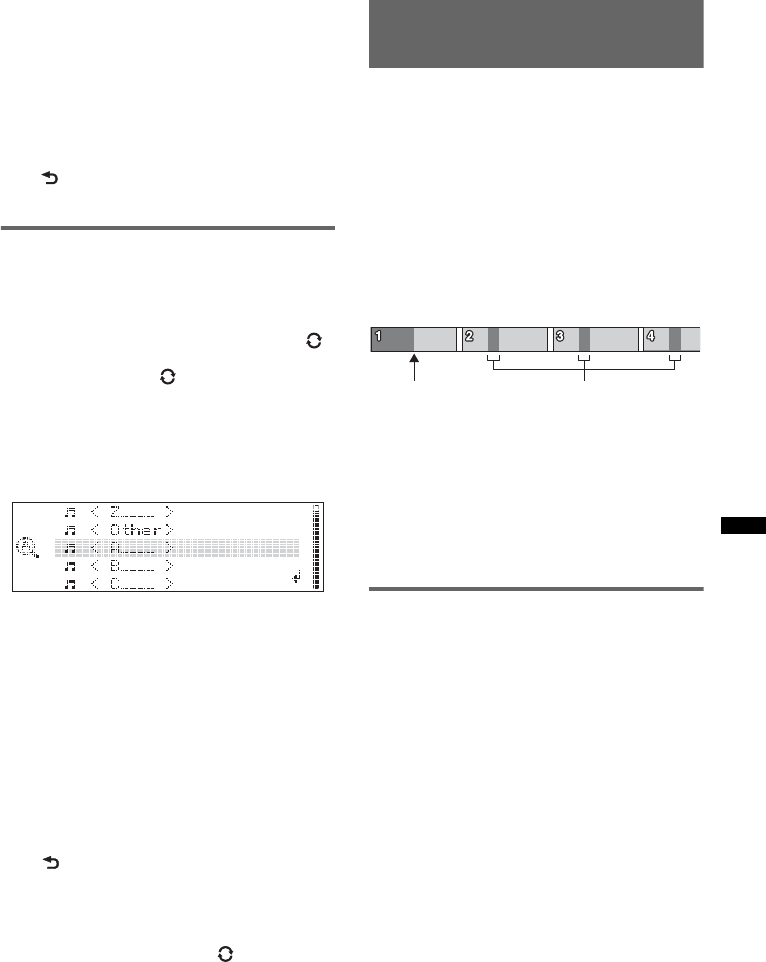
31
3Press the multi-way encoder.
The display returns to the Quick-BrowZer
mode and the selected item appears.
4Push the multi-way encoder up/down
to select the desired item, then press
it.
Playback starts if the selected item is a track.
To cancel Jump mode
Press (BACK) or push the multi-way encoder
left. A list of the search categories appears.
Searching by alphabetical order
— Alphabet search
When an iPod or USB device containing song
information is connected to the unit, you can
search for a desired item by alphabetical order.
While this unit is reading song information, “ ”
appears on the display. You can use the Alphabet
search function when “ ” disappears. For a
USB device, the maximum number of searchable
files (tracks) is 5,000.
1Push the multi-way encoder right in
Quick-BrowZer mode.
An alphabet list appears.
2Rotate the multi-way encoder to select
the first letter of the desired item, then
press it.
A list of items in the selected category
appears in alphabetical order.
If there is no song beginning with the desired
letter, “Not Found” appears.
3Push the multi-way encoder up/down
to select the desired item, then press
it.
Playback starts if the selected item is a track.
To cancel Alphabet search
Press (BACK) or push the multi-way encoder
left. A list of the search categories appears.
Notes
•For a USB device, it may take time to read song
information after connecting to the unit.
While reading song information, “ ” appears in the
top left of the display.
•Only the song information of the USB device last
connected can be stored.
•If replacing the car battery, changing connections or
resetting the unit, the stored song information will be
erased.
Searching a track by listening
to track passages — ZAPPIN™
While playing back short track passages in a
USB device in sequence, you can search for a
track you want to listen to.
ZAPPIN mode is suitable for searching for a
track in shuffle or shuffle repeat mode.
1Press (ZAP/SHUF) during playback.
After “ZAPPIN” appears in the display,
playback starts from a passage of the next
track.
The passage is played for the set time, then a
click sounds and the next passage starts.
2Press the multi-way encoder or
(ZAP/SHUF) when a track you want to
listen is played back.
The track that you select returns to normal
play mode from the beginning.
To search a track by ZAPPIN mode again,
repeat steps 1 and 2.
In the case of “SensMe™
channels” playback
If the track being searched is transferred by
“Content Transfer,” the most melodic or
rhythmical sections* of tracks are played. For
details on the SensMe™ function, see page 22.
*May not be detected correctly.
Tips
•You can select the playback time from about 6
seconds/15 seconds/30 seconds (page 43). You
cannot select the passage of the track to playback.
•Push the multi-way encoder left/right in ZAPPIN
mode to skip a track.
•Push the multi-way encoder up/down in ZAPPIN
mode to skip album.
The part of each track to
playback in ZAPPIN mode.
Track
(ZAP/SHUF)
pressed.
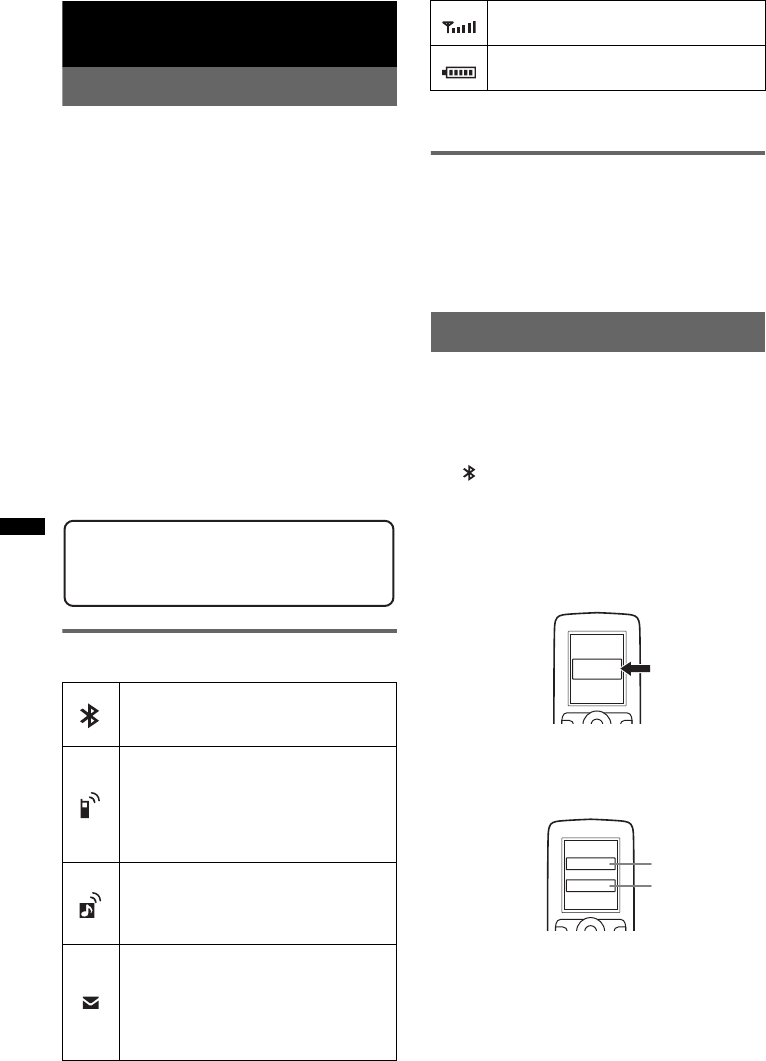
32
Bluetooth (Handsfree calling
and Music streaming)
Bluetooth Operations
To use the Bluetooth function, the following
procedure is necessary.
1Pairing
When connecting Bluetooth devices for the
first time, mutual registration is required. This
is called “pairing.” This registration (pairing)
is required only for the first time, as this unit
and other devices will recognize each other
automatically from the next time. You can
pair with up to 9 devices.
2Connecting
After pairing is made, connect this unit and
the Bluetooth device. Depending on the
device, connection automatically made along
with the pairing.
3Handsfree calling/Music streaming
You can make/receive a handsfree call, or
listen to audio through this unit.
For details of usable devices, visit the following
support site.
About Bluetooth icons
The following icons are used by this unit.
*Turns gray without handsfree connection. Differs in
the case of a cellular phone.
Installing the microphone
To capture your voice during handsfree calling,
you need to install the microphone (supplied).
For details on how to connect the microphone,
refer to the supplied “Installation/Connections”
guide.
Pairing
First, register (“pair”) a Bluetooth device
(cellular phone, etc.) and this unit with each
other. You can pair up to 9 devices. Once pairing
is established, there is no need for pairing again.
1Press and hold (BLUETOOTH).
“ ” flashes (pairing is in standby mode).
2Set the Bluetooth device to search for
this unit.
A list of detected devices appears in the
display of the device to be connected. This
unit is displayed as “Sony Automotive” on
the device to be connected.
3If passkey* input is required on the
display of the device to be connected,
input “0000.”
This unit and the Bluetooth device memorize
each other’s information, and when pairing is
made, this unit is ready for connection to the
device.
Lit:
Flashing:
None:
Bluetooth signal is on.
Pairing is in standby mode.
Bluetooth signal is off.
Lit:
Flashing:
None:
Connected to a cellular
phone.
Connection is in progress.
No cellular phone is
connected for handsfree
calling.
Lit:
Flashing:
None:
Connected to a device.
Connection is in progress.
No device is connected for
music streaming.
Lit:
Flashing:
None:
Some unread SMS
messages exist.
A new SMS message has
been received.
No unread SMS messages
exist.
Support site
http://esupport.sony.com
http://www.sony.com/mobileAV
Signal strength status of
connected cellular phone.*
Remaining battery status of
connected cellular phone.*
XXXXXXX
DR-BT30Q
Sony
Automotive
XXXX
Input passkey.
“0000”
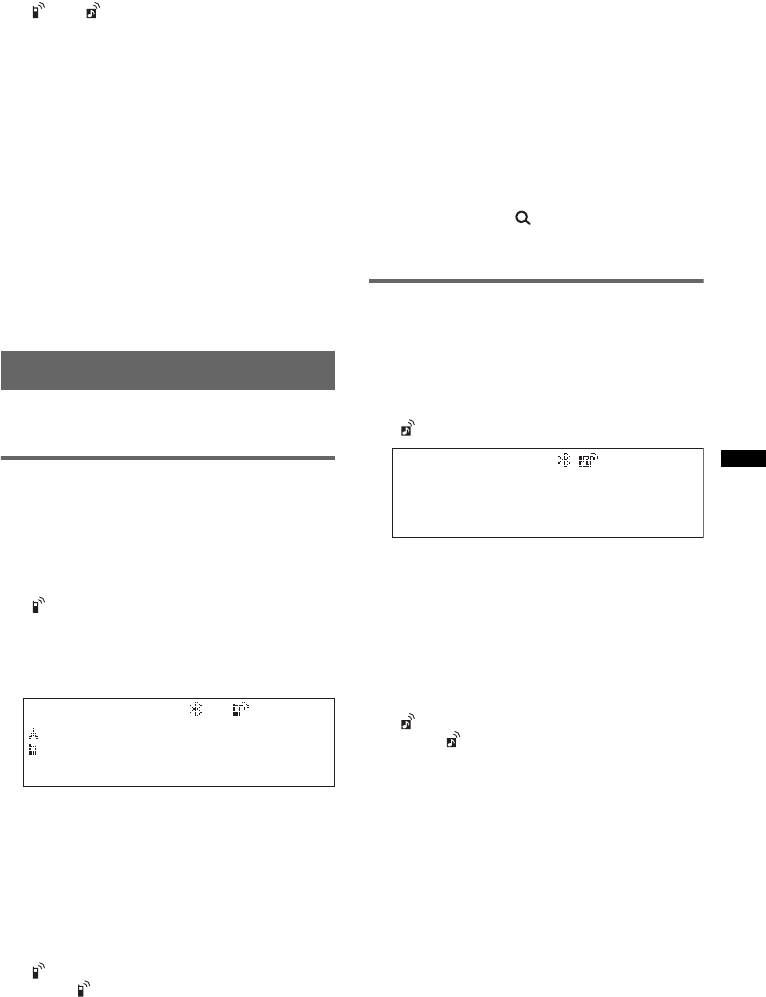
33
4Set the Bluetooth device to connect to
this unit.
“Connection Complete” appears and
connection is complete.
“ ” or “ ” appears when the connection is
made.
*Passkey may be called “passcode,” “PIN code,” “PIN
number” or “password,” etc., depending on the
device. If the device supports Bluetooth version 2.1,
passkey input is not required.
Notes
•While connecting to a Bluetooth device, this unit
cannot be detected from another device. To enable
detection, enter the pairing mode and search for this
unit from another device.
•It may take time to search or connect.
•Depending on the device, the confirmation display of
the connection appears before inputting the
passkey.
•The time limit for inputting the passkey differs
depending on the device.
•This unit cannot be connected to a device that
supports only HSP (Head Set Profile).
Connecting
If pairing has already been achieved, start
operation from here.
Connecting a cellular phone
1Be sure that both this unit and the
cellular phone are switched to
Bluetooth signal on.
2Connect to this unit using the cellular
phone.
“ ” appears when the connection is made. If
you select the Bluetooth Phone source after
the connection is made, the network name
and the connected cellular phone name also
appear in the display.
Connecting to the cellular phone
last-connected from this unit
1Be sure that both this unit and the cellular
phone are switched to Bluetooth signal on.
2Press (SOURCE/OFF) repeatedly until
“Bluetooth Phone” appears.
3Press the multi-way encoder.
“ ” flashes while the connection is being
made. “ ” stays lit when the connection is
made.
Notes
•Some cellular phones require permission to access
their phonebook data during handsfree connection
to this unit. Obtain permission via the cellular phone.
•While streaming Bluetooth audio, you cannot
connect from this unit to the cellular phone. Connect
from the cellular phone to this unit instead. A
connecting noise may be heard over playback
sound.
Tips
•With Bluetooth signal on: when the ignition is
switched to on, this unit reconnects automatically to
the last-connected cellular phone. But automatic
connection also depends on the cellular phone’s
specification. If this unit does not reconnect
automatically, connect manually.
•You can also select the Bluetooth Phone source by
pressing and holding (BROWSE) on this unit for
2 or more seconds, or pressing (CALL) on the card
remote commander.
Connecting an audio device
1Be sure that both this unit and the
audio device are switched to
Bluetooth signal on.
2Connect to this unit using the audio
device.
“ ” appears when the connection is made.
Connecting to the audio device last-
connected from this unit
1Be sure that both this unit and the audio device
are switched to Bluetooth signal on.
2Press (SOURCE/OFF) repeatedly until
“Bluetooth Audio” appears.
3Press (PAUSE).
“ ” flashes while the connection is being
made. “ ” stays lit when the connection is
made.

34
Handsfree calling
Once the unit is connected to the cellular phone,
you can make/receive handsfree calls by
operating this unit.
Making calls
Calling from the phonebook
You need to make sure the appropriate
phonebook has been selected. For details on how
to select a phonebook, see “Selecting a
phonebook” (page 35).
1Press (SOURCE/OFF) repeatedly until
“Bluetooth Phone” appears.
2Press (BROWSE).
The phonebook appears.
3Rotate the multi-way encoder to select an
initial from the initial list, then press it.
4Rotate the multi-way encoder to select a name
from the name list, then press it.
5Rotate the multi-way encoder to select a
number from the number list, then press it.
The phone call starts.
Calling from the call history
1Press (SOURCE/OFF) repeatedly until
“Bluetooth Phone” appears.
2Press and hold (BROWSE) for 2 or more
seconds.
A list of the call history appears.
3Rotate the multi-way encoder to select a name
and phone number from the call history, then
press it.
The phone call starts.
Note
You can call from the call history (up to 20).
Calling by direct phone number input
You can call by direct phone number input using
only the card remote commander.
1Press (CALL) on the card remote commander
to select the Bluetooth Phone source.
2Press the number buttons (0-9, or ) on the
card remote commander to enter the phone
number.
3Press (ENTER) on the card remote
commander.
The phone call starts.
To input “+,” press and hold the 0 button on the
card remote commander.
Calling by preset number
You can store up to 6 contacts in the preset dial.
For details on how to store, see “Preset dial”
(page 36).
1Press (SOURCE/OFF) repeatedly until
“Bluetooth Phone” appears.
2Push the multi-way encoder up/down to select
the contact you want to call, then press it.
The phone call starts.
To end a call
Press the multi-way encoder again, or
(SOURCE/OFF).
Note
Even if the call is ended, the Bluetooth connection is
not canceled.
Calling by redial
1Press (SOURCE/OFF) repeatedly until
“Bluetooth Phone” appears.
2Press and hold the multi-way encoder for 2 or
more seconds.
The phone call starts.
Receiving calls
When receiving a call, a ringtone is output from
your car speakers. The name and the phone
number appear in the display.
1Press the multi-way encoder when a
call is received with a ringtone.
The phone call starts.
Note
Only the phone number may appear, depending on
the cellular phone.
Auto Answer setting
You can select an auto answer setting from “off,”
“Short” or “Long” (page 43).
Ringtone setting
You can switch the ringtone from “Default” or
“Cellular” (page 43).
*Depending on the cellular phone, this unit’s ringtone
may be output even if set to “Cellular.”
To reject a call
Press (SOURCE/OFF).
Operations during a call
Presetting the volume of the ringtone
and talker’s voice
You can preset the volume level of the ringtone
and talker’s voice.

35
To adjust the ringtone volume:
Rotate the multi-way encoder while receiving a
call. “Ring Volume” appears and ringtone
volume can be adjusted.
To adjust the talker’s voice volume:
Rotate the multi-way encoder during a call. “Talk
Volume” appears and the talker’s voice volume
can be adjusted.
Note
If the Bluetooth Phone source is selected, rotating the
multi-way encoder will only adjust the talker’s volume.
EC/NC Mode (Echo Canceller/Noise
Canceller Mode)
You can reduce echo and noise.
Push the multi-way encoder left/right to set to
“EC/NC Mode 1” or “EC/NC Mode 2.”
Note
Configurable during a call.
Sending DTMF (Dual Tone Multiple
Frequency) tones
You can send DTMF tones.
Press the required number buttons (0 – 9, or
) on the card remote commander to send
DTMF tones.
MIC Gain adjustment
You can adjust the volume for other party.
Push the multi-way encoder up/down to adjust
the volume levels (“MIC Gain LOW,” “MIC
Gain MID,” “MIC Gain HI”).
Note
Configurable during a call.
Call transfer
To activate/deactivate the appropriate device (this
unit/cellular phone), check the following.
1Press (MODE) or use your cellular
phone.
For details on cellular phone operation, refer to
your cellular phone manual.
Note
Depending on the cellular phone, handsfree
connection may be cut off when call transfer is
attempted.
Phonebook management
Notes on phonebook data
•Prior to disposal or changing ownership of your car
with this unit still installed, be sure to press the
RESET button to erase all the phonebook data in
this unit to prevent possible unauthorized access.
Disconnecting the power supply lead will also erase
all the phonebook data.
•Downloaded phonebook data from a cellular phone
cannot be overwritten by subsequent data. However,
some data (name, etc.,) may be duplicated as a
result.
•If you press the RESET button, the stored
phonebook data will be erased.
•Phonebook data may be lost if this unit is damaged.
•When disposing of this unit, phonebook data should
be deleted with “BT Initialize” (page 37).
•Up to 500 contacts can be stored in the phonebook.
If you try to register more than 500 contacts,
“Memory Full” appears.
Selecting a phonebook
Before making a call, make sure the appropriate
phonebook has been selected: cellular phone or
this unit.
If you select “Cellular,” you can access the
phonebook in a cellular phone via this unit*.
*If the cellular phone does not support PBAP, the
phonebook in the cellular phone cannot be selected.
1Press and hold (SOURCE/OFF) for 1 second.
2Press and hold the multi-way encoder.
3Rotate the multi-way encoder until
“PhoneBook Select” appears, then press it.
4Rotate the multi-way encoder to select
“Cellular” or “Head Unit,” then press it.
5Press (BACK).
Receiving phonebook data from a
cellular phone
1Press (SOURCE/OFF) repeatedly until
“Bluetooth Phone” appears.
2Press (BROWSE).
The phonebook appears.
3Rotate the multi-way encoder to select “Add
Contact,” then press it.
“Waiting…” appears.
4Send the phonebook data by operating the
cellular phone.
“Data Receiving…” appears while receiving
the phonebook data.
“Complete” appears when the phonebook data
is stored on this unit.
Notes
•When connecting to this unit, depending on the
cellular phone, you may be asked to give this unit
permission to access the phonebook in the cellular
phone. Permission is required from the cellular
phone.
continue to next page t
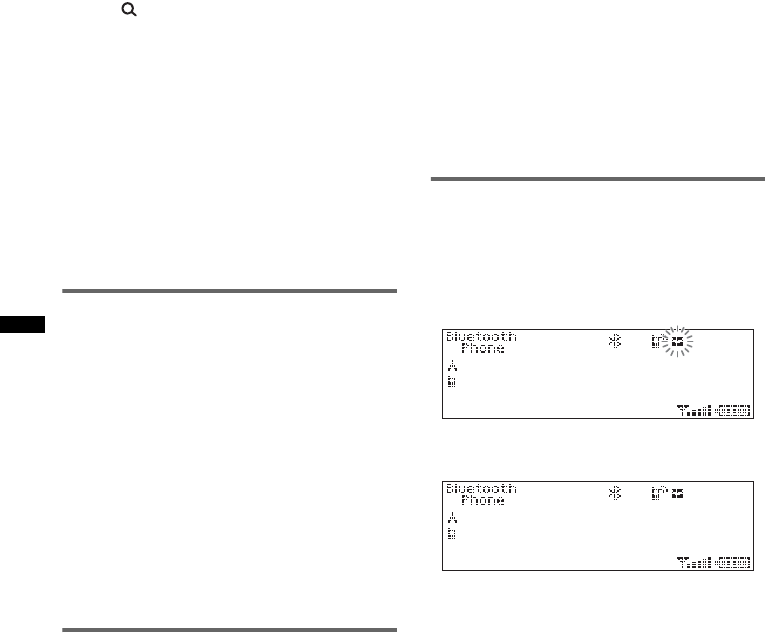
36
•Before receiving phonebook data, disconnect any
cellular phone or audio device.
•To cancel the transfer of phonebook data, operate
the cellular phone.
•If the power supply lead is disconnected, the stored
phonebook data will be erased.
Deleting from the phonebook in this
unit
1Press (SOURCE/OFF) repeatedly until
“Bluetooth Phone” appears.
2Press (BROWSE).
The phonebook appears.
3Rotate the multi-way encoder to select an
initial from the initial list, then press it.
4Rotate the multi-way encoder to select a name
from the name list, then press it.
5Rotate the multi-way encoder to select “Delete
Contact” from the number list, then press it.
6Rotate the multi-way encoder to select “Yes,”
then press it.
To clear all phonebook data, select “Delete All”
in step 3. After clearing, confirm that all
phonebook data has been cleared properly.
Preset dial
Contacts (up to 6) of the phonebook in a cellular
phone can be stored in the preset dial.
1Press (SOURCE/OFF) repeatedly until
“Bluetooth Phone” appears.
2Push the multi-way encoder up/down
to select the preset number
(“Preset 1” to “Preset 6”) to store.
3Push the multi-way encoder right to
enter storing mode.
“Waiting…” appears.
4Send the phonebook data by
operating the cellular phone.
The contact is stored in the selected preset
number.
Voice dial activation
You can activate voice dialing with a cellular
phone connected to this unit by saying the voice
tag stored on the cellular phone, then make a call.
1Press (SOURCE/OFF) repeatedly until
“Bluetooth Phone” appears.
2Press the multi-way encoder.
“Please say the name…” appears.
3Say the voice tag stored on the cellular
phone.
Your voice is recognized, and the call is
made.
Notes
•Check that unit and cellular phone are connected
beforehand.
•Store a voice tag on your cellular phone beforehand.
•If you activate voice dialing with a cellular phone
connected to this unit, this function may not work in
some cases.
•Noises such as the engine running may interfere
with sound recognition. In order to improve
recognition, operate under conditions where noise is
minimized.
•Voice dialing may not work in some situations,
depending on the effectiveness of the cellular
phone’s recognition function. For details, see the
support site.
•Do not use voice dialing on the cellular phone during
handsfree device connection.
Tips
•Speak in the same way as you did when you stored
the voice tag.
•Store a voice tag while seated in the car, via this unit
with Bluetooth Phone source selected.
SMS indicator
While connecting a cellular phone to this unit,
the SMS indicator informs you of any incoming
or unread SMS messages.
If you receive a new SMS message, the SMS
indicator flashes.
If there are any unread SMS messages, the SMS
indicator stays lit.
Note
Function of the SMS indicator may depend on the
cellular phone.

37
Music streaming
Listening to music from an audio
device
You can listen to music of an audio device on this
unit if the audio device supports A2DP
(Advanced Audio Distribution Profile) of
Bluetooth technology.
1Connect this unit and the Bluetooth
audio device (page 33).
“ ” appears during connection.
2Turn down the volume on this unit.
3Press (SOURCE/OFF) repeatedly until
“Bluetooth Audio” appears.
4Operate the audio device to start
playback.
5Adjust the volume on this unit.
Adjusting the volume level
The volume level is adjustable for any difference
between the unit and the Bluetooth audio device.
1Start playback of the Bluetooth audio device at
a moderate volume.
2Set your usual listening volume on the unit.
3Press the multi-way encoder.
4Rotate the multi-way encoder until “Bluetooth
Audio Level” appears, then press it.
5Rotate the multi-way encoder to adjust the
input level (“+ 18dB” – “0dB” – “– 8dB”).
Operating an audio device with this
unit
You can perform the following operations on this
unit if the audio device supports AVRCP (Audio
Video Remote Control Profile) of Bluetooth
technology. (The operation differs depending on
the audio device.)
*1 Depending on the device, it may be necessary to
press twice.
*2 Press repeatedly until the desired setting appears.
*3 You can also shuffle play by pressing and holding
(ZAP/SHUF) on this unit.
Operations other than the above should be
performed on the audio device.
Notes
•Depending on the audio device, its information, such
as title, track number/time, playback status, etc.,
may not be displayed on this unit. The information is
displayed during Bluetooth Audio playback only.
•Even if the source is changed on this unit, playback
of the audio device does not stop.
Tip
You can connect a cellular phone that supports A2DP
(Advanced Audio Distribution Profile) as an audio
device and listen to music.
Other settings
Initializing Bluetooth Settings
You can initialize all the Bluetooth-related
settings from this unit.
1Press and hold the multi-way encoder.
The menu list appears.
2Rotate the multi-way encoder to select
“BT Initialize,” then press it.
The confirmation appears.
3Rotate the multi-way encoder to select
“Yes.”
“Initializing...” appears while initializing the
Bluetooth settings.
4Press (BACK).
The display returns to normal reception/play
mode.
Note
When disposing of this unit, phonebook data should
be deleted with “BT Initialize.”
To Do this
Play Press (PAUSE).*1
Pause Press (PAUSE).*1
Skip tracks Push the multi-way encoder
left/right [once for each track].
Reverse/
Fastforward Push and hold the multi-way
encoder left/right.
Repeat play Press (REP) on the card
remote commander.*2
Shuffle play Press (SHUF) on the card
remote commander.*2*3
Skip albums Push the multi-way encoder up/
down.
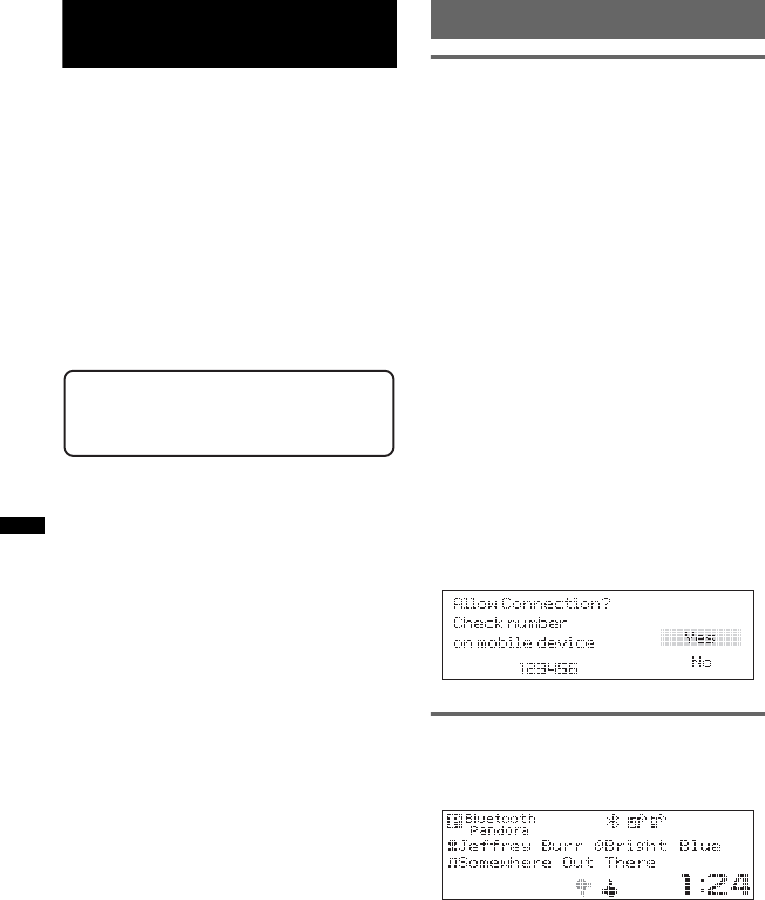
38
Pandora via Bluetooth (Android™
& BlackBerry® phones)
Pandora Radio is a FREE personalized radio
service, now available to stream music through
your Android and BlackBerry phone.
Simply start with the name of one of your
favorite artists, songs or classical composers and
Pandora will create a “station“ that plays their
music and other music like it.
You can control Pandora on Bluetooth-connected
Android and BlackBerry phones that have the
latest version of Pandora installed from this unit.
Download the latest version of Pandora and
obtain more information from www.pandora.com
For details of usable devices, visit the following
support site.
Notes
•Do not place a cellular phone or a device with
wireless communication functions on the TUNE
TRAY, as it may not receive phone signals or
communication may be terminated.
•Certain Pandora service functions may not be
available.
•You cannot control Pandora on smartphones other
than Android and BlackBerry phones.
•Pandora’s service is currently only available in the
U.S.
To use the Bluetooth function, the following
procedure is necessary.
1Pairing
When connecting Bluetooth devices for the
first time, mutual registration is required. This
is called “pairing.” This registration (pairing)
is required only for the first time, as this unit
and other devices will recognize each other
automatically from the next time. You can
pair with up to 9 devices.
2Connecting
After pairing is made, connect this unit and
the Bluetooth device. Depending on the
device, connection automatically made along
with the pairing.
3Playing back Pandora
You can listen to Pandora internet radio
through this unit.
Playing back Pandora
Playing back via Bluetooth
1Connect this unit and the Bluetooth
device (page 33).
2Turn down the volume on this unit.
3Press (SOURCE/OFF) repeatedly until
“Please launch Pandora App on
mobile device and press (PAUSE) on
this unit.” appears.
4Launch Pandora on the Bluetooth
device.
5Press (PAUSE) on this unit.*1
6Adjust the volume on this unit.
To pause playback
Press (PAUSE). To cancel, press again.
To skip a song
Push the multi-way encoder right.
Notes
•You cannot skip back to the previous song.
•Pandora limits the number of skips allowed.
*1 When the mobile device is connected, the following
message may appear. Make sure that the number
of the device is displayed (e.g., 123456), and then
select “Yes” on both the device and the unit.
“Thumbs” feedback
The “Thumbs Up” or “Thumbs Down” feedback
allows you to personalize stations to suit your
preference.
Thumbs Up
During playback, push and hold the multi-way
encoder up for 1 second.
Thumbs Down
During playback, push and hold the multi-way
encoder down for 1 second.
Support site
http://esupport.sony.com
http://www.sony.com/mobileAV
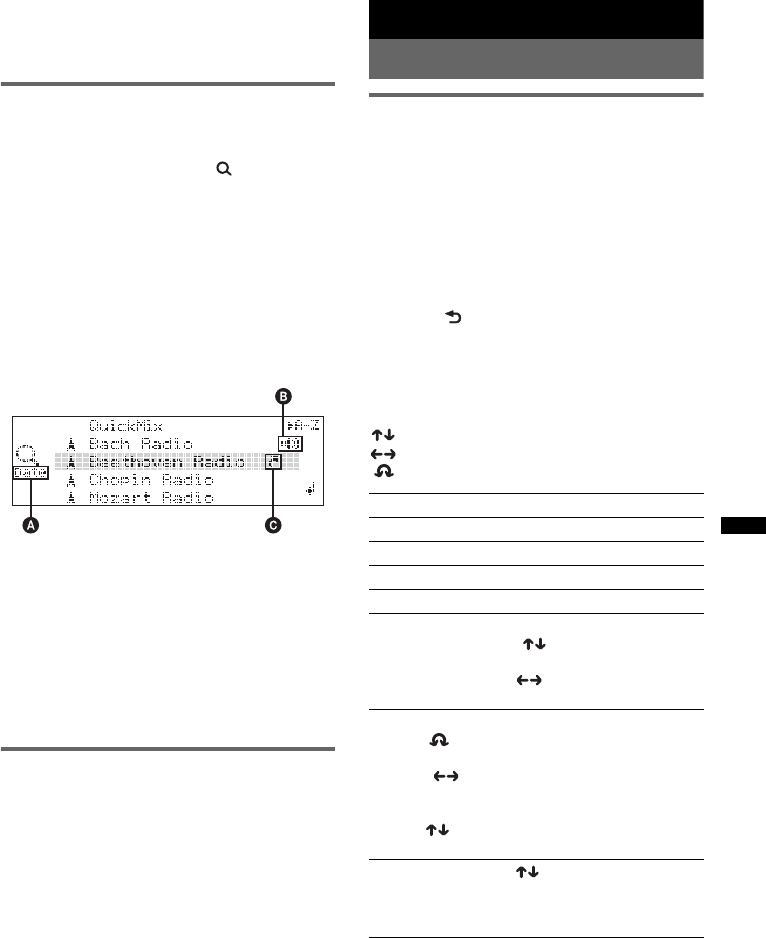
39
Note
Under certain circumstances, “Thumbs” feedback may
be unavailable, and “Cannot Thumbs Up/Down” will be
displayed.
Station list
The station list allows you to easily select a
desired station.
1During playback, press (BROWSE).
Pandora stations on your list appear.
2Push the multi-way encoder right to
select the sorting order: “Date” or “A-
Z.”
“Date” sorts stations by the date they were
added to the account, and “A-Z” sorts station
names in alphabetical order.
3Rotate the multi-way encoder to select
the desired station, then press it.
Playback starts.
ACurrent sort order
BCurrent station
CShared Icon
QuickMix
QuickMix allows you to listen to songs played on
one or more Pandora stations in your station list
randomly.
Edit your QuickMix station selections on the
device before connection.
Bookmarking
The song or artist currently being played can be
bookmarked and stored in your Pandora account.
1During playback, press and hold
(MODE) until “Bookmark” appears.
2Rotate the multi-way encoder to select
“Song” or “Artist”, then press it.
The bookmark is stored, and the system
returns to the previous display.
Note
Under certain circumstances, bookmark store may fail,
and “Bookmark Error” will be displayed. In this case,
try to bookmark again later.
Sound Settings and Setup Menu
Changing the sound settings
Adjusting the sound
characteristics
1During reception/playback, press the
multi-way encoder.
2Rotate the multi-way encoder until the
desired menu item appears, then
press it.
3Use the multi-way encoder to select
the setting, then press it.
4Press (BACK).
The setting is complete and the display
returns to normal reception/play mode.
The following items can be set:
The operation of the multi-way encoder will
differ depending on the items.
: Push the multi-way encoder up/down
: Push the multi-way encoder left/right
: Rotate the multi-way encoder
EQ7 Preset (page 40)
EQ7 Parametric Tune (page 40)
Listening Position Front/Rear (page 41)
Listening Position Subwoofer (page 41)
Listening Position Custom Tune (page 41)
Fader & Balance
Front/Rear/Center ()
Adjusts the relative level.
Right/Left/Center ()
Adjusts the sound balance.
Subwoofer Tune & LPF
Phase ()
Selects the phase: “Normal,” “Reverse.”
FREQ ()
Selects the subwoofer cut-off frequency:
“50Hz,” “60Hz,” “80Hz,” “100Hz,” “120Hz.”
Slope ()
Selects the LPF slope: ”1,” ”2,” ”3.”
Subwoofer Level ()
Adjusts the subwoofer volume: “+10 dB” –
“0 dB” – “–10 dB.”
(“– ∞” is displayed at the lowest setting.)
continue to next page t

40
Enjoying sophisticated sound
functions — Advanced Sound
Engine
Advanced Sound Engine, Sony’s new sound
engine, creates an ideal in-car sound field with
digital signal processing. Advanced Sound
Engine contains the following features: EQ7,
Listening Position, DM+ Advanced, Rear Bass
Enhancer, Dynamic Loudness.
Selecting the sound quality — EQ7
Preset
You can select an equalizer curve from 7
equalizer curves (“Xplod,” “Vocal,” “Edge,”
“Cruise,” “Space,” “Gravity,” “Custom” or
“off”).
1During reception/playback, press the
multi-way encoder.
2Rotate the multi-way encoder until
“EQ7 Preset” appears, then press it.
3Push the multi-way encoder up/down
until the desired equalizer curve
appears, then press it.
4Press (BACK).
The display returns to normal reception/play
mode.
To cancel the equalizer curve, select “off” on step
3.
Tip
Adjusted equalizer curve settings can be memorized
separately for Tuner, USB (SensMe™, Pandora USB)
and Bluetooth Audio (Bluetooth Pandora) sources.
Customizing the equalizer curve
— EQ7 Parametric Tune
“Custom” of EQ7 allows you to make your own
equalizer settings.
Select “Custom” of EQ7 Preset.
If you set “off” for EQ7 Preset, “EQ7 Parametric
Tune” does not appear in the sound settings
menu.
1Select a source, then press the multi-
way encoder.
2Rotate the multi-way encoder until
“EQ7 Parametric Tune” appears, then
press it.
3Setting the equalizer curve.
•Frequency range
Rotate the multi-way encoder to select “Band1”
to “Band7.”
•Center frequency
Push the multi-way encoder left/right to select
the center frequency.
Selectable center frequency in each band:
Band1: “40 Hz” or “63 Hz”
Band2: “100 Hz” or “160 Hz”
Band3: “250 Hz” or “400 Hz”
Band4: “630 Hz” or “1.0 kHz”
Band5: “1.6 kHz” or “2.5 kHz”
Band6: “4.0 kHz” or “6.3 kHz”
Band7: “10.0 kHz” or “16.0 kHz”
•Volume level
Push the multi-way encoder up/down to adjust
the equalizer curve.
The volume level is adjustable in 1 dB steps,
from –6 dB to +6 dB.
4Press the multi-way encoder when you
finish all equalizer settings.
5Press (BACK).
The display returns to normal reception/play
mode.
To restore the factory-set equalizer curve, select
“Initialize” and “Yes” in step 3.
HPF
FREQ ()
Selects the cut-off frequency: “off,” “50Hz,”
“60Hz,” “80Hz,” “100Hz,” “120Hz.”
Slope ()
Select the HPF slope: ”1,” ”2,” ”3.”
DM+ Advanced (page 42)
Rear Bass Enhancer (page 42)
Dynamic Loudness (page 42)
Bluetooth Audio Level (page 37)
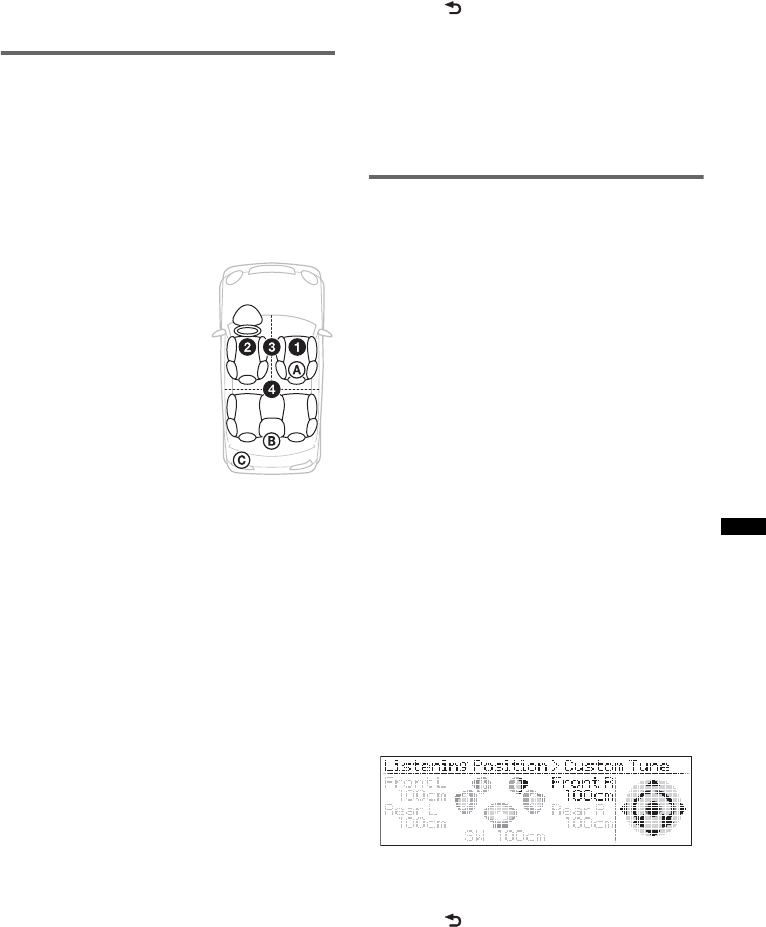
41
Tip
Other equalizer curves are also adjustable.
Optimizing sound by Time
Alignment — Listening Position
The unit can change the localization of sound by
delaying the sound output from each speaker to
suit your position, and simulate a natural sound
field with the feeling of being in the center of it
wherever you sit in the car.
The options for “Listening Position Front/Rear”
are indicated below.
You can also set the approximate subwoofer
position from your listening position if:
– the subwoofer is connected
– the listening position is set to “Front R,” “Front
L,” “Front” or “All.”
The options for “Listening Position Subwoofer”
are indicated below.
“Near” (A): Near
“Normal” (B): Normal
“Far” (C): Far
1During reception/playback, press the
multi-way encoder.
2Rotate the multi-way encoder until
“Listening Position Front/Rear”
appears, then press it.
3Push the multi-way encoder up/down
to select from “Front R,” “Front L,”
“Front,” “All” or “Custom,” then press
it.
4Rotate the multi-way encoder until
“Listening Position Subwoofer”
appears, then press it.
If you select “Front R,” “Front L,” “Front” or
“All” in step 3 above, you can set the
subwoofer position. Push the multi-way
encoder up/down to select from “Near,”
“Normal” or “Far,” then press it.
5Press (BACK).
The display returns to normal reception/play
mode.
To cancel listening position, select “off” on step
3.
Note
If you select “Custom” in step 3 above, you cannot set
the subwoofer position.
Precisely calibrating by Time
Alignment
— Listening Position Custom Tune
You can precisely calibrate your listening
position from each speaker so that the sound
delay reaches the listener more correctly.
Before starting, measure the distance between
your listening position and each speaker.
Select “Custom” of Listening Position Front/
Rear.
1During reception/playback, press the
multi-way encoder.
2Rotate the multi-way encoder until
“Listening Position Custom Tune”
appears, then press it.
3Setting for the listening position.
•Speaker Select
Push the multi-way encoder left/right to select
the speaker.
•Distance
Push the multi-way encoder up/down to set the
distance between your listening position and
speakers.
The distance is adjustable in 2 cm (4/5 in) steps,
between 30 and 300 cm (0.99 and 9.9 ft).
4Press the multi-way encoder when you
complete all settings.
5Press (BACK).
The display returns to normal reception/play
mode.
“Front R” (1): Front right
“Front L” (2): Front left
“Front” (3): Center front
“All” (4): In the center of
your car
“Custom”: Precisely
calibrated position (page 41)
“off”: No position set

42
DM+ Advanced
DM+ Advanced improves digitally compressed
sound by restoring high frequencies lost in the
compression process.
This function works when the USB, SensMe™,
Pandora USB, Bluetooth Audio or Bluetooth
Pandora source is selected only.
1During playback, press the multi-way
encoder.
2Rotate the multi-way encoder until
“DM+ Advanced” appears, then press
it.
3Push the multi-way encoder up/down
to select “on,” then press it.
4Press (BACK).
The display returns to normal reception/play
mode.
Tip
Adjusted DM+ settings can be memorized separately
for USB (SensMe™, Pandora USB) and Bluetooth
Audio (Bluetooth Pandora) sources.
Using rear speakers as subwoofer
— Rear Bass Enhancer
Rear Bass Enhancer enhances the bass sound by
applying the low pass filter setting (page 39) to
the rear speakers. This function allows the rear
speakers to work as a subwoofer if one is not
connected.
1During reception/playback, press the
multi-way encoder.
2Rotate the multi-way encoder until
“Rear Bass Enhancer” appears, then
press it.
3Push the multi-way encoder up/down
to select from “Level 1,” “Level 2” or
“Level 3,” then press it.
4Press (BACK).
The display returns to normal reception/play
mode.
Compensating volume level —
Dynamic Loudness
“Dynamic Loudness” refers to compensating for
volume level and signal gain.
1During reception/playback, press the
multi-way encoder.
2Rotate the multi-way encoder until
“Dynamic Loudness” appears, then
press it.
3Push the multi-way encoder up/down
to select “on,” then press it.
4Press (BACK).
The display returns to normal reception/play
mode.
Adjusting setup items — MENU
1Press and hold the multi-way encoder.
2Rotate the multi-way encoder to select
the desired menu item, then press it.
3Push the multi-way encoder up/down
to select the setting, then press it.
The setting is complete.
4Press (BACK).
The setting is complete and the display
returns to normal reception/play mode.
The following items can be set (follow the page
reference for details):
Setup
Clock Adjust (page 8)
CT (Clock Time) (page 19)
Beep
Activates the beep sound: “on,” “off.”
RM (Rotary Commander)
Changes the operative direction of the rotary
commander controls: “NORM,” “REV.”
Auto Off
Shuts off automatically after a desired time
when the unit is turned off: “NO,” “30sec
(seconds),” “30min (minutes),” “60min
(minutes).”
DEV Inside Alert
Activates the Device Inside Alert function:
“off,” ”on.”

43
Display
Demo
(Demonstration)
Activates the demonstration: “on,” “off.”
Image
Sets various display images.
– “All”: to display all images.
– “Movie”: to display a movie.
– “SA 1 – 3, All”: to display the Spectrum
Analyzer.
– “Wall.P 1 – 4, All”: to display a wallpaper.
– “off”: to not display any image.
Information
Displays the items (depending on the source,
etc.): “on,” “off.”
Dimmer
Changes the display brightness.
– “Auto”: to dim the display automatically when
you turn lights on. (Available only when the
illumination control lead is connected.)
– “on”: to dim the display.
– “off”: deactivate the dimmer.
Illumination
Changes the illumination color: “Blue,” “Red.”
Auto Scroll
Scrolls long items automatically: “on,” “off.”
Play Mode
Repeat (page 22, 27)
ZAPPIN Tone*1
Has the beep sound between track passages:
“on,” “off.”
ZAPPIN Time*1
Selects the playback time for the ZAPPIN
function: “1 (about 6 seconds),” “2 (about 15
seconds),” “3 (about 30 seconds).”
Local (Local Seek Mode)
– “on”: to only tune into stations with stronger
signals.
– “off”: to tune normal reception.
Mono*2 (Monaural Mode)
Selects monaural reception mode to improve
poor FM reception: “on,” “off.”
BTM (page 18)
Bluetooth
PhoneBook Select
Select the phonebook : “Cellular,” “Head Unit.”
Ringtone
Uses the ringtone of this unit or the connected
cellular phone: “Default,” “Cellular.”
Auto Answer
Answers an incoming call automatically.
– “off”: to not answer automatically until the
multi-way encoder is pressed.
– “Short”: to answer automatically after 3
seconds.
– “Long”: to answer automatically after 10
seconds.
BT Initialize*3 (page 37)
*1 When USB/SensMe™/iPod source is activated.
*2 When FM is received.
*3 When the unit is turned off.
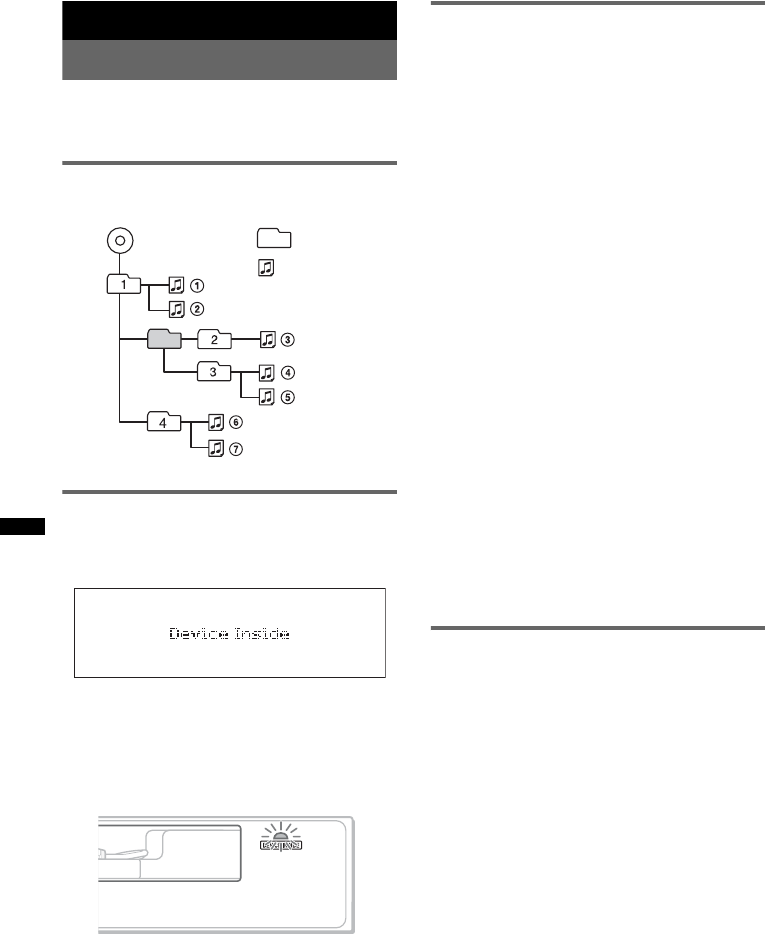
44
Additional Information
Precautions
• Cool off the unit beforehand if your car has been
parked in direct sunlight.
• Power antenna (aerial) extends automatically.
Playback order of MP3/WMA/AAC
files
About Device Inside Alert
If you turn the ignition switch to the OFF
position without removing the USB device or
iPod, “Device Inside” will appear in the display.
Open the front panel to remove the USB device
or iPod.
If the front panel is detached when the
ignition is turned off.
The Device Inside Alert LED flashes.
Tip
For how to remove the USB device or iPod, see
page 20 (USB), 26 (iPod).
Notes
•The Device Inside Alert will only sound if the built-in
amplifier is used.
•For how to disable the Device Inside Alert function,
see page 42.
About iPod
• You can connect to the following iPod models.
Update your iPod devices to the latest software
before use.
Made for
– iPod touch (4th generation)
– iPod touch (3rd generation)
– iPod touch (2nd generation)
– iPod touch (1st generation)
– iPod classic
– iPod with video*
– iPod nano (6th generation)
– iPod nano (5th generation)
– iPod nano (4th generation)
– iPod nano (3rd generation)
– iPod nano (2nd generation)
– iPod nano (1st generation)*
–iPhone 4
– iPhone 3GS
– iPhone 3G
–iPhone
*Passenger control is not available for iPod nano (1st
generation) or iPod with video.
• “Made for iPod,” and “Made for iPhone” mean
that an electronic accessory has been designed to
connect specifically to iPod or iPhone,
respectively, and has been certified by the
developer to meet Apple performance standards.
Apple is not responsible for the operation of this
device or its compliance with safety and
regulatory standards. Please note that the use of
this accessory with iPod or iPhone may affect
wireless performance.
About Bluetooth function
What is Bluetooth technology?
• Bluetooth wireless technology is a short-range
wireless technology that enables wireless data
communication between digital devices, such as a
cellular phone and a headset. Bluetooth wireless
technology operates within a range of about 10 m
(about 33 feet). Connecting two devices is
common, but some devices can be connected to
multiple devices at the same time.
• You do not need to use a cable for connection
since Bluetooth technology is a wireless
technology, neither is it necessary for the devices
to face one another, such is the case with infrared
technology. For example, you can use such a
device in a bag or pocket.
• Bluetooth technology is an international standard
supported by millions of companies all over the
world, and employed by various companies
worldwide.
Folder
(album)
MP3/WMA/
AAC file
(track)
MP3/WMA/AAC

45
On Bluetooth communication
• Bluetooth wireless technology operates within a
range of about 10 m.
Maximum communication range may vary
depending on obstacles (person, metal, wall, etc.)
or electromagnetic environment.
• The following conditions may affect the
sensitivity of Bluetooth communication.
– There is an obstacle such as a person, metal, or
wall between this unit and Bluetooth device.
– A device using 2.4 GHz frequency, such as a
wireless LAN device, cordless telephone, or
microwave oven, is in use near this unit.
• Because Bluetooth devices and wireless LAN
(IEEE802.11b/g) use the same frequency,
microwave interference may occur and result in
communication speed deterioration, noise, or
invalid connection if this unit is used near a
wireless LAN device. In such as case, perform the
following.
– Use this unit at least 10 m away from the
wireless LAN device.
– If this unit is used within 10 m of a wireless
LAN device, turn off the wireless LAN device.
– Install this unit and Bluetooth device as near to
each other as possible.
• Microwaves emitting from a Bluetooth device may
affect the operation of electronic medical devices.
Turn off this unit and other Bluetooth devices in
the following locations, as it may cause an
accident.
– where inflammable gas is present, in a hospital,
train, airplane, or petrol station
– near automatic doors or a fire alarm
• This unit supports security capabilities that
comply with the Bluetooth standard to provide a
secure connection when the Bluetooth wireless
technology is used, but security may not be
enough depending on the setting. Be careful when
communicating using Bluetooth wireless
technology.
• We do not take any responsibility for the leakage
of information during Bluetooth communication.
• Connection with all Bluetooth devices cannot be
guaranteed.
– A device featuring Bluetooth function is
required to conform to the Bluetooth standard
specified by Bluetooth SIG, and be
authenticated.
– Even if the connected device conforms to the
above mentioned Bluetooth standard, some
devices may not be connected or work correctly,
depending on the features or specifications of the
device.
– While talking on the phone handsfree, noise may
occur, depending on the device or
communication environment.
• Depending on the device to be connected, it may
require some time to start communication.
Others
• Using the Bluetooth device may not function on
cellular phones, depending on radio wave
conditions and location where the equipment is
being used.
• If you experience discomfort after using the
Bluetooth device, stop using the Bluetooth device
immediately. Should any problem persist, consult
your nearest Sony dealer.
If you have any questions or problems concerning
your unit that are not covered in this manual, consult
your nearest Sony dealer.
Maintenance
Replacing the lithium battery of the
card remote commander
Under normal conditions, the battery will last
approximately 1 year. (The service life may be
shorter, depending on the conditions of use.)
When the battery becomes weak, the range of the
card remote commander becomes shorter. Replace
the battery with a new CR2025 lithium battery. Use
of any other battery may present a risk of fire or
explosion.
Notes on the lithium battery
•Keep the lithium battery out of the reach of children.
Should the battery be swallowed, immediately
consult a doctor.
•Wipe the battery with a dry cloth to assure a good
contact.
•Be sure to observe the correct polarity when
installing the battery.
•Do not hold the battery with metallic tweezers,
otherwise a short-circuit may occur.
continue to next page t
+ side up
c
WARNING
Battery may explode if mistreated.
Do not recharge, disassemble, or dispose of
in fire.
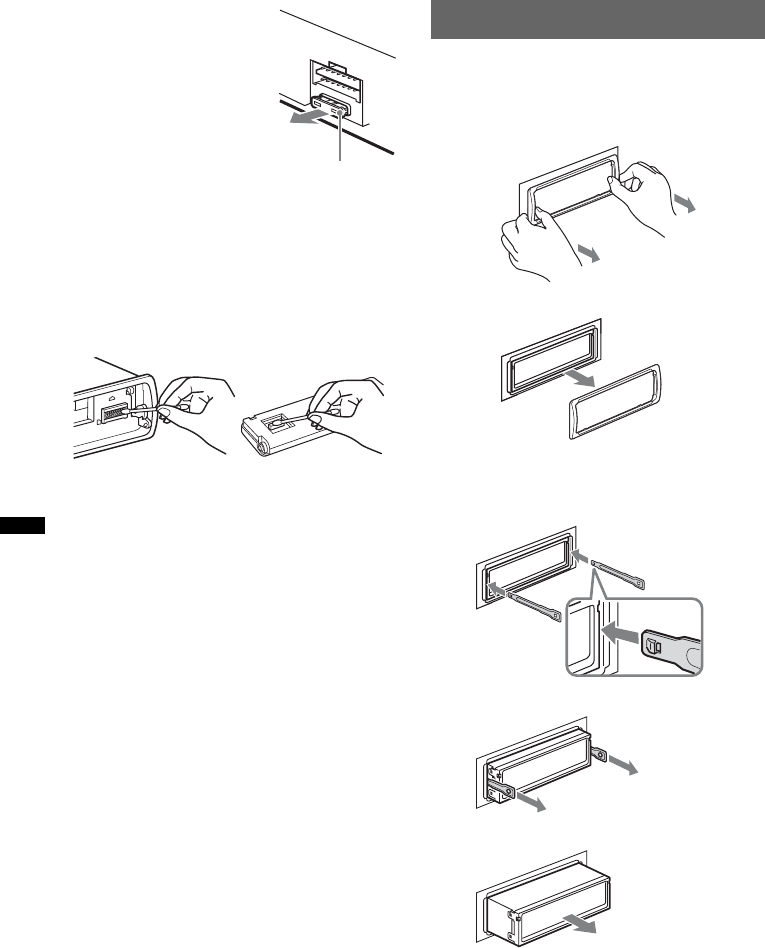
46
Fuse replacement
When replacing the fuse, be
sure to use one matching the
amperage rating stated on the
original fuse. If the fuse blows,
check the power connection and
replace the fuse. If the fuse
blows again after replacement,
there may be an internal
malfunction. In such a case,
consult your nearest Sony
dealer.
Cleaning the connectors
The unit may not function properly if the connectors
between the unit and the front panel are not clean. In
order to prevent this, detach the front panel (page 8)
and clean the connectors with a cotton swab. Do not
apply too much force. Otherwise, the connectors
may be damaged.
Notes
•For safety, turn off the ignition before cleaning the
connectors, and remove the key from the ignition
switch.
•Never touch the connectors directly with your fingers
or with any metal device.
Removing the unit
1Remove the protection collar.
1Detach the front panel (page 8).
2Pinch both edges of the protection collar,
then pull it out.
2Remove the unit.
1Insert both release keys simultaneously
until they click.
2Pull the release keys to unseat the unit.
3Slide the unit out of the mounting.
Fuse (10 A)
Main unit Back of the front
panel
x
Hook facing
inwards.

47
Specifications
Tuner section
FM
Tuning range: 87.5 – 107.9 MHz
Antenna (aerial) terminal:
External antenna (aerial) connector
Intermediate frequency: 150 kHz
Usable sensitivity: 10 dBf
Selectivity: 75 dB at 400 kHz
Signal-to-noise ratio: 70 dB (mono)
Separation: 40 dB at 1 kHz
Frequency response: 20 – 15,000 Hz
AM
Tuning range: 530 – 1,710 kHz
Antenna (aerial) terminal:
External antenna (aerial) connector
Intermediate frequency: 25 kHz
Sensitivity: 26 µV
USB Player section
Interface: USB (Full-speed)
Maximum current: 500 mA
Wireless Communication
Communication System:
Bluetooth Standard version 2.1 + EDR
Output:
Bluetooth Standard Power Class 2 (Max. +4 dBm)
Maximum communication range:
Line of sight approx. 10 m (33 ft)*1
Frequency band:
2.4 GHz band (2.4000 – 2.4835 GHz)
Modulation method: FHSS
Compatible Bluetooth Profiles*2:
A2DP (Advanced Audio Distribution Profile) 1.2
AVRCP (Audio Video Remote Control Profile) 1.3
HFP (Handsfree Profile) 1.5
PBAP (Phone Book Access Profile)
OPP (Object Push Profile)
*1 The actual range will vary depending on factors
such as obstacles between devices, magnetic
fields around a microwave oven, static electricity,
reception sensitivity, antenna’s performance,
operating system, software application, etc.
*2 Bluetooth standard profiles indicate the purpose of
Bluetooth communication between devices.
Power amplifier section
Output: Speaker outputs
Speaker impedance: 4 – 8 ohms
Maximum power output: 52 W × 4 (at 4 ohms)
General
Outputs:
Audio outputs terminal (front/rear)
Subwoofer output terminal (mono)
Power antenna (aerial) relay control terminal
Power amplifier control terminal
Inputs:
Remote controller input terminal
Antenna (aerial) input terminal
Telephone ATT control terminal
Illumination control terminal
BUS control input terminal
BUS audio input terminal
USB signal input connector (internal/external)
MIC input terminal
Power requirements: 12 V DC car battery
(negative ground (earth))
Dimensions: Approx. 178 × 50 × 180 mm
(7 1/8 × 2 × 7 1/8 in) (w/h/d)
Mounting dimensions: Approx. 182 × 53 × 163 mm
(7 1/4 × 2 1/8 × 6 1/2 in) (w/h/d)
Mass: Approx. 1.1 kg (2 lb 7 oz)
Supplied accessories:
Card remote commander: RM-X306
USB connector for iPod: XA-50IP
Parts for installation and connections (1 set)
Microphone
Optional accessories/equipment:
Source selector: XA-C40
USB connection cable for iPod: RC-100IP
HD RadioTM tuner: XT-100HD
Walkman adaptor: XA-50WM
Your dealer may not handle some of the above listed
accessories. Please ask the dealer for detailed
information.
Design and specifications are subject to change
without notice.
System requirements for using
SensMe™
Computer
•CPU/RAM
– IBM PC/AT compatible machine
– CPU: Intel Pentium III Processor 450 MHz or
higher
– RAM: 256 MB or more (For Windows XP), 512
MB or more (For Windows Vista or later)
• USB port
OS
Windows XP, Windows Vista, Windows 7
For details on compatible editions or Service Pack, visit
the following support site:
http://esupport.sony.com
http://www.sony.com/mobileAV
CEA2006 Standard
Power Output: 17 Watts RMS
4 Ohms < 1% THD+N
SN Ratio: 80 dBA
(reference: 1 Watt into 4 Ohms)
AUDIO POWER SPECIFICATIONS
4 at
continue to next page t

48
Monitor
High color (16-bit) or more, 800 × 600 dots or more
Other
Internet connection
Notes
•The following system environments are not
supported.
– Non IBM PC type computers, such as Macintosh,
etc.
– Homemade computers
– OS upgraded computers
– Multi-display environment
– Multi-boot environment
– Virtual machine environment
•Depending on the computer condition, operation
may not be possible even with the recommended
environment.
Troubleshooting
The following checklist will help you remedy
problems you may encounter with your unit.
Before going through the checklist below, check the
connection and operating procedures.
If the problem is not solved, visit the following
support site.
General
No power is being supplied to the unit.
• Check the connection or fuse.
• If the unit is turned off and the display disappears, it
cannot be operated with the remote commander.
tTurn on the unit.
The power antenna (aerial) does not extend.
The power antenna (aerial) does not have a relay box.
No sound.
• The ATT function is activated, or the Telephone ATT
function (when the interface cable of a car telephone
is connected to the ATT lead) is activated.
• The position of the fader control “Fader & Balance”
is not set for a 2-speaker system.
The contents of the memory have been erased.
• The RESET button has been pressed.
tStore again into the memory.
• The power supply lead or battery has been
disconnected or it is not connected properly.
Stored stations and correct time are erased.
The fuse has blown.
Makes noise when the position of the ignition
is switched.
The leads are not matched correctly with the car’s
accessory power connector.
During playback or reception, demonstration
mode starts.
If no operation is performed for 5 minutes with “Demo
on” set, demonstration mode starts.
tSet “Demo off” (page 43).
The display disappears from/does not appear
in the display window.
• The dimmer is set “Dimmer on” (page 43).
• The display disappears if you press and hold
(SOURCE/OFF).
tPress (SOURCE/OFF) on the unit until the
display appears.
• The connectors are dirty (page 46).
The Auto Off function does not operate.
The unit is turned on. The Auto Off function activates
after turning off the unit.
tTurn off the unit.
Support site
http://esupport.sony.com
http://www.sony.com/mobileAV

49
Radio reception
The stations cannot be received.
The sound is hampered by noises.
• The connection is not correct.
tConnect a power antenna (aerial) control lead
(blue) or accessory power supply lead (red) to the
power supply lead of a car’s antenna (aerial)
booster (only when your car has built-in FM/AM
antenna (aerial) in the rear/side glass).
tCheck the connection of the car antenna (aerial).
tIf the auto antenna (aerial) will not go up, check
the connection of the power antenna (aerial)
control lead.
Preset tuning is not possible.
• Store the correct frequency in the memory.
• The broadcast signal is too weak.
Automatic tuning is not possible.
• Setting of the local seek mode is not correct.
tTuning stops too frequently:
Set “Local on” (page 43).
tTuning does not stop at a station:
Set “Local off” (page 43).
• The broadcast signal is too weak.
tPerform manual tuning.
During FM reception, the “ST” indication
flashes.
• Tune in the frequency accurately.
• The broadcast signal is too weak.
tSet “Mono on” (page 43).
An FM program broadcast in stereo is heard in
monaural.
The unit is in monaural reception mode.
tSet “Mono off” (page 43).
RDS
PTY displays “- - - - - - - -.”
• The current station is not an RDS station.
• RDS data has not been received.
• The station does not specify the program type.
USB playback
You cannot play back items via a USB hub.
This unit cannot recognize USB devices via a USB
hub.
Cannot play back items.
A USB device does not work.
tReconnect it.
The USB device takes longer to play back.
The USB device contains files with a complicated tree
structure.
The display items do not scroll.
• A large number of characters may not scroll.
• “Auto Scroll” is set to “off.”
tSet “Auto Scroll on” (page 43).
tPress and hold (DSPL) (SCRL).
The sound is intermittent.
The sound may be intermittent at a high-bit-rate of
more than 320 kbps.
Pandora connection is not possible.
Shut down Pandora on the mobile device, and then
launch again.
Bluetooth function
The connecting device cannot detect this unit.
• Before the pairing is made, set this unit to pairing
standby mode.
• While connected to a Bluetooth device, this unit
cannot be detected from another device. Disconnect
the current connection and search for this unit from
another device.
• When the device pairing is made, set the Bluetooth
signal output to on (page 33).
Connection is not possible.
Check the pairing and connection procedures in the
manual of the other device, etc., and perform the
operation again.
The name of the detected device does not
appear.
Depending on the status of the other device, it may not
be possible to obtain the name.
No ringtone.
• Adjust the volume in “Ring Volume” level.
• Depending on the connecting device, the ringtone
may not be sent properly.
tSet “Ringtone” to “Default” (page 34).
The talker’s voice volume is low.
Adjust the volume in “Talk Volume” level.
A call partner says that the volume is too low
or high.
Adjust the volume accordingly using MIC Gain
adjustment (page 35).
Echo or noise occurs in phone call
conversations.
• Lower the volume.
• Set “EC/NC Mode” to “EC/NC Mode 1” or “EC/NC
Mode 2” (page 35).
• If the ambient noise other than the phone call sound
is loud, try reducing this noise.
E.g.: If a window is open and road noise, etc., is loud,
shut the window. If the air conditioner is loud, lower
the air conditioner.
The phone is not connected.
When the Bluetooth audio is played back, the phone is
not connected even if you press the multi-way encoder.
tConnect from the phone.
The phone sound quality is poor.
Phone sound quality depends on reception conditions
of cellular phone.
tMove your car to a place where you can enhance
the cellular phone's signal if the reception is poor.
The volume of the connected audio device is
low (high).
Volume level will differ depending on the audio
device.
tAdjust the volume of the connected audio device or
this unit.
continue to next page t

50
Error displays/Messages
No sound is heard from the Bluetooth audio
device.
The audio device is paused.
tCancel pause of the audio device.
The sound skips during playback of a
Bluetooth audio device.
• Reduce the distance between the unit and the
Bluetooth audio device.
• If the Bluetooth audio device is stored in a case
which interrupts the signal, remove the audio device
from the case while using.
• Several Bluetooth devices or other devices which
emit radio waves are used nearby.
tTurn off the other devices.
tReduce the distance from the other devices.
• The playback sound stops momentarily when the
connection between this unit and the cellular phone is
being made. This is not a malfunction.
The connected Bluetooth audio device cannot
be controlled.
Check that the connected Bluetooth audio device
supports AVRCP.
Some functions do not work.
Check that the connecting device supports the
functions in question.
The name of the other party does not appear
when a call is received.
• The other party is not stored in the phonebook.
tStore in the phonebook (page 35).
• The calling phone is not set to send the phone
number.
A call is answered unintentionally.
• The connecting phone is set to start a call
automatically.
• “Auto Answer” of this unit is set to “Short” or
“Long” (page 34).
Pairing failed due to time out.
Depending on the connecting device, the time limit for
pairing may be short. Try completing the pairing
within the time.
Bluetooth function cannot operate.
Turn off the unit by pressing (SOURCE/OFF) for 2
seconds, then turn the unit on again.
No sound is output from the car speakers
during handsfree call.
If the sound is output from the cellular phone, set the
cellular phone to output the sound from the car
speakers.
Pandora connection is not possible.
Shut down Pandora on the mobile device, and then
launch again.
Busy now... Please try later
This unit is busy.
tAfter waiting a moment, try again.
Checking
The unit is confirming the connection of a USB device.
tWait until confirming the connection is finished.
Connection Failed
Accessing the phonebook was terminated from the
cellular phone.
tAccess the phonebook in the cellular phone again.
Device Inside
If you turn the ignition switch to the OFF position
without removing the USB device or iPod, “Device
Inside” will appear in the display.
Empty
• The call history is empty.
• The phonebook is empty.
Error
• USB device was not automatically recognized.
tReconnect it again.
• Phonebook content was changed while accessing the
cellular phone.
tAccess the phonebook in the cellular phone again.
Failure (Illuminates until any button is pressed.)
The connection of speakers/amplifiers is incorrect.
tSee the installation guide manual of this model to
check the connection.
Failure (Illuminates for about 1 second.)
When the SAT tuner is connected, storing an SAT
radio channel into a preset failed.
tBe sure to receive the channel that you want to
store, then try it again.
HF Device is not available
A cellular phone is not connected.
tConnect to a cellular phone.
Hubs Not Supported
USB hub is not supported on this unit.
Invalid channel file
A file in the music folder may have been edited
without using “Content Transfer.”
tPerform “SensMe™ Setup” for the USB device or
Walkman again. For details on “SensMe™ Setup”,
see page 22.
Local Seek +/–
The local seek mode is on during automatic tuning.
NO Device
USB is selected as source without a USB device
connected. A USB device or a USB cable has been
disconnected during playback.
tBe sure to connect a USB device and USB cable.
NO Music
The USB device does not contain a music file.
tConnect a USB device with a music file in it.
NO Name
An album/artist/track name is not written in the track.

51
If these solutions do not help improve the situation,
consult your nearest Sony dealer.
No SensMe™ data on device.
The connected USB device does not contain data for
the SensMe™ function, or the data has been moved to
an improper location in the USB device.
NO Track
The selected item in the USB device does not contain
an album/track.
Not Found
There is no item beginning with the desired letter in
Alphabet search.
Not Supported
The connected USB device is not supported.
tFor details on the compatibility of your USB
device, visit the support site.
Offset
There may be an internal malfunction.
tCheck the connection. If the error indication
remains on in the display, consult your nearest
Sony dealer.
Overload
USB device is overloaded.
tDisconnect the USB device, then change the source
by pressing (SOURCE/OFF).
tIndicates that the USB device is out of order, or an
unsupported device is connected.
Read
The unit is reading all track and album information on
the USB device.
tWait until reading is complete and playback starts
automatically.
Push Reset
USB device cannot be operated due to a problem.
tPress the RESET button (page 7).
“” or “”
During reverse or fast-forward, you have reached the
beginning or the end of the USB device and you cannot
go any further.
“”
The character cannot be displayed with the unit.
Please launch Pandora Application on mobile
device.
Pandora does not start up.
tStart up Pandora on iPhone.
Please launch Pandora App on mobile device
and press (PAUSE) on this unit.
Pandora does not start up.
tStart up Pandora on the Bluetooth device, then
press (PAUSE).
Application error on mobile device. Do not
check the mobile device while driving.
Pandora does not start up.
tStart up Pandora and log in your account.
USB External Not Supported
The connected USB device is not Pandora device.
tPlease connect iPhone.
NO Station
There is no station on your Pandora account.
tCreate the station on the mobile device.
Cannot Skip
Skipping tracks on Pandora is not allowed.
tWait until the commercial ends.
tPandora limits the number of skips allowed on their
service. Wait until the next song begins, or select
another station on the list.
Cannot Thumbs Up/Down
“Thumbs” feedback is not allowed.
tWait until the commercial ends.
tSome function, such as Shared Station, do not
permit feedback. Wait until the next song begins, or
select another station on the list.
Thumbs Up/Down Error
“Thumbs” feedback failed.
tTry “Thumbs Up/Down” again.
Bookmark Not Allowed
Bookmark is not allowed.
tWait until the commercial ends.
tSelect another song or station, then try it again.
Bookmark Error
Bookmarking failed.
tTry bookmarking again.

2
ZAPPIN y Quick-BrowZer son marcas
comerciales de Sony Corporation.
La marca de la palabra y logotipos de Bluetooth
son propiedad de Bluetooth SIG, Inc. y Sony
Corporation posee licencia para utilizar
cualquiera de dichas marcas. Otras marcas
registradas y nombres comerciales pertenecen a
sus respectivos propietarios.
12 TONE ANALYSIS y su
logotipo son marcas
comerciales de Sony
Corporation.
“WALKMAN” y el
logotipo de
“WALKMAN” son
marcas comerciales
registradas de Sony
Corporation.
SensMe y el logotipo de SensMe
son marcas registradas o marcas
comerciales registradas de Sony
Ericsson Mobile
Communications AB.
La tecnología de reconocimiento de música y los
datos afines son proporcionados por Gracenote®.
Gracenote es la norma de la industria en
tecnología de reconocimiento de música y
entrega de contenidos afines. Si desea más
información, visite www.gracenote.com.
Los derechos de autor de CD, DVD, discos Blu-
ray y datos relacionados con la música y los
vídeos de Gracenote, Inc. (copyright © 2000) son
propiedad ahora de Gracenote. Los derechos de
autor de Gracenote Software (copyright © 2000)
son propiedad ahora de Gracenote. Una o varias
patentes propiedad de Gracenote son aplicables a
este producto y servicio. Consulte el sitio web de
Gracenote para acceder a una lista no exhaustive
de las patentes de Gracenote aplicables.
Gracenote, CDDB, MusicID, MediaVOCS, el
logotipo Gracenote y el logotipo “Powered by
Gracenote” son marcas comerciales registradas o
marcas comerciales de Gracenote en Estados
Unidos y otros países.
Microsoft, Windows, Windows Vista y Windows
Media y los logotipos son marcas comerciales o
marcas registradas de Microsoft Corporation en
los Estados Unidos y/u otros países.
Este producto contiene tecnología sujeta a ciertos
derechos de propiedad intelectual de Microsoft.
La utilización o distribución de esta tecnología
fuera de este producto está prohibida sin la
licencia(s) apropiada de Microsoft.
iPhone, iPod, iPod classic, iPod nano y el iPod
touch son marcas comerciales de Apple Inc.,
registradas en EE. UU. y otros países.
PANDORA, el logotipo de PANDORA y la
imagen de la marca Pandora son marcas
comerciales o marcas comerciales registradas de
Pandora Media, Inc., utilizadas con autorización.
Android es una marca comercial de Google Inc.
El uso de esta marca comercial está sujeto a
Google Permissions.
Asegúrese de instalar esta unidad en el tablero
del automóvil por razones de seguridad. Para
realizar la instalación y las conexiones,
consulte el manual de instalación y de
conexiones suministrado.
HD RadioTM
es una marca propietaria de
iBiquity Digital Corp.
El logotipo “SAT Radio
Ready” indica que este
producto controla un módulo
de sintonizador de radio por
satélite (se vende por separado). Si desea
obtener más detalles sobre el módulo de
sintonizador de radio por satélite, póngase en
contacto con el distribuidor Sony autorizado
más cercano.
Consulte los manuales que se incluyen en el
módulo de sintonizador de radio por
satélite. Se requiere Sirius o XM Subscription.
“SAT Radio”, “SAT Radio Ready”, los
logotipos de SAT Radio, SAT Radio Ready y
todas las marcas relacionadas son marcas
comerciales de Sirius XM Radio Inc. y XM
Satellite Radio Inc.
Apple, Macintosh e iTunes son marcas
registradas de Apple Inc., registradas en los
Estados Unidos y otros países.
Tecnología de codificación de audio MPEG
Layer-3 y patentes bajo licencia de Fraunhofer IIS
y Thomson.

3
BlackBerry® es propiedad de Research In
Motion Limited y está registrada y/o se utiliza en
los EE.UU. y en países de todo el mundo. Se
utiliza bajo licencia de Research In Motion
Limited.
Advertencia: si el encendido del
automóvil no dispone de una posición
ACC
Asegúrese de ajustar la función de
desconexión automática (página 46).
La unidad se apagará completa y
automáticamente en el tiempo establecido
después de apagarla, lo cual evita que se agote
la batería.
Si no ajusta la función de desconexión
automática, mantenga presionado
(SOURCE/OFF) hasta que se apague la
pantalla cada vez que apague el motor.

4
Tabla de contenido
Procedimientos iniciales
Notas sobre Bluetooth . . . . . . . . . . . . . . . . . . . . 7
Restauración de la unidad . . . . . . . . . . . . . . . . . 7
Cancelación del modo Demo. . . . . . . . . . . . . . . 8
Preparación del control remoto de tarjeta . . . . . 8
Ajuste del reloj . . . . . . . . . . . . . . . . . . . . . . . . . 8
Extracción del panel frontal. . . . . . . . . . . . . . . . 8
Colocación del panel frontal . . . . . . . . . . . . . 9
Guía rápida para la función
Bluetooth
Tres pasos para el funcionamiento de
Bluetooth . . . . . . . . . . . . . . . . . . . . . . . . . . . . . 10
Botones e iconos . . . . . . . . . . . . . . . . . . . . . . . 11
1Emparejamiento . . . . . . . . . . . . . . . . . . . . . 12
2Conexión . . . . . . . . . . . . . . . . . . . . . . . . . . 12
3Llamadas con manos libres y
transmisión de música . . . . . . . . . . . . . . . . . . . 13
Ubicación de los controles y
operaciones básicas
Unidad principal . . . . . . . . . . . . . . . . . . . . . 14
Control remoto de tarjeta RM-X306. . . . . . 16
Radio
Almacenamiento y recepción de emisoras . . . 18
Almacenamiento automático
— BTM. . . . . . . . . . . . . . . . . . . . . . . . . . . . 18
Almacenamiento manual . . . . . . . . . . . . . . 18
Recepción de las emisoras
almacenadas . . . . . . . . . . . . . . . . . . . . . . . . 18
Sintonización automática . . . . . . . . . . . . . . 18
RDS . . . . . . . . . . . . . . . . . . . . . . . . . . . . . . . . . 19
Descripción general . . . . . . . . . . . . . . . . . . 19
Selección de PTY . . . . . . . . . . . . . . . . . . . . 19
Ajuste de CT . . . . . . . . . . . . . . . . . . . . . . . . 19
Dispositivos USB
Reproducción de un dispositivo USB. . . . . . . 20
Reproducción mediante el conector USB
(interno) . . . . . . . . . . . . . . . . . . . . . . . . . . . 20
Reproducción mediante el conector USB
(externo) . . . . . . . . . . . . . . . . . . . . . . . . . . . 21
Elementos de la pantalla. . . . . . . . . . . . . . . 21
Reproducción repetida . . . . . . . . . . . . . . . . 22
Reproducción aleatoria. . . . . . . . . . . . . . . . 22
Reproducción de música según su estado de
ánimo — SensMe™ . . . . . . . . . . . . . . . . . . . . 23
Antes de utilizar la función
SensMe™. . . . . . . . . . . . . . . . . . . . . . . . . . 23
Instalación de “SensMe™ Setup” y
“Content Transfer” en el equipo . . . . . . . . 23
Registro de un dispositivo USB mediante
“SensMe™ Setup” . . . . . . . . . . . . . . . . . . . 24
Transferencia de pistas al dispositivo USB
mediante “Content Transfer” . . . . . . . . . . . 24
Reproducción de pistas en el canal
— SensMe™ channels. . . . . . . . . . . . . . . . 24
iPod
Reproducción en un iPod . . . . . . . . . . . . . . . . 25
Reproducción mediante el conector USB
(interno) . . . . . . . . . . . . . . . . . . . . . . . . . . . 25
Reproducción mediante el conector USB
(externo) . . . . . . . . . . . . . . . . . . . . . . . . . . . 26
Elementos de la pantalla. . . . . . . . . . . . . . . 27
Reproducción repetida . . . . . . . . . . . . . . . . 28
Reproducción aleatoria. . . . . . . . . . . . . . . . 28
Utilización directa del iPod
— Control de pasajero . . . . . . . . . . . . . . . . . . 29
Pandora® a través de USB (iPhone)
Reproducción en Pandora . . . . . . . . . . . . . . . . 29
Reproducción mediante el conector USB
(externo) . . . . . . . . . . . . . . . . . . . . . . . . . . . 29
Clasificación por “Thumbs (Pulgares)” . . . 30
Lista de estaciones . . . . . . . . . . . . . . . . . . . 30
Agregar marcadores . . . . . . . . . . . . . . . . . . 30

5
Búsqueda de una pista
Búsqueda de una pista por nombre
— Quick-BrowZer™. . . . . . . . . . . . . . . . . . . . 31
Búsqueda por omisión de elementos
— Modo de Omisión . . . . . . . . . . . . . . . . . 31
Búsqueda por orden alfabético
— Búsqueda alfabética . . . . . . . . . . . . . . . . 32
Búsqueda de una pista por segmentos
— ZAPPIN™ . . . . . . . . . . . . . . . . . . . . . . . . . 33
En el caso de reproducción de “SensMe™
channels”. . . . . . . . . . . . . . . . . . . . . . . . . . . 33
Bluetooth (Llamadas con manos
libres y transmisión de música)
Operaciones de Bluetooth . . . . . . . . . . . . . . . . 33
Acerca de los iconos Bluetooth . . . . . . . . . 34
Instalación del micrófono . . . . . . . . . . . . . . 34
Emparejamiento. . . . . . . . . . . . . . . . . . . . . . . . 34
Conexión . . . . . . . . . . . . . . . . . . . . . . . . . . . . . 35
Conexión a un teléfono celular . . . . . . . . . . 35
Conexión de un dispositivo de audio . . . . . 35
Realización de llamadas con manos
libres . . . . . . . . . . . . . . . . . . . . . . . . . . . . . . . . 36
Realización de llamadas . . . . . . . . . . . . . . . 36
Recepción de llamadas . . . . . . . . . . . . . . . . 36
Operaciones durante una llamada. . . . . . . . 37
Transferencia de llamadas. . . . . . . . . . . . . . 37
Manejo de la agenda telefónica. . . . . . . . . . 37
Marcación preajustada . . . . . . . . . . . . . . . . 38
Activación de la marcación por voz . . . . . . 38
Indicador de SMS . . . . . . . . . . . . . . . . . . . . 39
Transmisión de música . . . . . . . . . . . . . . . . . . 39
Reproducción de música desde un
dispositivo de audio . . . . . . . . . . . . . . . . . . 39
Operación de un dispositivo de audio con
esta unidad . . . . . . . . . . . . . . . . . . . . . . . . . 40
Otros ajustes . . . . . . . . . . . . . . . . . . . . . . . . . . 40
Inicialización de los ajustes de
Bluetooth. . . . . . . . . . . . . . . . . . . . . . . . . . . 40
Pandora a través de Bluetooth
(teléfonos Android™ y
BlackBerry®)
Reproducción en Pandora . . . . . . . . . . . . . . . . 41
Reproducción por medio de Bluetooth . . . . 41
Clasificación por “Thumbs (Pulgares)” . . . 42
Lista de estaciones . . . . . . . . . . . . . . . . . . . 42
Agregar marcadores . . . . . . . . . . . . . . . . . . 42
Ajustes de sonido y menú de
configuración
Cambio de los ajustes de sonido. . . . . . . . . . . 43
Ajuste de las características de sonido. . . . 43
Uso de funciones de sonido sofisticadas
— Advanced Sound Engine . . . . . . . . . . . . . . 43
Selección de la calidad de sonido
— EQ7 Preset. . . . . . . . . . . . . . . . . . . . . . . 43
Personalización de la curva de ecualizador
— EQ7 Parametric Tune . . . . . . . . . . . . . . 44
Optimización de sonido por alineación de
tiempo — Listening Position . . . . . . . . . . . 44
Calibración precisa por alineación de tiempo
— Listening Position Custom Tune. . . . . . 45
DM+ Advanced . . . . . . . . . . . . . . . . . . . . . 45
Uso de los altavoces posteriores como
altavoz potenciador de graves
— Rear Bass Enhancer. . . . . . . . . . . . . . . . 46
Compensación del nivel de volumen
— Dynamic Loudness . . . . . . . . . . . . . . . . 46
Ajuste de los elementos de configuración
— MENÚ . . . . . . . . . . . . . . . . . . . . . . . . . . . . 46
Información complementaria
Precauciones . . . . . . . . . . . . . . . . . . . . . . . . . . 48
Orden de reproducción de los archivos
MP3/WMA/AAC . . . . . . . . . . . . . . . . . . . . 48
Acerca de Device Inside Alert . . . . . . . . . . 48
Acerca de iPod . . . . . . . . . . . . . . . . . . . . . . 48
Acerca de la función Bluetooth . . . . . . . . . 48
Mantenimiento . . . . . . . . . . . . . . . . . . . . . . . . 49
Extracción de la unidad. . . . . . . . . . . . . . . . . . 50
Especificaciones . . . . . . . . . . . . . . . . . . . . . . . 51
Solución de problemas . . . . . . . . . . . . . . . . . . 52
Mensajes/indicaciones de error . . . . . . . . . 54

6
Sitio Web de soporte técnico en línea
Para resolver cualquier duda u obtener la información más reciente
sobre el soporte técnico de este producto, visite el siguiente sitio Web:
http://esupport.sony.com
http://www.sony.com/mobileAV
Proporciona información acerca de:
• Modelos y fabricantes de reproductores de audio digital compatibles
• Archivos MP3/WMA/AAC compatibles
• Los modelos y fabricantes de teléfonos celulares compatibles, así como las
respuestas a las preguntas más frecuentes sobre la función Bluetooth
• Requisitos del sistema para usar SensMe
TM

7
Procedimientos iniciales
Notas sobre Bluetooth
Precaución
SONY NO SERÁ RESPONSABLE DE NINGÚN
DAÑO INCIDENTAL, INDIRECTO O
DERIVADO NI DE OTROS DAÑOS QUE
INCLUYAN, SIN LÍMITES, PÉRDIDA DE
GANANCIAS, PÉRDIDA DE INGRESOS,
PÉRDIDA DE DATOS, PÉRDIDA DE LA
UTILIDAD DEL PRODUCTO O DE
CUALQUIER EQUIPO RELACIONADO,
TIEMPO DE INACTIVIDAD Y TIEMPO DEL
COMPRADOR RELACIONADO CON LA
UTILIZACIÓN DE ESTE PRODUCTO, SU
HARDWARE Y/O SU SOFTWARE, O QUE
RESULTE DE DICHA UTILIZACIÓN.
AVISO IMPORTANTE
Utilización segura y eficaz
Los cambios o las modificaciones que se realicen en
esta unidad sin la aprobación de Sony pueden anular
la autorización del usuario para utilizar el equipo.
Revise las excepciones, debido a requisitos
nacionales o limitaciones, en cuanto a la utilización
de los equipos Bluetooth antes de utilizar el
producto.
Manejo
Consulte las leyes y las normas acerca de la
utilización de teléfonos celulares y equipos de
manos libres en las áreas en las que maneja.
Preste siempre atención a la carretera y estacione el
automóvil antes de realizar o contestar una llamada
si las condiciones lo requieren.
Conexión a otros dispositivos
Al conectar el equipo a cualquier otro dispositivo,
lea el manual de instrucciones correspondiente para
obtener las instrucciones de seguridad.
Exposición a radiofrecuencia
Las señales de radiofrecuencia pueden afectar los
sistemas electrónicos que no hayan sido instalados o
protegidos correctamente en automóviles, como los
sistemas electrónicos de inyección de combustible,
sistemas electrónicos de frenado antideslizante
(antibloqueo), sistemas electrónicos de control de
velocidad o sistemas de airbag. Para la instalación o
el mantenimiento de este dispositivo, consulte al
fabricante de su automóvil o su representante. La
instalación o el mantenimiento incorrectos podrían
ser peligrosos e invalidar cualquier garantía aplicada
a este dispositivo.
Consulte con el fabricante de su automóvil para
asegurarse de que el uso del teléfono celular en el
automóvil no afectará el sistema electrónico.
Controle regularmente que todos los equipos del
dispositivo inalámbrico de su automóvil estén
instalados y funcionen correctamente.
Llamadas de emergencia
El dispositivo de manos libres Bluetooth para
automóviles y el dispositivo electrónico conectados
al manos libres funcionan utilizando redes de
señales de radio, celulares y terrestres así como
también la función programada por el usuario, que
no pueden garantizar la conexión en todas las
condiciones.
Por lo tanto, no dependa únicamente de un
dispositivo electrónico para las comunicaciones
esenciales (como las emergencias médicas).
Recuerde que, para realizar o recibir llamadas, el
dispositivo de manos libres y el dispositivo
electrónico conectado al manos libres deben operar
en una zona de servicio que tenga una intensidad de
señal para celulares adecuada.
Es posible que no se puedan realizar llamadas de
emergencia en todas las redes de teléfonos celulares
o cuando se estén utilizando ciertos servicios de la
red y/o características del teléfono.
Verifíquelo con su proveedor de servicio local.
Restauración de la unidad
Antes de utilizar la unidad por primera vez, o
después de reemplazar la batería del automóvil o
de cambiar las conexiones, debe restaurar la
unidad.
Extraiga el panel frontal (página 8) y presione el
botón RESET (página 14) con un objeto
puntiagudo como, por ejemplo, un bolígrafo.
Nota
Al presionar el botón RESET, se borra el ajuste del
reloj y algunos contenidos memorizados.

8
Cancelación del modo Demo
Es posible cancelar la pantalla de demostración
que aparece durante el apagado.
1Mantenga presionado el codificador
multidireccional.
Aparecerá la pantalla de ajustes.
2Gire el codificador multidireccional
para seleccionar el ajuste “Demo” y, a
continuación, presiónelo.
3Gire el codificador multidireccional
para seleccionar “off”.
4Mantenga presionado el codificador
multidireccional.
La configuración finaliza y la pantalla regresa
al modo de recepción/reproducción normal.
Preparación del control remoto
de tarjeta
Retire la lámina de aislamiento.
Sugerencia
Si desea obtener información adicional sobre cómo
sustituir la pila, consulte la página 49.
Ajuste del reloj
El reloj emplea una indicación digital de
12 horas.
1Mantenga presionado el codificador
multidireccional.
2Gire el codificador multidireccional
para seleccionar “Clock Adjust” y, a
continuación, presiónelo.
Aparece la pantalla de ajuste del reloj.
3Gire el codificador multidireccional
para ajustar la hora y los minutos.
Para mover la indicación digital, presione el
codificador multidireccional hacia la
izquierda o hacia la derecha.
4Una vez ajustados los minutos,
presione el codificador
multidireccional.
El reloj se pone en funcionamiento.
Sugerencia
Puede ajustar el reloj automáticamente con la función
RDS (página 19).
Extracción del panel frontal
Es posible extraer el panel frontal de la unidad
para evitar que la roben.
Alarma de precaución
Si gira el interruptor de la llave de encendido
hasta la posición OFF sin haber extraído el panel
frontal, la alarma de precaución sonará durante
unos segundos.
La alarma sonará solamente si se utiliza el
amplificador incorporado.
1Mantenga presionado (SOURCE/OFF).
La unidad se apagará.
2Presione (OPEN).
El panel frontal se voltea hacia abajo.
3Deslice el panel frontal hacia la
derecha y tire suavemente de su
extremo izquierdo.
Notas
•No deje caer ni ejerza excesiva presión sobre el
panel frontal y el visualizador.
•No someta el panel frontal al calor ni a temperaturas
altas o excesiva humedad. Evite dejarlo en un
automóvil estacionado, sobre el tablero o la bandeja
posterior.
•No extraiga el panel frontal durante la reproducción
del dispositivo USB, ya que podrá dañar los datos
del USB.
•Si “Device Inside” (página 48) aparece en la pantalla
o el LED Device Inside Alert parpadea, extraiga el
panel frontal y retire el dispositivo USB o el iPod.
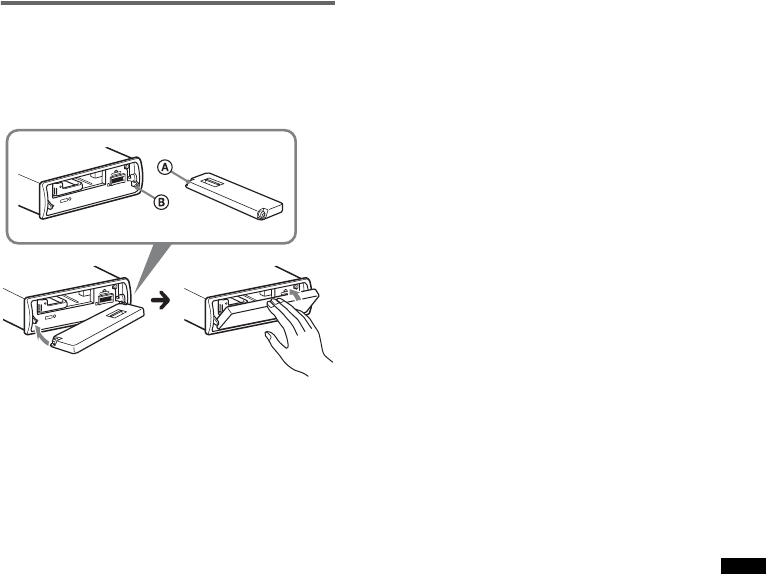
9
Colocación del panel frontal
Coloque el orificio A del panel frontal en el eje
B de la unidad y, a continuación, presione
ligeramente el lado izquierdo hacia adentro.
Presione (SOURCE/OFF) en la unidad para
utilizarla.
Nota
No coloque nada sobre la superficie interior del panel
frontal.

10
Guía rápida para la función Bluetooth
Para obtener información completa acerca del funcionamiento, consulte “Bluetooth (Llamadas con
manos libres y transmisión de música)” (página 33) y las instrucciones de funcionamiento del
dispositivo Bluetooth.
Tres pasos para el funcionamiento de Bluetooth
1Emparejamiento
Primero, registre (“empareje”) el dispositivo Bluetooth (teléfono celular, etc.) con esta unidad. El
emparejamiento solamente se debe realizar la primera vez que se utiliza la unidad.
2Conexión
Una vez realizado el emparejamiento, conecte esta unidad y el dispositivo Bluetooth. Según el
dispositivo, la conexión se puede realizar en forma automática junto con el emparejamiento.
3Llamadas con manos libres/Transmisión de música/Reproducción en Pandora
Por medio de esta unidad, usted puede realizar/recibir una llamada con manos libres, escuchar
audio y la radio por Internet Pandora.
Sitio web de asistencia al cliente
http://esupport.sony.com
http://www.sony.com/mobileAV
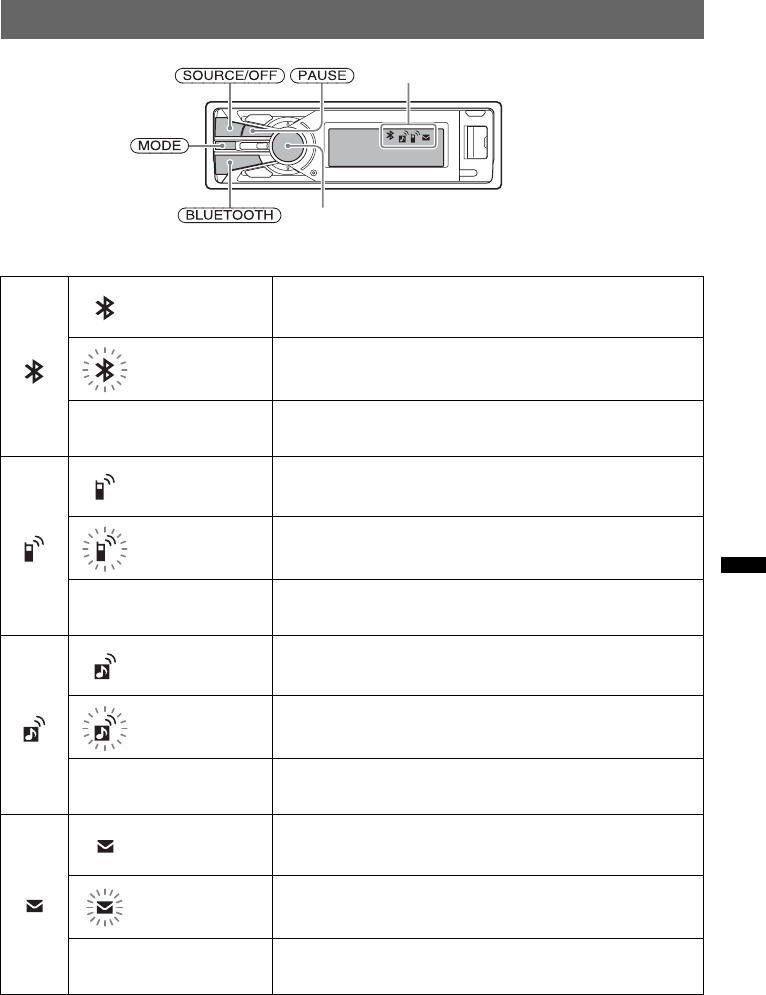
11
Botones e iconos
Descripciones de los iconos de estado
Encendido La señal de Bluetooth está activada.
Parpadea El emparejamiento está en modo de espera.
Ninguno La señal de Bluetooth está desactivada.
Encendido Conectado a un teléfono celular.
Parpadea Conexión en progreso.
Ninguno No hay ningún teléfono celular conectado para realizar
llamadas con manos libres.
Encendido Conectado al dispositivo.
Parpadea Conexión en progreso.
Ninguno No hay ningún dispositivo conectado para la transmisión de
música.
Encendido Hay mensajes SMS sin leer.
Parpadea Se ha recibido un mensaje SMS.
Ninguno No hay mensajes SMS sin leer.
Iconos
Codificador multidireccional

12
1Emparejamiento
2Conexión
Nota
Puede conectar esta unidad a un dispositivo Bluetooth (página 35).
Si no puede conectar esta unidad a un dispositivo Bluetooth, realice el emparejamiento de nuevo.
Dispositivo
utilizado
Funcionamiento
1Mantenga presionado (BLUETOOTH) durante más de 2 segundos.
2Busque esta unidad.
3
4Si se requiere una clave de paso en la pantalla del dispositivo que se desea
conectar, introduzca “0000”.
5Siga las instrucciones que aparezcan en la pantalla.
6
Dispositivo
utilizado
Funcionamiento
1Presione (BLUETOOTH).
2Realice la conexión a esta unidad mediante un teléfono celular.
Realice la conexión a esta unidad mediante un dispositivo de audio.
t
XXXXXXX
DR-BT30Q
Sony
Automotive
Seleccione “Sony Automotive”.
(Emparejamiento exitoso)
t
t
t

13
3Llamadas con manos libres y transmisión de música
Realización de llamadas con manos libres
Transmisión de música
*La operación puede variar en función del dispositivo de audio.
Reproducción en Pandora
Para Funcionamiento
Recibir o finalizar una llamada Presione el codificador multidireccional.
Rechazar una llamada Presione (SOURCE/OFF).
Volver a marcar 1Presione (SOURCE/OFF) varias veces hasta que aparezca
“Bluetooth Phone”.
2Mantenga presionado el codificador multidireccional
durante más de 2 segundos.
Transferir una llamada Presione (MODE).
Para Funcionamiento
Escuchar música 1Presione (SOURCE/OFF) varias veces hasta que aparezca
“Bluetooth Audio”.
2Inicie la reproducción en el dispositivo de audio.
Reproducir/pausar* Presione (PAUSE).
Omitir pistas* Presione el codificador multidireccional hacia la izquierda o
hacia la derecha.
Para Funcionamiento
Escuchar música 1Presione (SOURCE/OFF) varias veces hasta que aparezca
“Please launch Pandora App on mobile device and press
(PAUSE) on this unit.”.
2Inicie Pandora en el dispositivo Bluetooth.
3Presione (PAUSE).
Reproducir/pausar Presione (PAUSE).
Omitir pistas Presione el codificador multidireccional hacia la derecha.
t
t
t
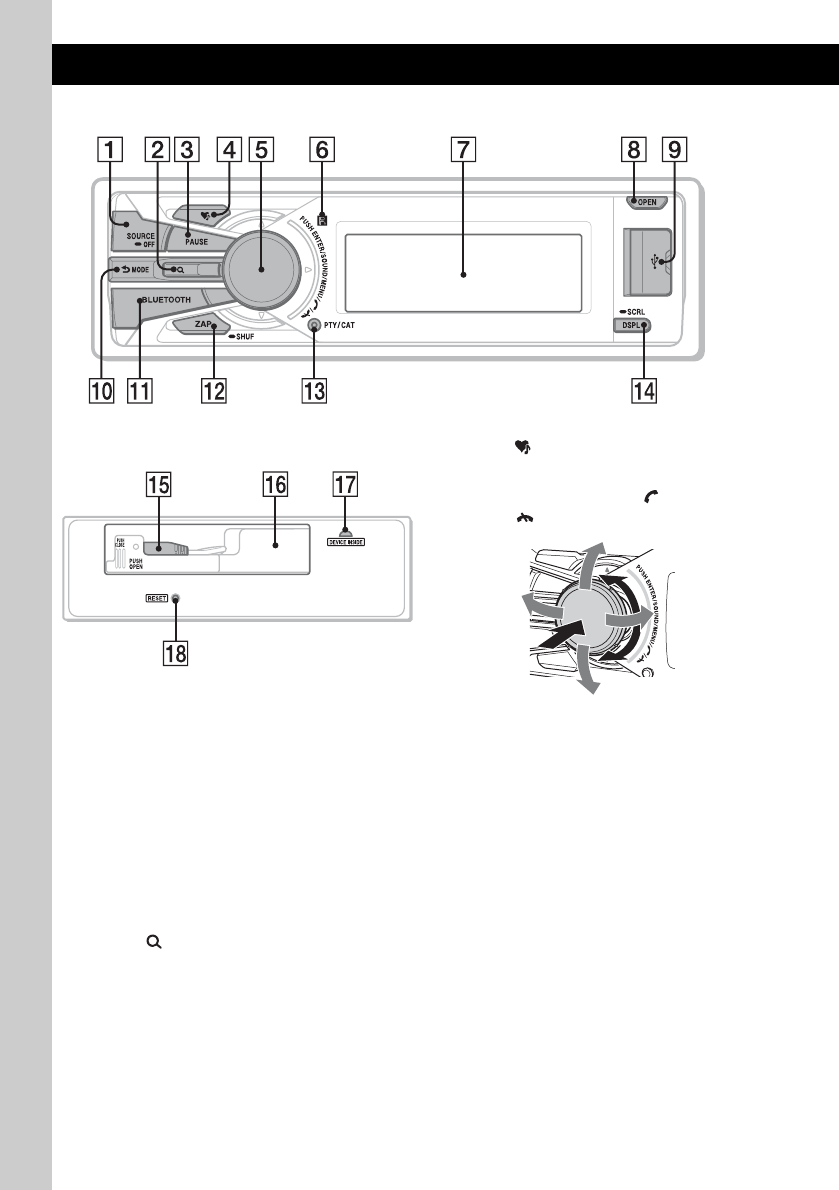
14
Ubicación de los controles y operaciones básicas
Unidad principal
Panel frontal extraído
Este apartado contiene instrucciones acerca de la
ubicación de los controles y las operaciones
básicas. Consulte las páginas indicadas para
obtener información detallada.
ABotón SOURCE/OFF*1
Presiónelo para encender la unidad o
cambiar la fuente (Radio/USB/SensMe™*2/
Pandora USB/audio Bluetooth/Bluetooth
Pandora/teléfono Bluetooth).
Presione 1 segundo para apagar la unidad.
Presione durante 2 segundos o más para
apagar la alimentación y la pantalla
desaparecerá.
BBotón (BROWSE) *3 página 18, 31,
35, 38
Para visualizar un listado (Radio); acceder al
modo Quick-BrowZer™ (USB); ubicar la
estación en una lista (Pandora USB/
Bluetooth Pandora); visualizar la agenda
telefónica (teléfono Bluetooth).
CBotón PAUSE
Para pausar la reproducción. Para cancelar
esta función, vuelva a presionarlo.
DBotón (SensMe™) página 24
ECodificador multidireccional (botón
ENTER/SOUND/MENU/ (manos
libres)/ (finalizar llamada))
Gírelo para: ajustar el volumen/seleccionar
un elemento de menú.
Presiónelo hacia arriba/abajo/izquierda/
derecha para: seleccionar un elemento de
menú.
Presiónelo para: introducir un ajuste de
sonido/aplicar un ajuste.
Manténgalo presionado para: entrar en el
menú.
Radio:
Presiónelo hacia arriba/abajo para:
– recibir una emisora almacenada.
Presiónelo hacia la izquierda/derecha para:
– sintonizar emisoras en forma automática
(presionar).
– buscar emisoras en forma manual
(manténgalo presionado).

15
USB:
Presiónelo hacia arriba/abajo para:
– omitir álbumes (presionar).
– omitir álbumes en forma continua
(mantener presionado).
Presiónelo hacia la izquierda/derecha para:
– omitir pistas (presionar).
– omitir pistas en forma continuada
(presiónelo una vez, vuelva a presionarlo
transcurridos aproximadamente 2 segundos
y manténgalo presionado).
– retroceder o avanzar una pista (manténgalo
presionado).
Pandora USB:
Presiónelo hacia la derecha para:
– omitir pistas
Presiónelo hacia arriba/abajo para:
– pulgares arriba/abajo (presione durante 1
segundo).
Audio Bluetooth*4:
Presiónelo hacia la izquierda/derecha para:
– omitir pistas (presionar).
– retroceder o avanzar una pista (manténgalo
presionado).
Bluetooth Pandora:
Presiónelo hacia la derecha para:
– omitir pistas
Presiónelo hacia arriba/abajo para:
– pulgares arriba/abajo (presione durante 1
segundo).
Teléfono Bluetooth:
Presiónelo para recibir o finalizar una
llamada.
Manténgalo presionado para volver a marcar.
FReceptor del control remoto de tarjeta
GVisualizador
HBotón OPEN página 8
IConector USB (externo) página 21, 26
Para conectar al dispositivo USB.
JBotón (BACK)/MODE
Presiónelo para: seleccionar la banda de
radio (FM/AM)*1, cambiar el dispositivo
USB (interno/externo) o volver a la pantalla
anterior.
Manténgalo presionado para: acceder al
modo de control del pasajero o cancelarlo*5/
acceder al modo de marcadores (Pandora
USB/Bluetooth Pandora).
KBotón BLUETOOTH página 34
Para activar y desactivar la señal de
Bluetooth, emparejamiento.
LBotón ZAP/SHUF página 22, 28, 33
Para acceder al modo ZAPPIN™
(presionar); para seleccionar el modo de
reproducción aleatoria (mantener
presionado).
MBotón PTY/CAT*6 página 19
Para seleccionar PTY en RDS.
NBotón DSPL (pantalla)/SCRL
(desplazamiento) página 22, 27
Para cambiar los elementos de pantalla
(presionar); para desplazar el elemento de la
pantalla (mantener presionado).
OConector USB (interno) página 20, 26
Para conectar al dispositivo USB.
PTUNE TRAY página 20, 25
Bandeja para colocar un dispositivo USB o
un iPod.
QLED de Device Inside Alert página 48
RBotón RESET página 7
*1 Si hay un sintonizador de HD Radio o sintonizador
SAT está conectado: cuando presione
(SOURCE/OFF) el dispositivo conectado (“HD”,
“XM” o “SR”) aparecerá en la pantalla. Además, si
presiona (MODE), podrá cambiar la banda del
sintonizador de HD Radio o la banda del
sintonizador SAT.
*2 Cuando se conecta un dispositivo USB
configurado para la función SensMe™.
*3 Si hay un sintonizador de HD Radio o sintonizador
SAT conectado: la lista incluirá HD Radio o SAT
Radio según corresponda.
*4 Cuando se conecta un dispositivo de audio
Bluetooth (compatible con AVRCP de la tecnología
Bluetooth). Según el dispositivo, es posible que
algunas funciones no estén disponibles.
*5 Cuando se conecta un iPod al conector USB
(externo).
*6 Si el sintonizador SAT está conectado.
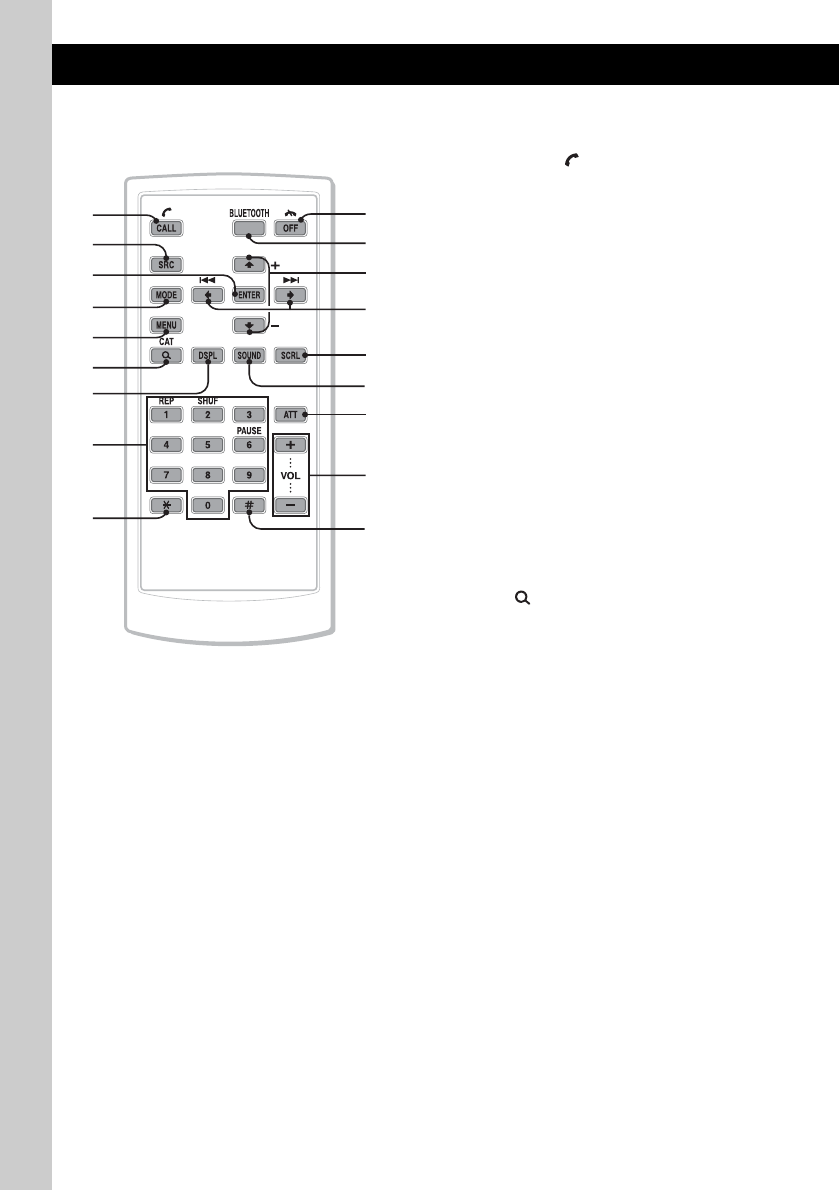
16
Control remoto de tarjeta
RM-X306
Retire la película de aislamiento antes de usar la
unidad (página 8).
ABotón CALL/ (manos libres)
Para cambiar la fuente (teléfono Bluetooth).
Teléfono Bluetooth:
Para recibir una llamada.
BBotón SRC (fuente)*1
Para encender la unidad; cambiar la fuente
(radio/USB/SensMe™*2/Pandora USB/
audio Bluetooth/Bluetooth Pandora/teléfono
Bluetooth).
CBotón ENTER
Para aplicar un ajuste.
DBotón MODE
Presiónelo para: seleccionar la banda de
radio (FM/AM)*1, cambiar el dispositivo
USB (interno/externo).
Manténgalo presionado para: acceder al
modo de control del pasajero o cancelarlo*3/
acceder al modo de marcadores (Pandora
USB/Bluetooth Pandora).
EBotón MENU
Para entrar en el menú.
FBotón (BROWSE)/CAT*4
Para visualizar un listado (Radio); acceder al
modo Quick-BrowZer™ (USB); ubicar la
estación en una lista (Pandora USB/
Bluetooth Pandora); visualizar la agenda
telefónica (teléfono Bluetooth).
GBotón DSPL (pantalla)
Para cambiar los elementos en pantalla.
HBotones numéricos
Radio:
(1) a (6):
Para recibir las emisoras almacenadas
(presionar); para almacenar emisoras
(mantener presionado).
USB:
(1): REP página 22, 28
(2): SHUF página 22, 28
(6): PAUSE
Para pausar la reproducción. Para
cancelar esta función, vuelva a
presionarlo.
Pandora USB:
(6): PAUSE página 30
Para pausar la reproducción. Para
cancelar esta función, vuelva a
presionarlo.
qd
qs
qf
qh
qj
qg
qk
2
3
4
1
5
6
9
7
8
0
qa

17
Audio Bluetooth*5:
(1): REP página 40
(2): SHUF página 40
(6): PAUSE página 40
Para pausar la reproducción. Para
cancelarla, vuelva a presionar la tecla.
Bluetooth Pandora:
(6): PAUSE página 41
Para pausar la reproducción. Para
cancelar esta función, vuelva a
presionarlo.
Teléfono Bluetooth:
Para introducir números (números de
teléfono, etc.).
IBotón página 36, 37
JBotón OFF/ (finalizar llamada)
Para apagar la unidad; detener la fuente;
finalizar o rechazar una llamada.
KBotón BLUETOOTH página 34
Para activar y desactivar la señal de
Bluetooth, emparejamiento.
LBotones M (+)/m (–)
Realizan las mismas funciones que cuando
se presiona el codificador multidireccional
hacia arriba o hacia abajo en la unidad.
MBotones < (.)/, (>)
Realizan las mismas funciones que cuando
se presiona el codificador multidireccional
hacia la izquierda o hacia la derecha en la
unidad.
NBotón SCRL (desplazamiento)
Para desplazar el elemento de la pantalla.
OBotón SOUND
Para introducir los ajustes de sonido.
PBotón ATT (atenuación)
Para atenuar el sonido. Para cancelar esta
función, vuelva a presionarlo.
QBotón VOL (volumen) +/–
Para ajustar el volumen.
RBotón página 36, 37
*1 Si hay un sintonizador HD Radio o SAT conectado:
cuando se presiona (SRC), el dispositivo
conectado (“HD,” “XM” o “SR”) aparecerá en
pantalla.
Además, si presiona (MODE), podrá cambiar la
banda del sintonizador de HD Radio o la banda del
sintonizador SAT.
*2 Cuando se conecta un dispositivo USB
configurado para la función SensMe™.
*3 Cuando se conecta un iPod al conector USB
(externo).
*4 Si el sintonizador SAT está conectado.
*5 Cuando se conecta un dispositivo de audio
Bluetooth (compatible con AVRCP de la tecnología
Bluetooth). Según el dispositivo, es posible que
algunas funciones no estén disponibles.
Nota
Si la unidad está apagada y desaparece la indicación
de pantalla, no se podrá utilizar con el control remoto
de tarjeta salvo que se presione (SOURCE/OFF) en la
unidad para activarla en primer lugar.
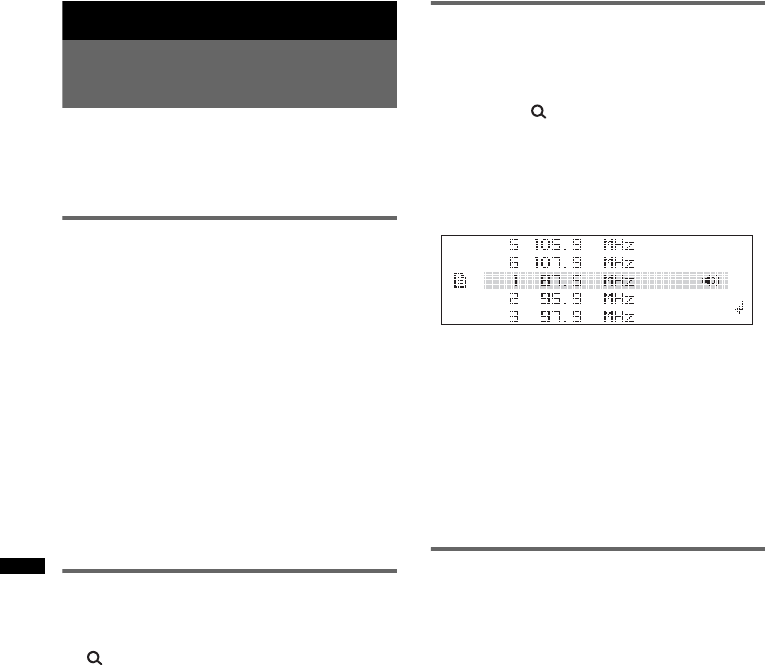
18
Radio
Almacenamiento y recepción
de emisoras
Precaución
Para sintonizar emisoras mientras maneja, utilice
la función BTM (Memoria de la mejor sintonía)
para evitar accidentes.
Almacenamiento automático
— BTM
1Presione (SOURCE/OFF) varias veces
hasta que aparezca “TUNER”.
Para cambiar de banda, presione (MODE)
varias veces. Puede seleccionar entre FM1,
FM2, FM3, AM1 y AM2.
2Mantenga presionado el codificador
multidireccional.
3Gire el codificador multidireccional
para seleccionar el ajuste “BTM” y, a
continuación, presiónelo.
La unidad almacena las emisoras en el orden
de frecuencia de la lista de presintonías.
La unidad emite un pitido al almacenar el
ajuste.
Almacenamiento manual
1Cuando reciba la emisora que desea
almacenar, presione el botón
(BROWSE).
Aparecerá la lista de presintonías.
2Presione el codificador
multidireccional hacia arriba y hacia
abajo para seleccionar el número de
presintonía.
3Manténgalo presionado hasta que
aparezca “MEM”.
(con el control remoto de tarjeta)
1Mientras recibe la emisora que desea
almacenar, mantenga presionado un
botón numérico (de (1) a (6)) hasta
que aparezca “MEM”.
Nota
Si intenta almacenar otra emisora en el mismo botón
numérico, se reemplazará la que estaba almacenada
previamente.
Recepción de las emisoras
almacenadas
Puede visualizar un listado de las frecuencias.
1Seleccione la banda y, a continuación,
presione (BROWSE).
Aparecerá la lista de presintonías.
2Presione el codificador
multidireccional hacia arriba y hacia
abajo para seleccionar la emisora
deseada.
3Presione el codificador
multidireccional para recibir la
emisora.
La pantalla vuelve al modo de recepción
normal.
(con el control remoto de tarjeta)
1Seleccione la banda y, a continuación,
presione un botón numérico (de (1) a
(6)).
Sintonización automática
1Seleccione la banda y presione el
codificador multidireccional hacia la
izquierda o hacia la derecha para
buscar la emisora.
La búsqueda se detiene cuando la unidad
recibe una emisora. Repita este
procedimiento hasta recibir la emisora
deseada.
Sugerencia
Si conoce la frecuencia de la emisora que desea
escuchar, mantenga presionado el codificador
multidireccional hacia la izquierda o hacia la derecha
para localizar rápidamente la frecuencia aproximada
y, a continuación, presione dicho codificador hacia la
izquierda o hacia la derecha varias veces para ajustar
la frecuencia deseada con mayor precisión
(sintonización manual).
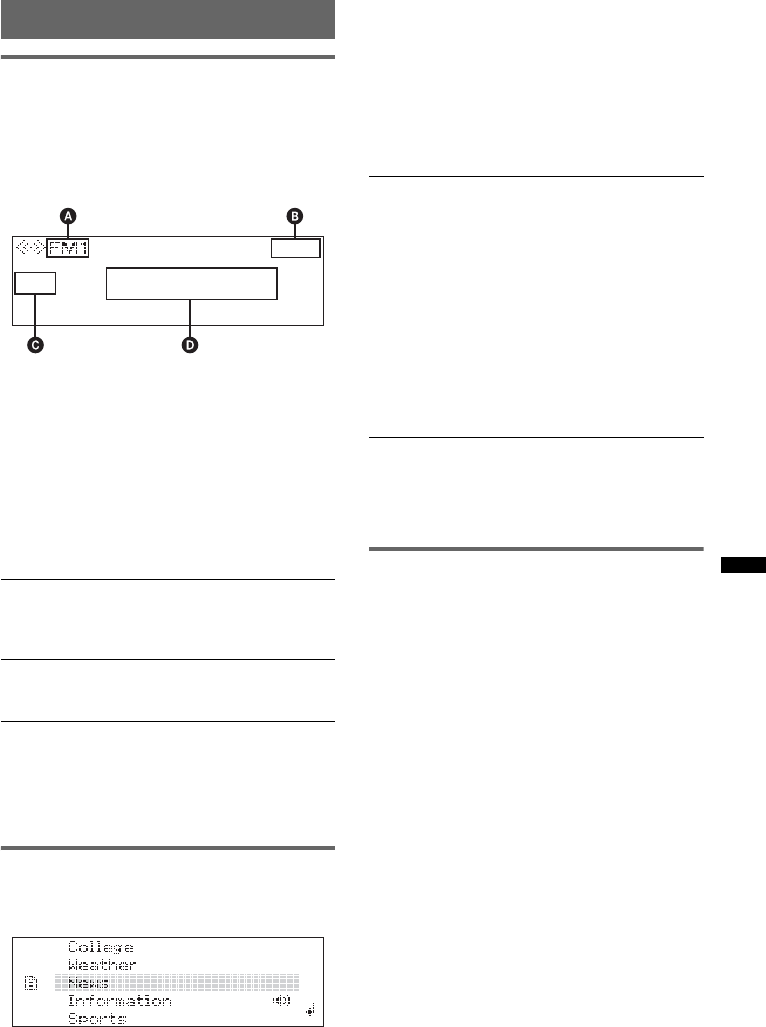
19
RDS
Descripción general
Las emisoras de radio FM que tienen el servicio
de Sistema de datos de radio (RDS) envían
información digital inaudible junto a la señal
habitual del programa de radio.
Elementos de la pantalla
ABanda de radio
BReloj
CNúmero de presintonía
DFrecuencia* (nombre del servicio de
programa), datos de RDS
*Mientras recibe la emisora RDS, aparece “RDS” a la
izquierda de la indicación de la frecuencia.
Servicios RDS
Esta unidad suministra automáticamente
servicios RDS como sigue:
Notas
•Dependiendo del país o región, puede que no estén
disponibles todas las funciones RDS.
•RDS no funcionará si la intensidad de la señal es
muy débil o si la emisora que sintonizó no transmite
datos RDS.
Selección de PTY
1Presione (PTY) durante la recepción
FM.
Si la emisora está transmitiendo datos PTY
aparece el nombre del tipo de programa
actual.
2Gire el codificador multidireccional
para seleccionar el tipo de programa
deseado.
3Presione el codificador
multidireccional.
La unidad comienza a buscar una emisora que
emita el tipo de programa seleccionado.
Tipos de programas
Notas
•No puede usar esta función en países o regiones
donde no hay disponibles datos PTY.
•Puede recibir un programa de radio distinto del que
seleccionó.
Ajuste de CT
1Ajuste “CT on” en la configuración
(página 46).
Notas
•Puede que la función CT no funcione a pesar de
que se reciba una emisora RDS.
•Puede haber una diferencia entre la hora ajustada
por la función CT y la hora real.
PTY (Tipos de programa)
Muestra el tipo de programa que se recibe
actualmente. También busca el tipo de
programa seleccionado.
CT (Hora del reloj)
Los datos CT de la transmisión RDS ajustan el
reloj.
News (Noticias), Information (Información),
Sports (Deportes), Talk (Conversación), Rock
(Rock), Classic Rock (Rock clásico), Adult
Hits (Éxitos para el adulto), Soft Rock (Rock
suave), Top 40 (Top 40), Country (Country),
Oldies (Música de décadas pasadas), Soft
(Lentos), Nostalgia (Nostalgia), Jazz (Jazz),
Classical (Clásica), Rhythm and Blues
(R&B), Soft R&B (R&B suave), Foreign
Language (Idiomas extranjeros), Religious
Music (Música religiosa), Religious Talk
(Conversación religiosa), Personality
(Personalidad), Public (Público), College
(Universidad), Weather (El tiempo)
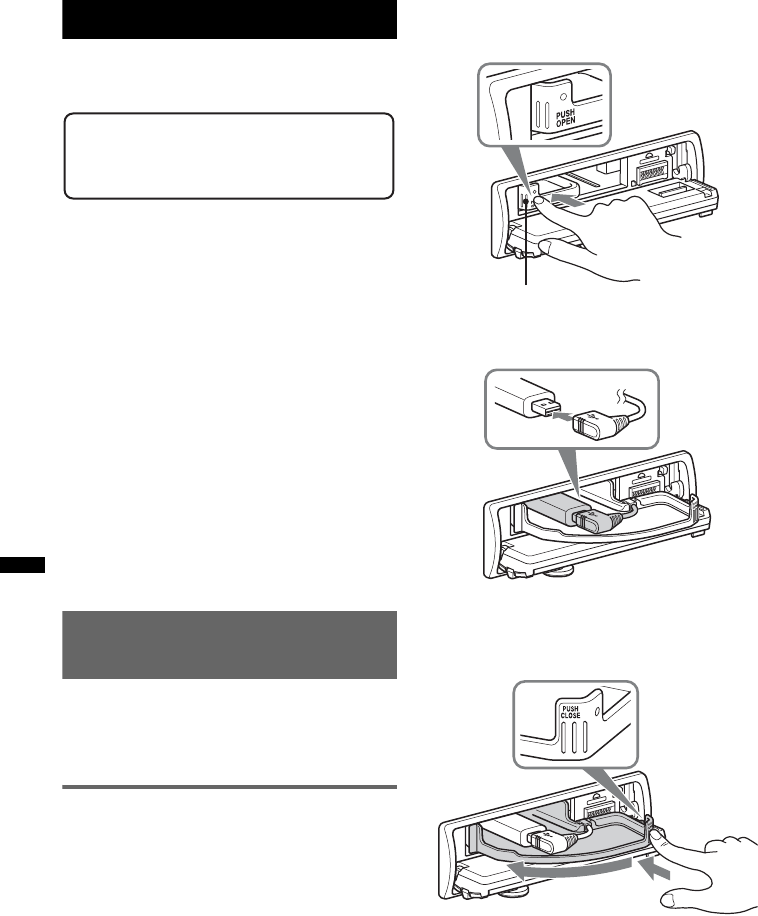
20
Dispositivos USB
Para obtener más información acerca de la
compatibilidad del dispositivo USB, visite el
sitio web de soporte técnico.
• Es posible utilizar dispositivos USB de
almacenamiento masivo (MSC) que cumplan
con el estándar USB.
• Los códecs correspondientes son MP3 (.mp3),
WMA (.wma), AAC (.m4a) y AAC (.mp4).
• Se recomienda realizar una copia de seguridad
de los datos almacenados en los dispositivos
USB.
Notas
•Conecte el dispositivo USB después de arrancar el
motor.
En función del tipo de dispositivo USB, si lo conecta
a la computadora antes de arrancar el motor, es
posible que este no funcione correctamente o que
se dañe.
•No coloque un teléfono celular o un dispositivo con
funciones de comunicación inalámbrica en la TUNE
TRAY, ya que es posible que no reciba señales
telefónicas o que la comunicación se corte.
•No deje un dispositivo USB dentro de un automóvil
estacionado, ya que podrían producirse fallas de
funcionamiento.
Reproducción de un dispositivo
USB
Se puede conectar un dispositivo USB en los
conectores USB internos o externos, o en ambos.
Para cambiar entre dispositivos USB, presione
(MODE).
Reproducción mediante el
conector USB (interno)
1Presione (OPEN).
El panel frontal se voltea hacia abajo.
2Presione PUSH OPEN en la TUNE
TRAY.
La TUNE TRAY se abrirá lentamente.
3Conecte el dispositivo USB al
conector USB.
4Deslice hacia adentro la TUNE TRAY
presionando PUSH CLOSE en la TUNE
TRAY hasta que se cierre
completamente.
5Cierre el panel frontal.
6Presione (SOURCE/OFF) varias veces
hasta que aparezca “USB” y, a
continuación, presione (MODE) para
cambiar el dispositivo USB.
Aparece “USB Internal”, y se inicia la
reproducción.
Sitio Web de soporte técnico en línea
http://esupport.sony.com
http://www.sony.com/mobileAV
TUNE TRAY
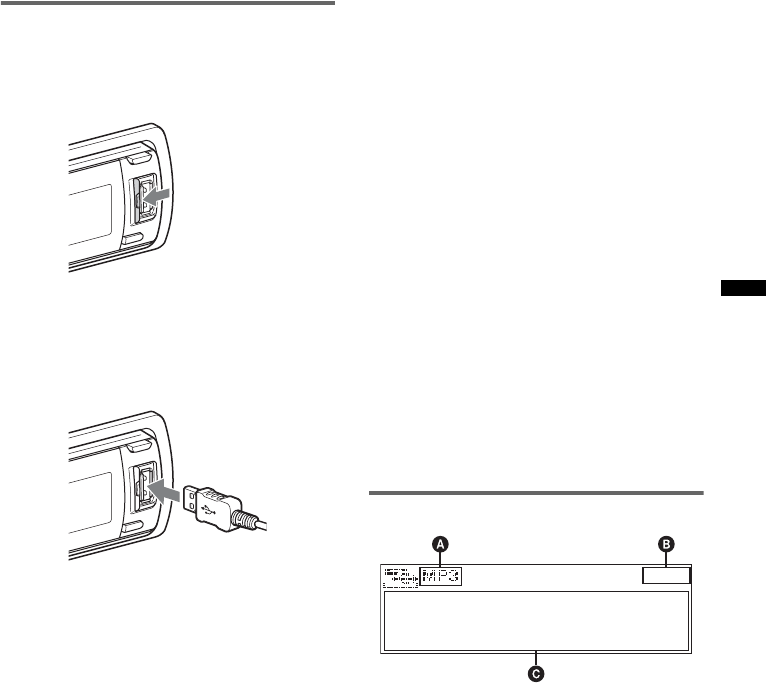
21
Si ya hay un dispositivo USB conectado, repita el
paso 6 para empezar la reproducción.
Mantenga presionado (SOURCE/OFF) durante 1
segundo para detener la reproducción.
Extracción del dispositivo USB
1Detenga la reproducción del dispositivo USB.
2Presione (OPEN).
3Presione PUSH OPEN en la TUNE TRAY.
4Extraiga el dispositivo USB.
5Deslice hacia adentro la TUNE TRAY y cierre
el panel frontal.
Reproducción mediante el
conector USB (externo)
1Deslice la cubierta del dispositivo
USB.
2Conecte el dispositivo USB al
conector USB.
Cuando utilice un cable, use el que se ha
suministrado para la conexión con el
dispositivo USB.
3Presione (SOURCE/OFF) varias veces
hasta que aparezca “USB” y, a
continuación, presione (MODE) para
cambiar el dispositivo USB.
Aparece “USB External”, y se inicia la
reproducción.
Si ya hay un dispositivo USB conectado, repita el
paso 3 para empezar la reproducción.
Mantenga presionado (SOURCE/OFF) durante
1 segundo para detener la reproducción.
Extracción del dispositivo USB
1Detenga la reproducción del dispositivo USB.
2Extraiga el dispositivo USB.
Notas para dispositivos USB
•No extraiga el dispositivo USB durante la
reproducción o, de lo contrario, los datos del USB
podrían dañarse.
•No coloque dispositivos que no sean USB en la
TUNE TRAY, ni objetos extraños, como monedas,
llaves, tarjetas, líquidos, etc.
•No coloque objetos inflamables como un
encendedor en la TUNE TRAY, ya que podría
producir humo, un incendio u otro tipo de accidente.
•Capacidad de la bandeja: aprox. 65 × 17 × 118 mm
(an/al/prf)
•Si el dispositivo USB solo o combinado con el cable
USB no se puede colocar fácilmente en la TUNE
TRAY, es posible que el dispositivo haya superado la
capacidad permitida de la bandeja.
No deslice hacia adentro la TUNE TRAY a la fuerza
ni el cable USB.
•Para los usuarios de “WALKMAN”, se recomienda la
utilización del adaptador opcional XA-50WM. Su
uso está designado para esta unidad solamente (en
TUNE TRAY) y no debería usarse con otro
dispositivo USB.
•Esta unidad no puede reconocer dispositivos USB a
través de un concentrador USB.
•Deslice hacia adentro la bandeja TUNE TRAY y
cierre el panel frontal antes de reproducir, ya que
podrían producirse daños en caso de una
obstrucción en el vehículo, etc.
•Si el panel frontal no se abre por completo por la
forma del tablero en la posición de instalación,
desconéctelo y abra la bandeja TUNE TRAY en
forma manual.
Para obtener más información acerca de cómo
extraer el panel frontal, consulte la página 8.
•Es extremadamente peligroso conectar o extraer el
dispositivo USB mientras se maneja.
•No utilice dispositivos USB demasiado grandes o
pesados, ya que se podrán caer debido a la
vibración, o bien, provocar una conexión deficiente.
•Si el USB se desconecta durante la reproducción,
aparecerá “NO Device” en la pantalla de la unidad.
Elementos de la pantalla
AIndicación de la fuente (MP3/WMA/AAC)
BReloj
CNombre del artista/Nombre del álbum,
Nombre de la pista, Número de carpeta/
Número de pista/Tiempo de reproducción
transcurrido
continúa en la página siguiente t
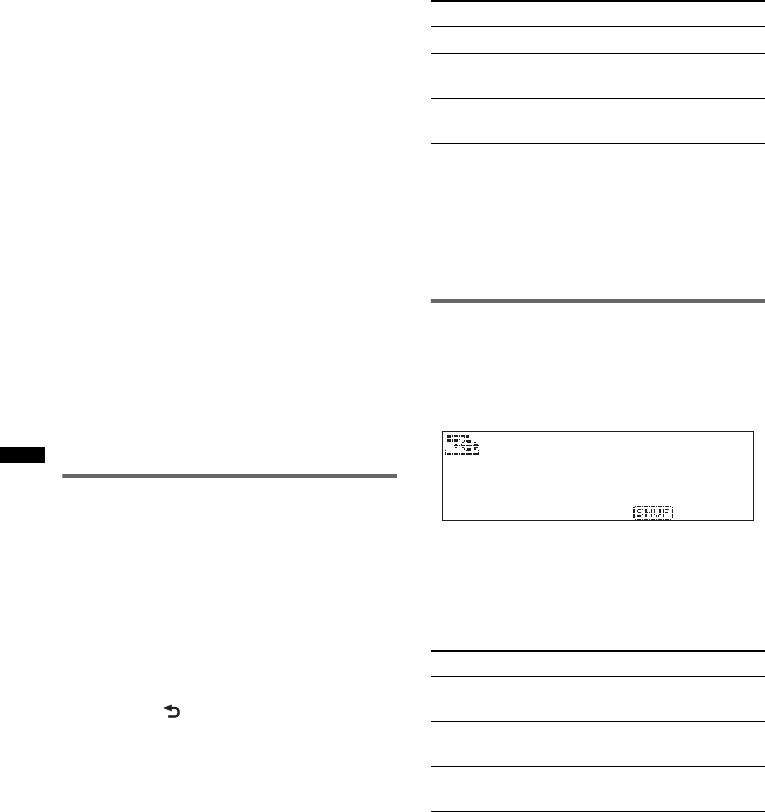
22
Para cambiar los elementos de la pantalla C,
presione (DSPL).
Notas
•Los elementos que se muestran variarán en función
del tipo de dispositivo USB, el formato de grabación
y los ajustes. Para obtener más información, visite el
sitio web de soporte técnico.
•El número máximo de datos que se pueden
visualizar es el siguiente.
– carpetas (álbumes): 65 535*
– archivos (pistas): 5 000
•No deje un dispositivo USB dentro de un automóvil
estacionado, ya que podrían producirse fallas de
funcionamiento.
•Es posible que el inicio de la reproducción demore
un poco, en función de la cantidad de datos
grabados.
•Es posible que no se puedan reproducir archivos
DRM (Gestión de derechos digitales).
•Durante la reproducción de un archivo MP3/WMA/
AAC de VBR (Velocidad de bits variable) o al
avanzar o retroceder rápidamente, es posible que el
tiempo de reproducción transcurrido no se muestre
con precisión.
•No es posible reproducir los archivos MP3/WMA/
AAC que se indican a continuación.
– archivos con formato de compresión sin pérdida
– archivos protegidos por derechos de autor
*La cantidad máxima de carpetas recomendada es
de 5 000. Si la cantidad de carpetas supera este
número, es posible que la búsqueda en archivos o
carpetas demore más tiempo.
Es posible que la cantidad de carpetas no se
visualice correctamente si supera los 9 999.
Reproducción repetida
1Mantenga presionado el codificador
multidireccional.
2Gire el codificador multidireccional
para seleccionar el ajuste “Repeat” y,
a continuación, presiónelo.
3Gire el codificador multidireccional
para seleccionar el ajuste y, a
continuación, presiónelo.
El ajuste finalizó.
4Presione (BACK).
El ajuste finaliza y la pantalla regresa al modo
de recepción/reproducción normal.
(con el control remoto de tarjeta)
1Durante la reproducción, presione (1)
(REP) varias veces hasta que aparezca
el ajuste deseado.
Después de 3 segundos, se completa el ajuste.
*1 Disponible al seleccionar pistas por “Album” o
“Folder & File” con Quick-BrowZer (consulte la
página 31).
*2 Disponible al seleccionar pistas por “Artist” con
Quick-BrowZer (consulte la página 31).
Para regresar al modo de reproducción normal,
seleccione “Repeat off”.
Reproducción aleatoria
1Durante la reproducción, mantenga
presionado (ZAP/SHUF).
2Presione (ZAP/SHUF) varias veces
hasta que aparezca el ajuste deseado.
(con el control remoto de tarjeta)
1Durante la reproducción, presione (2)
(SHUF) varias veces hasta que
aparezca el ajuste deseado.
Después de 3 segundos, se completa el ajuste.
*1 Disponible al seleccionar pistas por “Album” o
“Folder & File” con Quick-BrowZer (consulte la
página 31).
*2 Disponible al seleccionar pistas por “Artist” con
Quick-BrowZer (consulte la página 31).
*3 Disponible al seleccionar pistas por “Track” o
“Folder & File” con Quick-BrowZer (consulte la
página 31).
Seleccione Para reproducir
Repeat Track pistas en forma repetida.
Repeat Album*1álbumes en forma
repetida.
Repeat Artist*2artistas en forma
repetida.
Seleccione Para reproducir
Shuffle Album*1álbumes en orden
aleatorio.
Shuffle Artist*2artistas en orden
aleatorio.
Shuffle Device*3dispositivos en orden
aleatorio.
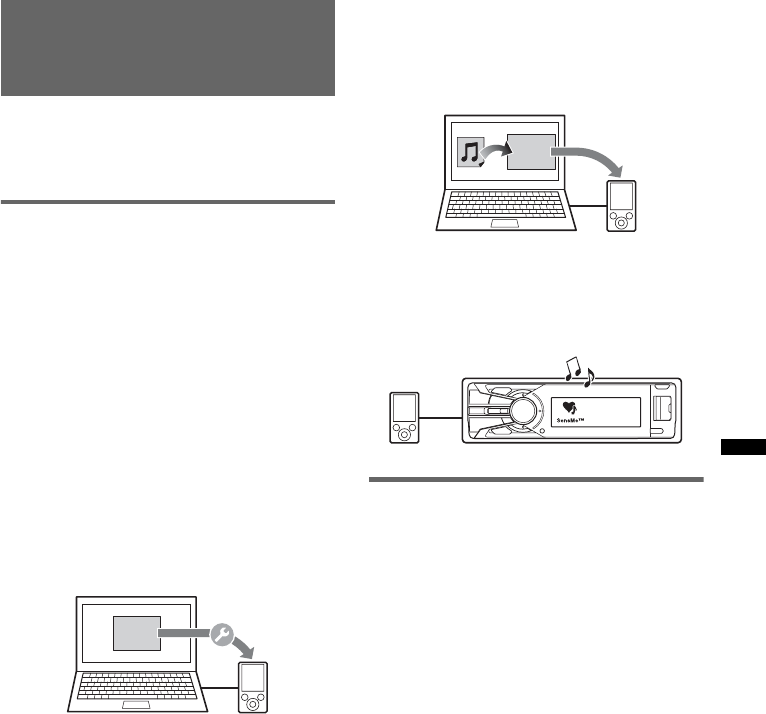
23
Para regresar al modo de reproducción normal,
seleccione “off”.
Nota
La reproducción de pistas en el modo aleatorio se
selecciona desde el dispositivo USB actual.
Reproducción de música según
su estado de ánimo
— SensMe™
Las funciones exclusivas de “SensMe™
channels” de Sony agrupan automáticamente las
pistas por canal y permiten disfrutar música de
modo intuitivo.
Antes de utilizar la función
SensMe™
Este es el procedimiento básico necesario para
disfrutar la función SensMe™ en la unidad.
1Descargue el software “SensMe™
Setup” y “Content Transfer” desde el
sitio de soporte
2Instale el software en su computadora
Para obtener más información sobre la
instalación, visite
http://esupport.sony.com
o
http://www.sony.com/mobileAV
3Registro de un dispositivo USB
mediante “SensMe™ Setup”
Conecte un dispositivo USB al equipo y
realice el registro con “SensMe™ Setup” para
activar la función SensMe™ en esta unidad.
Sugerencia
El registro se puede realizar junto con el
procedimiento de instalación o después de la
instalación.
4Transferencia de pistas al dispositivo
USB mediante “Content Transfer”
Para agrupar las pistas por canal, 12 TONE
ANALYSIS™, que está cargado en “Content
Transfer”, debe analizar los patrones de
sonido de las pistas.
Con el dispositivo USB conectado al equipo,
arrastre las pistas de Windows Explorer o
iTunes, etc., y colóquelas en “Content
Transfer”.
“Content Transfer” analizará y transferirá las
pistas.
5Conexión del dispositivo USB y uso de
la función SensMe™ en la unidad
Conecte el dispositivo USB configurado.
Luego, podrá disfrutar “SensMe™ channels”
en la unidad.
Instalación de “SensMe™ Setup” y
“Content Transfer” en el equipo
Para activar la función SensMe™ en esta unidad
se requiere el software (“SensMe™ Setup” y
“Content Transfer”).
1Descargue el software “SensMe™
Setup” y “Content Transfer” desde el
sitio de soporte.
2Instale el software en su computadora.
Para obtener más información sobre la
instalación, visite
http://esupport.sony.com
o
http://www.sony.com/mobileAV
SensMe™
Setup
Content
Transfer

24
Registro de un dispositivo USB
mediante “SensMe™ Setup”
Para activar la función SensMe™ en esta unidad,
se debe registrar el dispositivo USB.
Si el registro no se realiza junto con el
procedimiento de instalación, siga los pasos que
aparecen a continuación.
1Inicie “SensMe™ Setup” en el equipo.
2Conecte un dispositivo USB al equipo.
3Siga las instrucciones que aparezcan
en la pantalla para completar el
registro.
Sugerencia
Si desea conectar un dispositivo USB registrado que
contiene pistas analizadas, se puede volver cancelar
el registro del dispositivo USB.
Transferencia de pistas al
dispositivo USB mediante
“Content Transfer”
Para activar la función SensMe™ en esta unidad,
las pistas se deben analizar y se deben transferir
al dispositivo USB registrado mediante “Content
Transfer”.
1Conecte el dispositivo USB registrado
al equipo.
Para dispositivos USB, conéctelos con el
modo MSC.
“Content Transfer” comienza
automáticamente.
Si aparece un mensaje, siga las instrucciones
que aparezcan en la pantalla para continuar.
2Arrastre las pistas de Windows
Explorer o iTunes, etc., y colóquelas
en “Content Transfer”.
Comenzarán el análisis y la transferencia de
pistas.
Para obtener más información acerca del
funcionamiento, consulte la Ayuda de “Content
Transfer”.
Nota
Según el entorno de su equipo, es posible que
12 TONE ANALYSIS™ demore un poco.
Reproducción de pistas en el canal
— SensMe™ channels
“SensMe™ channels” agrupa automáticamente
las pistas en canales según sus melodías. Puede
seleccionar un canal que se adecue a su estado de
ánimo o a su actividad, y reproducirlo.
Esta opción funciona con dispositivos USB
conectados en los conectores USB internos o
externos, o en ambos. Para cambiar el dispositivo
USB, presione (MODE).
1Conecte un dispositivo USB
configurado para la función
SensMe™.
2Presione (SensMe™).
Aparece la lista de canales, y se reproducen
en modo aleatorio las secciones* más
rítmicas o melódicas de las pistas.
*Es posible que no se detecten correctamente.
3Seleccione una pista de la lista de
canales con el codificador
multidireccional.
•Cambie el canal
Presione el codificador multidireccional hacia
arriba y hacia abajo para seleccionar el canal
deseado.
•Cambie la pista
Presione el codificador multidireccional hacia
la izquierda o hacia la derecha hasta que
aparezca la pista deseada y, a continuación,
presiónela.
La reproducción se iniciará desde el comienzo
de la pista actual.
Si no presiona ningún botón durante
10 segundos, la pantalla vuelve al modo de
reproducción normal.
Notas
•Según la pista, es posible que no se detecte
correctamente o que se agrupe en un canal que no
sea adecuado para el ritmo de la pista.
•Si el dispositivo USB conectado contiene muchas
pistas, es posible que “SensMe™ channels” demore
un poco en comenzar debido al proceso de lectura
de datos.
Sugerencia
Las pistas se reproducen en orden aleatorio. El orden
variará cada vez que seleccione un canal.
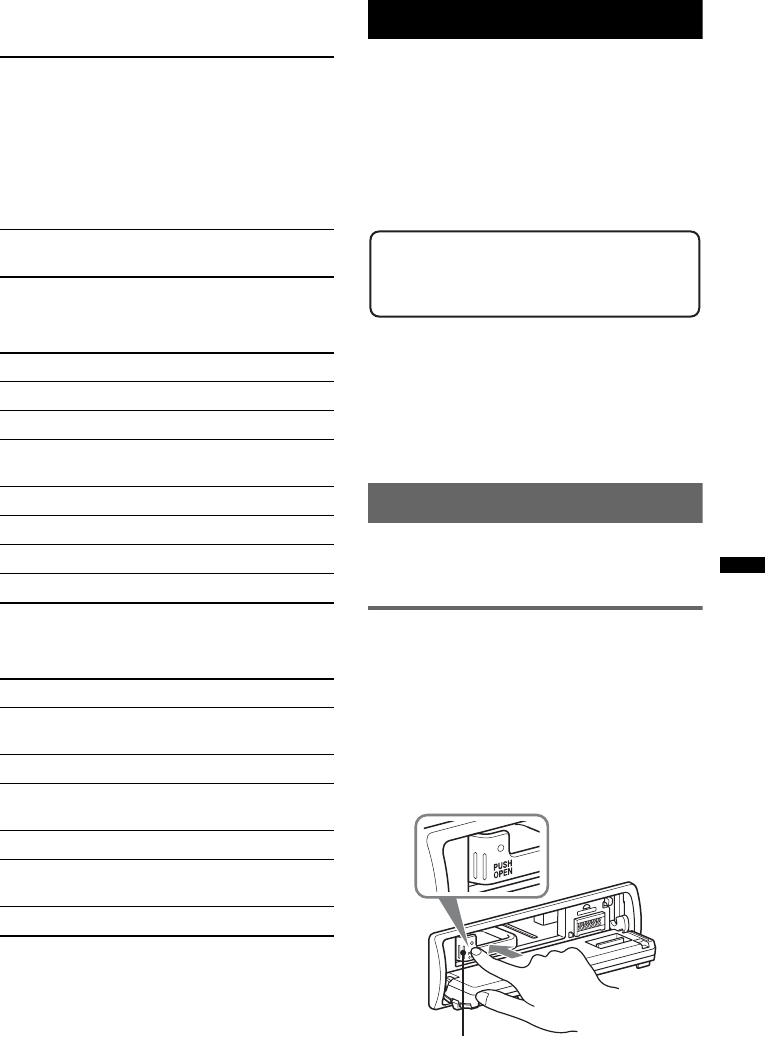
25
Lista de canales
xSe recomienda Shuffle All.
xCanales básicos
Reproduce pistas según el tipo de música.
xCanales en el automóvil
Reproduce pistas adecuadas para el manejo.
iPod
Para obtener más información acerca de la
compatibilidad de su iPod, consulte “Acerca de
iPod” (página 48) o visite el sitio web de soporte
técnico.
En las instrucciones de funcionamiento, el
“iPod” se utiliza como referencia general para las
funciones del iPod en el iPod y el iPhone, salvo
que el texto o las ilustraciones especifiquen lo
contrario.
Notas
•No coloque un teléfono celular o un dispositivo con
funciones de comunicación inalámbrica en la TUNE
TRAY, ya que es posible que no reciba señales
telefónicas o que la comunicación se corte.
•No deje un iPod dentro de un automóvil
estacionado, ya que podrían producirse fallas de
funcionamiento.
Reproducción en un iPod
Se puede conectar el iPod en los conectores USB
internos o externos, o en ambos. Para cambiar
entre dispositivos USB, presione (MODE).
Reproducción mediante el
conector USB (interno)
Antes de conectar el iPod, baje el volumen de la
unidad.
1Presione (OPEN).
El panel frontal se voltea hacia abajo.
2Presione PUSH OPEN en la TUNE
TRAY.
La TUNE TRAY se abrirá lentamente.
“Morning” (5:00 a. m. a 9:59 a. m.)
“Daytime” (10:00 a. m. a 3:59 p. m.)
“Evening” (4:00 p. m. a 6:59 p. m.)
“Night” (7:00 p. m. a 11:59 p. m.)
“Midnight” (12:00 a. m. a 4:59 a. m.)
Se recomiendan pistas para cada momento del
día.
Ajuste el reloj (página 8) para que el canal se
muestre correctamente.
“Shuffle All”: reproduce todas las pistas
analizadas en orden aleatorio.
“Energetic”: pistas movidas.
“Relax”: pistas tranquilas.
“Mellow”: pistas suaves y melancólicas.
“Upbeat”: pistas alegres para mejorar el estado
de ánimo.
“Emotional”: pistas de baladas.
“Lounge”: pistas de música funcional.
“Dance”: pistas de R&B, rap y rítmicas.
“Extreme”: pistas de rock intenso.
“Freeway”: pistas rápidas y movidas.
“Chillout Drive”: pistas de baladas entonadas
y reconfortantes.
“Weekend Trip”: pistas alegres y vivaces.
“Midnight Cruise”: pistas de jazz o piano
estilo adulto.
“Party Ride”: pistas vivaces y divertidas.
“Morning Commute”: pistas suaves y
relajantes.
“Goin’ Home”: pistas cálidas y relajantes.
continúa en la página siguiente t
Sitio Web de soporte técnico en línea
http://esupport.sony.com
http://www.sony.com/mobileAV
TUNE TRAY
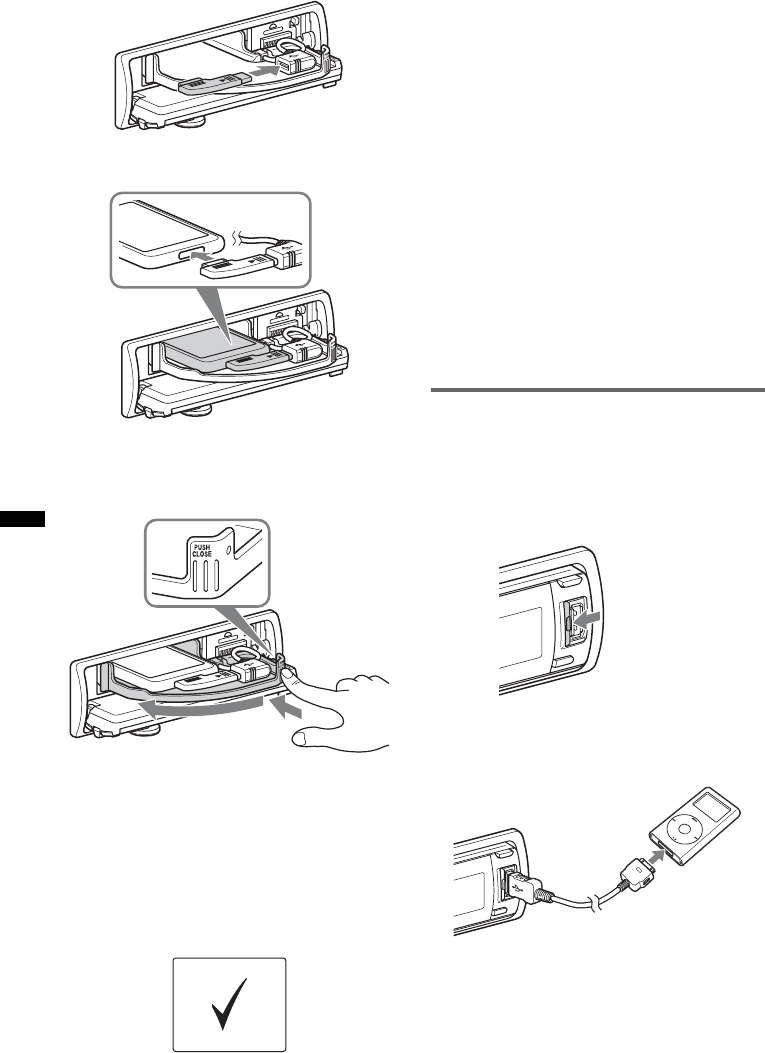
26
3Conecte el adaptador suministrado al
conector USB.
4Conecte el iPod al adaptador
suministrado.
5Deslice hacia adentro la TUNE TRAY
presionando PUSH CLOSE en la TUNE
TRAY hasta que se cierre
completamente.
6Cierre el panel frontal.
7Presione (SOURCE/OFF) varias veces
hasta que aparezca “USB” y, a
continuación, presione (MODE) para
cambiar el dispositivo USB.
Aparece “USB Internal”.
El iPod se encenderá automáticamente y la
indicación siguiente aparecerá en la pantalla
del iPod tal y como se ilustra a continuación.*
Las pistas del iPod empiezan a reproducirse
automáticamente a partir del punto en el que
se detuvo la última reproducción.
Si ya hay un iPod conectado, repita el paso 7.
(“iPod” aparece en la pantalla cuando se
reconoce el iPod.)
*Las indicaciones de la pantalla varían en función del
iPod, o es posible que no aparezcan si se conecta
un iPod touch.
8Ajuste el volumen.
Mantenga presionado (SOURCE/OFF) durante
1 segundo para detener la reproducción.
Extracción del iPod
1Detenga la reproducción del iPod.
2Presione (OPEN).
3Presione PUSH OPEN en la TUNE TRAY.
4Extraiga el iPod.
5Deslice hacia adentro la TUNE TRAY y cierre
el panel frontal.
Reproducción mediante el
conector USB (externo)
Antes de conectar el iPod, baje el volumen de la
unidad.
1Deslice la cubierta del dispositivo
USB.
2Conecte el iPod al conector USB a
través del conector de base conectado
al cable USB.
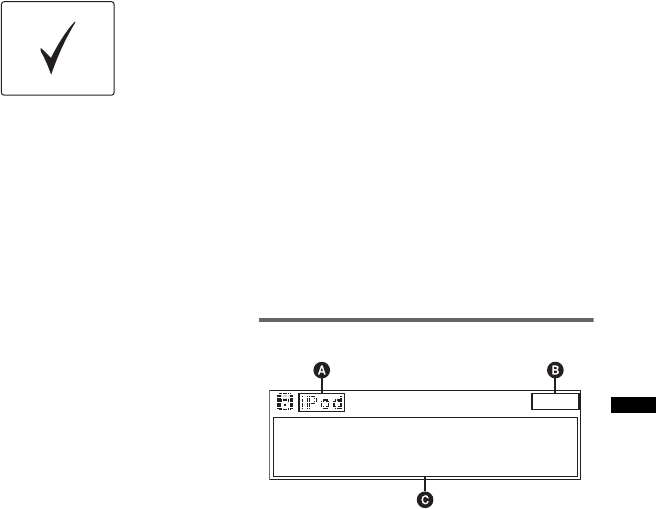
27
3Presione (SOURCE/OFF) varias veces
hasta que aparezca “USB” y, a
continuación, presione (MODE) para
cambiar el dispositivo USB.
Aparece “USB External”.
El iPod se encenderá automáticamente y la
indicación siguiente aparecerá en la pantalla
del iPod tal y como se ilustra a continuación.*
Sugerencia
Para ello, le recomendamos que utilice el cable
RC-100IP USB (no suministrado).
Las pistas del iPod empiezan a reproducirse
automáticamente a partir del punto en el que
se detuvo la última reproducción.
Si ya hay un iPod conectado, repita el paso
3 para empezar la reproducción. (“iPod”
aparece en la pantalla cuando se reconoce el
iPod.)
*En caso de que se conecte un iPod touch o un
iPhone, o si la última vez se realizó la reproducción
en el iPod en el modo de control de pasajero, el
logotipo no aparecerá en la pantalla.
4Ajuste el volumen.
Mantenga presionado (SOURCE/OFF) durante
1 segundo para detener la reproducción.
Extracción del iPod
1Detenga la reproducción del iPod.
2Extraiga el iPod.
Precaución para iPhone
Al conectar un iPhone mediante USB, el volumen del
teléfono se controla a través del iPhone. Para que el
volumen del dispositivo no sea extremadamente alto
tras una llamada, durante las llamadas, no lo aumente
en la unidad.
Notas
•No extraiga el iPod durante la reproducción o, de lo
contrario, los datos podrían dañarse.
•No coloque dispositivos que no sean USB en la
TUNE TRAY, ni objetos extraños, como monedas,
llaves, tarjetas, líquidos, etc.
•No coloque objetos inflamables como un
encendedor en la TUNE TRAY, ya que podría
producir humo, un incendio u otro tipo de accidente.
•Los usuarios de iPod deben usar el adaptador XA-
50IP suministrado. Su uso está designado para esta
unidad solamente (en TUNE TRAY) y no debería
usarse con otro dispositivo USB.
•Esta unidad no puede reconocer el iPod a través de
un concentrador USB.
•Deslice hacia adentro la bandeja TUNE TRAY y
cierre el panel frontal antes de reproducir, ya que
podrían producirse daños en caso de una
obstrucción en el vehículo, etc.
•Si el panel frontal no se abre por completo por la
forma del tablero en la posición de instalación,
desconéctelo y abra la bandeja TUNE TRAY en
forma manual.
Para obtener más información acerca de cómo
extraer el panel frontal, consulte la página 8.
•Es extremadamente peligroso conectar o extraer el
iPod mientras se maneja.
Sugerencias
•Si se coloca la llave de encendido en la posición
ACC (accesorios), o si la unidad está encendida, el
iPod se recarga.
•Si el iPod se desconecta durante la reproducción,
aparecerá “NO Device” en la pantalla de la unidad.
Modo de reanudación
Cuando el iPod se conecta al conector de base, el
modo de esta unidad cambia al modo de
reanudación y se inicia la reproducción en el
modo ajustado por el iPod.
No es posible utilizar los botones de
reproducción repetida/aleatoria en el modo de
reanudación.
Elementos de la pantalla
AIndicación de la fuente (iPod)
BReloj
CNombre del artista/Nombre del álbum,
Nombre de la pista, Nombre del álbum/
Número de pista/Tiempo de reproducción
transcurrido
Para cambiar los elementos de la pantalla C,
presione (DSPL).
Sugerencia
Si se modifica álbum/podcast/género/artista/lista de
reproducción, el número de elemento aparece
durante unos instantes.
Notas
•La reproducción de pistas en el modo aleatorio se
selecciona desde el iPod actual.
•Es posible que algunos caracteres almacenados en
el iPod no se visualicen correctamente.
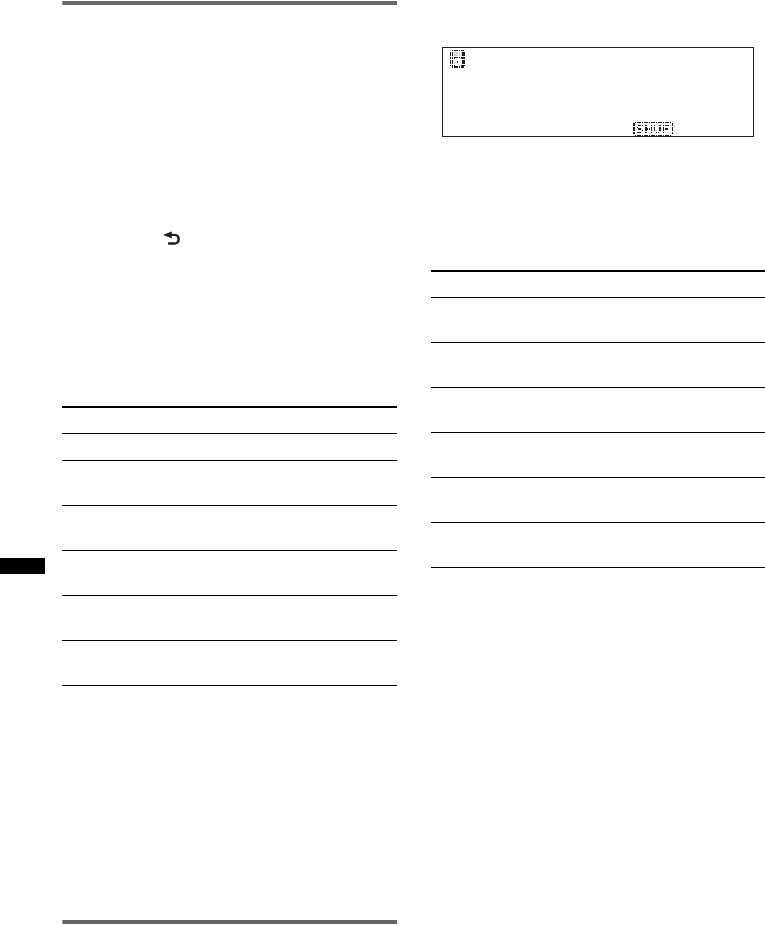
28
Reproducción repetida
1Mantenga presionado el codificador
multidireccional.
2Gire el codificador multidireccional
para seleccionar el ajuste “Repeat” y,
a continuación, presiónelo.
3Gire el codificador multidireccional
para seleccionar el ajuste y, a
continuación, presiónelo.
El ajuste finalizó.
4Presione (BACK).
El ajuste finaliza y la pantalla regresa al modo
de recepción/reproducción normal.
(con el control remoto de tarjeta)
1Durante la reproducción, presione (1)
(REP) varias veces hasta que aparezca
el ajuste deseado.
Después de 3 segundos, se completa el ajuste.
*1 Disponible al seleccionar pistas por “Album” con
Quick-BrowZer (consulte la página 31).
*2 Disponible al seleccionar pistas por “Podcast” con
Quick-BrowZer (consulte la página 31).
*3 Disponible al seleccionar pistas por “Artist” con
Quick-BrowZer (consulte la página 31).
*4 Disponible al seleccionar pistas por “Playlist” con
Quick-BrowZer (consulte la página 31).
*5 Disponible al seleccionar pistas por “Genre” con
Quick-BrowZer (consulte la página 31).
Para regresar al modo de reproducción normal,
seleccione “Repeat off”.
Reproducción aleatoria
1Durante la reproducción, mantenga
presionado (ZAP/SHUF).
2Presione (ZAP/SHUF) varias veces
hasta que aparezca el ajuste deseado.
(con el control remoto de tarjeta)
1Durante la reproducción, presione (2)
(SHUF) varias veces hasta que
aparezca el ajuste deseado.
Después de 3 segundos, se completa el ajuste.
*1 Disponible al seleccionar pistas por “Album” con
Quick-BrowZer (consulte la página 31).
*2 Disponible al seleccionar pistas por “Podcast” con
Quick-BrowZer (consulte la página 31).
*3 Disponible al seleccionar pistas por “Artist” con
Quick-BrowZer (consulte la página 31).
*4 Disponible al seleccionar pistas por “Playlist” con
Quick-BrowZer (consulte la página 31).
*5 Disponible al seleccionar pistas por “Genre” con
Quick-BrowZer (consulte la página 31).
*6 Disponible al seleccionar pistas por “Track” con
Quick-BrowZer (consulte la página 31).
Para regresar al modo de reproducción normal,
seleccione “off”.
Seleccione Para reproducir
Repeat Track pistas en forma repetida.
Repeat Album*1álbumes en forma
repetida.
Repeat Podcast*2podcast en forma
repetida.
Repeat Artist*3artistas en forma
repetida.
Repeat Playlist*4listas de reproducción en
forma repetida.
Repeat Genre*5género en forma
repetida.
Seleccione Para reproducir
Shuffle Album*1álbumes en orden
aleatorio.
Shuffle Podcast*2podcast en orden
aleatorio.
Shuffle Artist*3artistas en orden
aleatorio.
Shuffle Playlist*4listas de reproducción en
orden aleatorio.
Shuffle Genre*5género en orden
aleatorio.
Shuffle Device*6dispositivos en orden
aleatorio.

29
Utilización directa del iPod
— Control de pasajero
Puede utilizar directamente un iPod conectado al
conector de base. Esta opción funciona
solamente cuando se conecta un iPod al conector
USB (externo).
1Durante la reproducción, mantenga
presionado (MODE).
Aparece “Mode iPod” y podrá utilizar el iPod
directamente.
Para salir del modo de control de
pasajero
Mantenga presionado (MODE).
A continuación, aparecerá “Mode Audio” y el
modo de reproducción cambiará a “Resuming”.
Notas
•Sólo es posible ajustar el volumen en la unidad.
•Si se cancela este modo, el ajuste de repetición se
desactivará.
Pandora® a través de USB
(iPhone)
Pandora Radio es un servicio de radio
personalizado GRATIS, que ahora está
disponible para transmitir música a través de su
iPhone.
Sólo debe comenzar con el nombre de uno de sus
artistas, canciones o compositores clásicos
favoritos y Pandora creará una “estación” que
reproduce esa música y otra música similar.
Puede controlar a Pandora en un iPhone con
conexión USB desde esta unidad.
Descargue la última versión de Pandora y
obtenga más información en www.pandora.com
Para obtener más información acerca de los
dispositivos que se pueden utilizar, visite el sitio
web de soporte técnico.
Notas
•No coloque un teléfono celular o un dispositivo con
funciones de comunicación inalámbrica en la TUNE
TRAY, ya que es posible que no reciba señales
telefónicas o que la comunicación se corte.
•Algunas funciones del servicio de Pandora podrían
no estar disponibles.
•En este momento, el servicio de Pandora sólo está
disponible en los EE.UU.
Reproducción en Pandora
Reproducción mediante el
conector USB (externo)
Antes de conectar el iPhone, baje el volumen de
la unidad.
1Deslice la cubierta del dispositivo
USB.
continúa en la página siguiente t
Sitio Web de soporte técnico en línea
http://esupport.sony.com
http://www.sony.com/mobileAV
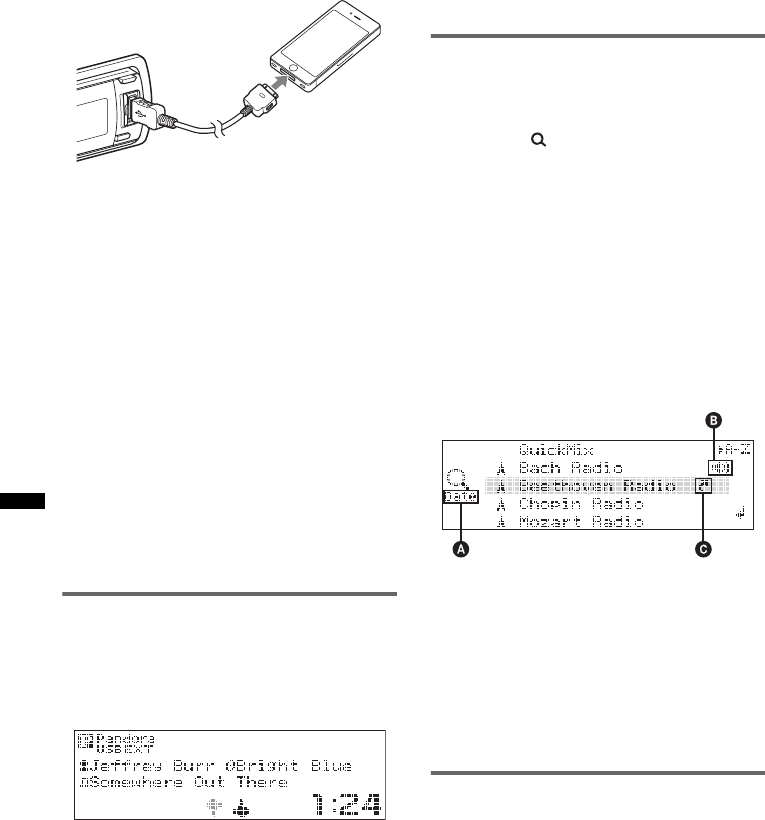
30
2Conecte el iPhone al conector USB a
través del conector de base conectado
al cable USB.
3Presione (SOURCE/OFF) varias veces
hasta que aparezca “Pandora USB” y
luego presione (MODE) para cambiar
el dispositivo USB.
Aparecerá “Pandora USB EXT” y “Please
launch Pandora Application on mobile
device.”.
4Inicie Pandora en el iPhone.
5Ajuste el volumen desde esta unidad.
Para pausar la reproducción
Presione (PAUSE). Para cancelar esta función,
vuelva a presionarlo.
Para omitir una canción
Presione el codificador multidireccional hacia la
derecha.
Notas
•No se puede retroceder a la canción anterior.
•Pandora limita la cantidad de saltos permitidos.
Clasificación por “Thumbs
(Pulgares)”
La clasificación por medio de “Thumbs Up
(Pulgares arriba)” o “Thumbs Down (Pulgares
abajo)” le permite personalizar las estaciones
según su gusto personal.
Thumbs Up (Pulgares arriba)
Durante el modo de reproducción, mantenga
presionado el codificador multidireccional hacia
arriba durante 1 segundo.
Thumbs Down (Pulgares abajo)
Durante el modo de reproducción, mantenga
presionado el codificador multidireccional hacia
abajo durante 1 segundo.
Nota
Bajo ciertas circunstancias, la clasificación por
“Thumbs (Pulgares)” podría no estar disponible. En
ese caso, aparecerá en pantalla “Cannot Thumbs Up/
Down”.
Lista de estaciones
La lista de estaciones le permite seleccionar
fácilmente la estación que desea.
1Durante el modo de reproducción,
presione (BROWSE).
Aparecen las estaciones Pandora que están en
su lista.
2Presione el codificador
multidireccional hacia la derecha para
seleccionar el orden: “Date” o “A-Z”.
“Date” ordena las estaciones según la fecha
en que se agregaron a la cuenta y “A-Z”
ordena los nombres de las estaciones en orden
alfabético.
3Gire el codificador multidireccional
para seleccionar la estación deseada y
luego presiónelo.
Se inicia la reproducción.
AOrden actual
BEstación actual
CÍcono compartido
QuickMix
QuickMix le permite escuchar de manera
aleatoria canciones que se reproducen en una o
más estaciones Pandora de su lista.
Edite sus selecciones de estación de QuickMix
en el dispositivo antes de iniciar la conexión.
Agregar marcadores
Se puede agregar un marcador a la canción o al
artista que se reproduce actualmente y se puede
guardar en su cuenta Pandora.
1Durante el modo de reproducción,
mantenga presionado (MODE) hasta
que aparezca “Bookmark”.
2Gire el codificador multidireccional
para seleccionar “Song” o “Artist” y
luego presiónelo.
El marcador se guardará y el sistema
regresará a la pantalla anterior.
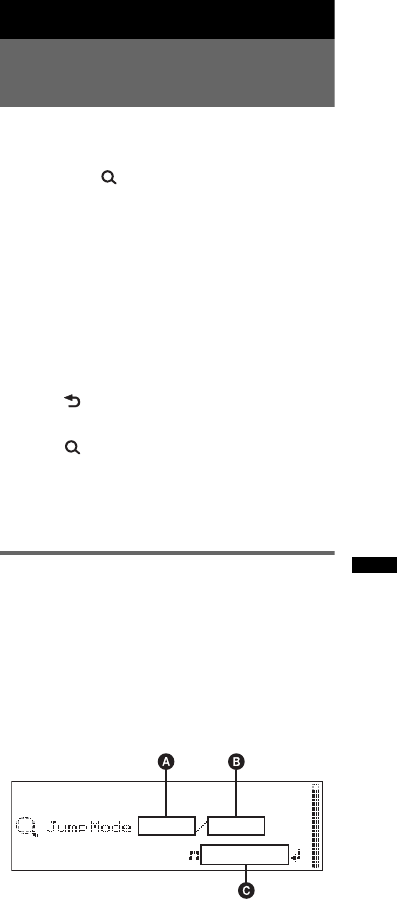
31
Nota
Bajo ciertas circunstancias, el marcador podría no
guardarse. En ese caso, aparecerá en pantalla
“Bookmark Error”. Si esto sucede, intente agregar el
marcador más tarde.
Búsqueda de una pista
Búsqueda de una pista por
nombre — Quick-BrowZer™
Puede buscar una pista fácilmente en un
dispositivo USB por categorías.
1Presione (BROWSE).
La unidad accede al modo Quick-BrowZer y
aparece la lista de categorías de búsqueda.
2Gire el codificador multidireccional
para seleccionar la categoría de
búsqueda deseada y, a continuación,
presiónelo para confirmarla.
3Repita el paso 2 hasta que se
seleccione la pista deseada.
Se inicia la reproducción.
Para volver a la pantalla anterior
Presione (BACK).
Para salir del modo Quick-BrowZer
Presione (BROWSE).
Nota
Al acceder al modo Quick-BrowZer, se cancela el
ajuste de reproducción repetida/aleatoria.
Búsqueda por omisión de
elementos — Modo de Omisión
Cuando varios elementos se encuentran dentro de
una misma categoría, es posible encontrar el
elemento deseado rápidamente.
1Presione el codificador
multidireccional hacia la derecha en el
modo Quick-BrowZer.
Aparecerá la siguiente pantalla.
ANúmero del elemento actual
BNúmero total de elementos en la capa actual
CNombre de elemento
A continuación, aparecerá el nombre del
elemento.
continúa en la página siguiente t

32
2Gire el codificador multidireccional
hasta que aparezca el elemento
deseado o uno próximo a él.
Salta en incrementos del 10% del número
total de elementos.
3Presione el codificador
multidireccional.
Vuelve a la pantalla del modo Quick-BrowZer
y aparece el elemento seleccionado.
4Presione el codificador
multidireccional hacia arriba y hacia
abajo para seleccionar el elemento
deseado y, a continuación, presiónelo.
Si el elemento seleccionado es una pista,
empieza la reproducción.
Para cancelar el modo de Omisión
Presione (BACK) o presione el codificador
multidireccional hacia la izquierda. Aparece una
lista de categorías de búsqueda.
Búsqueda por orden alfabético
— Búsqueda alfabética
Cuando se conecta a la unidad un iPod o un
dispositivo USB que contiene información de
canciones, puede encontrar el elemento deseado
en orden alfabético. Mientras que la unidad está
leyendo la información de la canción, “ ”
aparece en la pantalla. Puede utilizar la función
de búsqueda alfabética cuando “ ”
desaparezca. Para un dispositivo USB, la
cantidad máxima de archivos (pistas) que se
pueden buscar es 5 000.
1Presione el codificador
multidireccional hacia la derecha en el
modo Quick-BrowZer.
Aparece una lista en orden alfabético.
2Gire el codificador multidireccional
para seleccionar la primera letra del
elemento deseado y presiónelo.
Aparece una lista de los elementos de la
categoría seleccionada en orden alfabético.
Si no existe una canción que comience con la
letra indicada, aparece “Not Found”.
3Presione el codificador
multidireccional hacia arriba y hacia
abajo para seleccionar el elemento
deseado y, a continuación, presiónelo.
Si el elemento seleccionado es una pista,
empieza la reproducción.
Para cancelar la búsqueda alfabética
Presione (BACK) o presione el codificador
multidireccional hacia la izquierda. Aparece una
lista de categorías de búsqueda.
Notas
•Para un dispositivo USB, es posible que demore un
poco en leer la información de la canción después
de conectar la unidad.
Mientras que la unidad está leyendo la información
de la canción, “ ” aparece en la parte superior
izquierda de la pantalla.
•Solamente se puede almacenar la información de la
canción del dispositivo USB que se conectó por
última vez.
•Si reemplaza la batería del automóvil, cambia las
conexiones o restablece la unidad, la información de
la canción almacenada se borrará.

33
Búsqueda de una pista por
segmentos — ZAPPIN™
Es posible buscar una pista que desee escuchar
mientras se reproducen pequeños fragmentos de
pistas en un dispositivo USB de forma
secuencial.
El modo ZAPPIN es adecuado para buscar pistas
en el modo de reproducción aleatoria o de
repetición aleatoria.
1Durante la reproducción, presione
(ZAP/SHUF).
Cuando “ZAPPIN” aparece en la pantalla, la
reproducción se inicia en un segmento de la
pista siguiente.
El segmento se reproduce durante el tiempo
establecido y, a continuación, suena un clic y
se inicia el segmento siguiente.
2Cuando se reproduzca la pista que
desea escuchar, presione el
codificador multidireccional o
(ZAP/SHUF).
La pista seleccionada vuelve al modo de
reproducción normal desde el principio.
Para buscar una pista de nuevo en el modo
ZAPPIN, repita los pasos 1 y 2.
En el caso de reproducción de
“SensMe™ channels”
Si “Content Transfer” transfiere la pista que se
desea buscar, se mostrarán las secciones* más
rítmicas o melódicas de las pistas. Para obtener
más información acerca de la función SensMe™,
consulte la página 23.
*Es posible que no se detecten correctamente.
Sugerencias
•Es posible seleccionar el tiempo de reproducción
entre unos 6 segundos, 15 segundos o 30 segundos
(página 47). No es posible seleccionar el fragmento
de la pista que se reproducirá.
•Para saltar pistas, presione el codificador
multidireccional hacia la derecha/izquierda en modo
ZAPPIN.
•Para saltar álbumes, presione el codificador
multidireccional hacia la derecha/izquierda en modo
ZAPPIN.
Bluetooth (Llamadas con
manos libres y transmisión de
música)
Operaciones de Bluetooth
Para utilizar la función Bluetooth, es necesario
realizar el procedimiento siguiente.
1Emparejamiento
Cuando se conectan dispositivos Bluetooth
por primera vez, se requiere un registro
mutuo. Este proceso se denomina
“emparejamiento”. Solamente es necesario
realizar el registro (emparejamiento) la
primera vez, ya que esta unidad y los otros
dispositivos se reconocerán entre sí
automáticamente la próxima vez. Puede
emparejar hasta 9 dispositivos.
2Conexión
Una vez realizado el emparejamiento, conecte
esta unidad y el dispositivo Bluetooth. Según
el dispositivo, la conexión se puede realizar
en forma automática junto con el
emparejamiento.
3Llamadas con manos libres y
transmisión de música
Puede realizar o contestar llamadas con un
dispositivo manos libres, o escuchar audio a
través de la unidad.
Para obtener más información acerca de los
dispositivos que se pueden utilizar, visite el sitio
web de soporte técnico.
Partes de cada pista que se
reproducen en el modo
ZAPPIN.
Pista
(ZAP/SHUF)
presionado.
Sitio Web de soporte técnico en línea
http://esupport.sony.com
http://www.sony.com/mobileAV

34
Acerca de los iconos Bluetooth
En esta unidad, se utilizan los iconos siguientes.
*Se vuelve gris si no existe conexión con manos
libres. Varía en el caso de un teléfono celular.
Instalación del micrófono
Para captar su voz durante una llamada de manos
libres, necesita instalar el micrófono
(suministrado).
Para obtener más información sobre cómo
conectar el micrófono, consulte el manual de
“Instalación/Conexiones” suministrado.
Emparejamiento
Primero, registre (“empareje”) el dispositivo
Bluetooth (teléfono celular, etc.) con esta unidad.
Es posible emparejar hasta 9 dispositivos.
Después de establecer el emparejamiento, no
será necesario volver a realizarlo.
1Mantenga presionado (BLUETOOTH).
“ ” parpadea (el emparejamiento está en
modo de espera).
2Configure el dispositivo Bluetooth
para buscar esta unidad.
Aparece una lista de los dispositivos
detectados en la pantalla del dispositivo que
desea conectar. La unidad se muestra como
“Sony Automotive” en el dispositivo que se
va a conectar.
3Si se requiere una clave de paso* en la
pantalla del dispositivo que se desea
conectar, introduzca “0000”.
Esta unidad y el dispositivo Bluetooth
memorizan la información entre sí y, después
de realizar el emparejamiento, la unidad
estará preparada para conectarse al
dispositivo.
4Configure el dispositivo Bluetooth
para conectarlo a esta unidad.
Aparece el mensaje “Connection Complete”,
y se completa la conexión.
“ ” o “ ” aparece cuando la conexión está
establecida.
*La clave de paso puede denominarse “clave de
acceso”, “código PIN”, “número PIN” o “contraseña”
etc. en función del dispositivo. Si el dispositivo
admite la versión 2.1 de Bluetooth, no se requiere la
introducción de una clave de paso.
Notas
•Mientras se conecta a un dispositivo Bluetooth, esta
unidad no puede detectarse desde otro dispositivo.
Para habilitar la detección, acceda al modo de
emparejamiento y busque esta unidad desde otro
dispositivo.
Encendido:
Parpadea:
Ninguno:
La señal de Bluetooth está
activada.
El emparejamiento está
en modo de espera.
La señal de Bluetooth está
desactivada.
Encendido:
Parpadea:
Ninguno:
Conectado a un teléfono
celular.
Conexión en progreso.
No hay ningún teléfono
celular conectado para
realizar llamadas con
manos libres.
Encendido:
Parpadea:
Ninguno:
Conectado al dispositivo.
Conexión en progreso.
No hay ningún dispositivo
conectado para la
transmisión de música.
Encendido:
Parpadea:
Ninguno:
Hay mensajes SMS sin
leer.
Se ha recibido un mensaje
SMS.
No hay mensajes SMS sin
leer.
Estado de la potencia de
señal del teléfono celular
al que se conecta.*
Estado de la batería
restante del teléfono
celular al que se conecta.*
XXXXXXX
DR-BT30Q
Sony
Automotive
XXXX
Introduzca la
clave de paso.
“0000”

35
•Es posible que la búsqueda o la conexión demore
un poco.
•Según el dispositivo, la pantalla de confirmación de
la conexión aparece antes de introducir la clave de
paso.
•El plazo para introducir la clave de paso varía según
el dispositivo.
•Esta unidad no puede conectarse a un dispositivo
compatible solamente con HSP (Head Set Profile).
Conexión
Si ha conseguido realizar el emparejamiento,
inicie la operación a partir de este punto.
Conexión a un teléfono celular
1Asegúrese de que tanto esta unidad
como el teléfono celular tengan la
señal Bluetooth activada.
2Realice la conexión a esta unidad
mediante el teléfono celular.
“ ” aparece cuando la conexión está
establecida. Si seleccionó una fuente de
teléfono Bluetooth una vez que se estableció
la conexión, los nombres de la red y del
teléfono celular conectado también aparecen
en la pantalla.
Conexión del último teléfono celular
conectado desde esta unidad
1Asegúrese de que tanto esta unidad como el
teléfono celular tengan la señal Bluetooth
activada.
2Presione (SOURCE/OFF) varias veces hasta
que aparezca “Bluetooth Phone”.
3Presione el codificador multidireccional.
“ ” parpadea mientras se establece la
conexión. “ ” aparece cuando la conexión
está establecida.
Notas
•Algunos teléfonos celulares requieren autorización
para acceder a los datos de su agenda telefónica
durante la conexión del manos libres con esta
unidad. La autorización se obtiene mediante el
teléfono celular.
•Mientras trasmite audio Bluetooth, no puede realizar
la conexión de esta unidad al teléfono celular. En
cambio, realice la conexión del teléfono celular a
esta unidad. Es posible que se escuche un ruido de
conexión durante el sonido de reproducción.
Sugerencias
•Con la señal Bluetooth activada: si el encendido se
ajusta en la posición ON, la unidad vuelve a
conectarse automáticamente al último teléfono
celular conectado. No obstante, la conexión
automática también depende de la especificación
del teléfono celular. Si la unidad no vuelve a
conectarse automáticamente, conéctela en forma
manual.
•Además, puede seleccionar una fuente de teléfono
Bluetooth. Para ello, mantenga presionado
(BROWSE) durante más de 2 segundos en la
unidad, o presione (CALL) en el control remoto de
tarjeta.
Conexión de un dispositivo de
audio
1Asegúrese de que tanto esta unidad
como el dispositivo de audio tengan la
señal Bluetooth activada.
2Realice la conexión a esta unidad
mediante el dispositivo de audio.
“ ” aparece cuando la conexión está
establecida.
Conexión del último dispositivo de
audio conectado desde esta unidad
1Asegúrese de que tanto esta unidad como el
dispositivo de audio tengan la señal Bluetooth
activada.
2Presione (SOURCE/OFF) varias veces hasta
que aparezca “Bluetooth Audio”.
3Presione (PAUSE).
“ ” parpadea mientras se establece la
conexión. “ ” aparece cuando la conexión
está establecida.

36
Realización de llamadas con
manos libres
Una vez que la unidad está conectada al teléfono
celular, puede realizar o contestar llamadas con
esta unidad.
Realización de llamadas
Realización de llamadas desde la
agenda telefónica
Debe asegurarse de haber seleccionado la agenda
telefónica correspondiente. Para obtener más
información acerca de cómo seleccionar la
agenda telefónica, consulte “Selección de una
agenda telefónica” (página 37).
1Presione (SOURCE/OFF) varias veces hasta
que aparezca “Bluetooth Phone”.
2Presione (BROWSE).
Aparece la agenda telefónica.
3Gire el codificador multidireccional para
seleccionar una inicial de la lista de iniciales y,
a continuación, presiónelo.
4Gire el codificador multidireccional para
seleccionar un nombre de la lista de nombres
y, a continuación, presiónelo.
5Gire el codificador multidireccional para
seleccionar un número de la lista de números
y, a continuación, presiónelo.
Comienza la llamada telefónica.
Realización de llamadas desde el
historial de llamadas
1Presione (SOURCE/OFF) varias veces hasta
que aparezca “Bluetooth Phone”.
2Mantenga presionado (BROWSE) durante
más de 2 segundos.
Aparece una lista del historial de llamadas.
3Gire el codificador multidireccional para
seleccionar un nombre y un número telefónico
del historial de llamadas y, a continuación,
presiónelo.
Comienza la llamada telefónica.
Nota
Es posible llamar desde el historial de llamadas (hasta
20).
Realización de llamadas mediante la
introducción directa de un número
de teléfono
Es posible realizar llamadas mediante la
introducción directa de un número de teléfono
solamente con el control remoto de tarjeta.
1Presione (CALL) en el control remoto de
tarjeta para seleccionar la fuente de teléfono
Bluetooth.
2Presione los botones numéricos (0 a 9, o )
en el control remoto de tarjeta para introducir
el número de teléfono.
3Presione (ENTER) en el control remoto de
tarjeta.
Comienza la llamada telefónica.
Para introducir “+”, mantenga presionado el
botón 0 en el control remoto de tarjeta.
Realización de llamadas mediante
números preajustados
Es posible almacenar hasta 6 contactos en la
marcación preajustada. Para obtener más
información acerca de cómo almacenarlos,
consulte “Marcación preajustada” (página 38).
1Presione (SOURCE/OFF) varias veces hasta
que aparezca “Bluetooth Phone”.
2Presione el codificador multidireccional hacia
arriba y hacia abajo para seleccionar el
contacto al que desea llamar y, a continuación,
presiónelo.
Comienza la llamada telefónica.
Para finalizar una llamada
Presione nuevamente el codificador
multidireccional o (SOURCE/OFF).
Nota
Incluso si se ha finalizado la llamada, la conexión
Bluetooth no se cancela.
Realización de llamadas mediante
repetición de marcado
1Presione (SOURCE/OFF) varias veces hasta
que aparezca “Bluetooth Phone”.
2Mantenga presionado el codificador
multidireccional durante más de 2 segundos.
Comienza la llamada telefónica.
Recepción de llamadas
Cuando se recibe una llamada, se emite un tono
de llamada a través de los altavoces del
automóvil. El nombre y el número de teléfono
aparecen en la pantalla.
1Presione el codificador
multidireccional cuando reciba una
llamada con un tono de llamada.
Comienza la llamada telefónica.
Nota
En función del teléfono celular, es posible que
aparezca solamente el número de teléfono.

37
Ajuste de Auto Answer (respuesta
automática)
Puede seleccionar un ajuste de respuesta
automática de “off”, “Short” o “Long”
(página 47).
Ajuste de Ringtone (tono de llamada)
Puede seleccionar un tono de llamada de
“Default” o “Cellular” (página 47).
*En función del teléfono celular, es posible que el
tono de llamada de esta unidad se emita incluso si
se configura en “Cellular”.
Para rechazar una llamada
Presione (SOURCE/OFF).
Operaciones durante una llamada
Configuración del volumen del tono
de llamada y del auricular
Puede configurar el volumen del tono de llamada
y del auricular.
Para ajustar el volumen del tono de llamada:
Gire el codificador multidireccional mientras
recibe la llamada. Aparece “Ring Volume”, y se
puede ajustar el volumen del tono de llamada.
Para ajustar el volumen del auricular:
Gire el codificador multidireccional durante una
llamada. Aparece “Talk Volume”, y se puede
ajustar el volumen del auricular.
Nota
Si seleccionó la fuente de teléfono Bluetooth, al girar
el codificador multidireccional solamente se ajustará
el volumen del auricular.
EC/NC Mode (modo de cancelación
de eco/ruido)
Puede reducir el eco y el ruido.
Presione el codificador multidireccional hacia la
izquierda o hacia la derecha para configurar
“EC/NC Mode 1” o “EC/NC Mode 2”.
Nota
Se puede configurar durante una llamada.
Envío de tonos DTMF (Dual Tone
Multiple Frequency)
Puede enviar tonos DTMF.
Presione los botones numéricos (0 a 9, o )
en el control remoto de tarjeta para enviar los
tonos DTMF.
Ajuste de MIC Gain (la ganancia del
micrófono)
Puede ajustar el volumen de la otra parte.
Presione el codificador multidireccional hacia
arriba y hacia abajo para ajustar los niveles de
volumen en (“MIC Gain LOW”, “MIC Gain
MID” o “MIC Gain HI”).
Nota
Se puede configurar durante una llamada.
Transferencia de llamadas
Para activar o desactivar el dispositivo correcto
(esta unidad o el teléfono celular), realice lo
siguiente.
1Presione (MODE) o utilice el teléfono
celular.
Para obtener más información acerca del
funcionamiento del teléfono celular, consulte el
manual de dicho dispositivo.
Nota
En función del teléfono celular, es posible que la
conexión de manos libres se interrumpa al intentar
transferir una llamada.
Manejo de la agenda telefónica
Notas sobre los datos de la agenda telefónica
•Antes de disponer del automóvil en el que está
instalada la unidad o cambiar su titularidad,
asegúrese de presionar el botón RESET para
eliminar todos los datos de la agenda telefónica a fin
de evitar posibles accesos no autorizados. Al
desconectar el cable de fuente de alimentación,
también se eliminarán todos los datos de la agenda
telefónica.
•Los datos descargados de la agenda telefónica de
un teléfono celular no pueden sobrescribirse por
datos posteriores. No obstante, es posible que
algunos datos (nombre, etc.) se dupliquen al
intentarlo.
•Si presiona el botón RESET, los datos almacenados
de agenda telefónica se eliminarán.
•Es posible que se pierdan los datos de la agenda
telefónica si se daña esta unidad.
•Al desechar esta unidad, se deben eliminar los
datos de la agenda telefónica mediante la función
“BT Initialize” (página 40).
•Es posible almacenar hasta 500 contactos en la
agenda telefónica. Si intenta registrar más de 500
números, aparecerá el mensaje “Memory Full”.
Selección de una agenda telefónica
Antes de realizar una llamada, asegúrese de
haber seleccionado la agenda telefónica
correspondiente: teléfono celular o esta unidad.
Si selecciona “Cellular”, puede acceder a la
agenda telefónica del celular mediante esta
unidad*.
*Si el teléfono celular no admite PBAP, no se puede
seleccionar la agenda telefónica del teléfono celular.
continúa en la página siguiente t
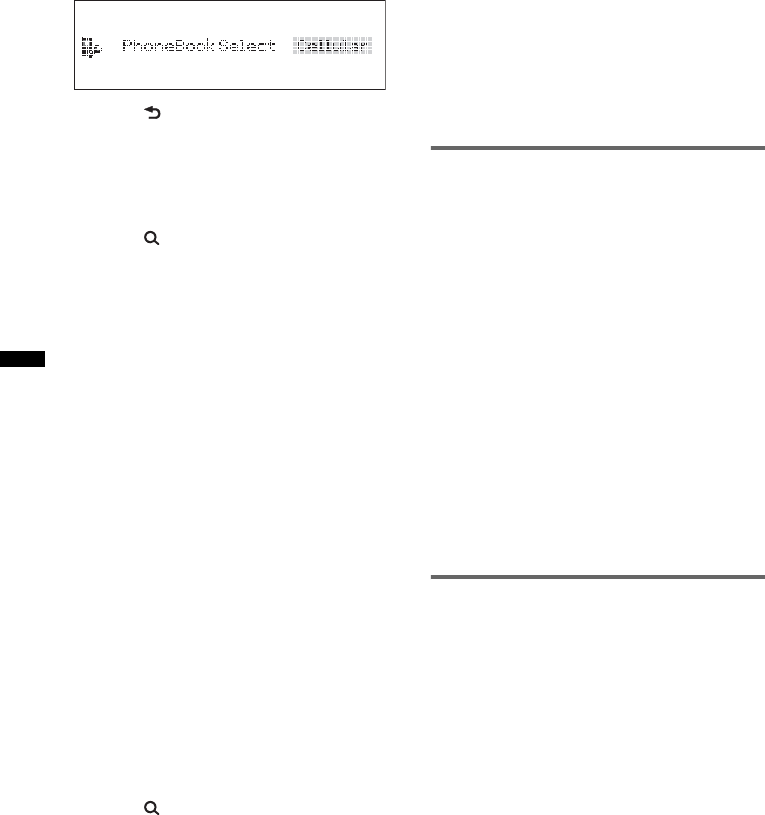
38
1Mantenga presionado (SOURCE/OFF)
durante 1 segundo.
2Mantenga presionado el codificador
multidireccional.
3Gire el codificador multidireccional hasta que
aparezca “PhoneBook Select” y, a
continuación, presiónelo.
4Gire el codificador multidireccional para
seleccionar “Cellular” o “Head Unit” y, a
continuación, presiónelo.
5Presione (BACK).
Recepción de datos de la agenda
telefónica de un teléfono celular
1Presione (SOURCE/OFF) varias veces hasta
que aparezca “Bluetooth Phone”.
2Presione (BROWSE).
Aparece la agenda telefónica.
3Gire el codificador multidireccional para
seleccionar “Add Contact” y, a continuación,
presiónelo.
Aparece el mensaje “Waiting…”.
4Utilice el teléfono celular para enviar los datos
de la agenda telefónica.
Aparece el mensaje “Data Receiving…”
mientras recibe los datos de la agenda
telefónica.
El mensaje “Complete” aparecerá cuando se
hayan almacenado los datos en la unidad.
Notas
•En función del teléfono celular, es posible que se le
solicite permiso para acceder a la agenda telefónica
del teléfono celular cuando conecte la unidad. El
teléfono celular requiere el permiso.
•Antes de recibir datos de la agenda telefónica,
desconecte todos los teléfonos celulares o
dispositivos de audio.
•Para cancelar la transferencia de datos de la
agenda telefónica, utilice el teléfono celular.
•Si desconecta el cable de fuente de alimentación, se
eliminarán los datos almacenados de la agenda
telefónica.
Eliminación desde la agenda
telefónica en esta unidad
1Presione (SOURCE/OFF) varias veces hasta
que aparezca “Bluetooth Phone”.
2Presione (BROWSE).
Aparece la agenda telefónica.
3Gire el codificador multidireccional para
seleccionar una inicial de la lista de iniciales y,
a continuación, presiónelo.
4Gire el codificador multidireccional para
seleccionar un nombre de la lista de nombres
y, a continuación, presiónelo.
5Gire el codificador multidireccional para
seleccionar “Delete Contact” de la lista de
números y, a continuación, presiónelo.
6Gire el codificador multidireccional para
seleccionar “Yes” y, a continuación,
presiónelo.
Para eliminar todos los datos de la agenda
telefónica, seleccione “Delete All” en el paso 3.
Tras la eliminación, compruebe que se hayan
eliminado correctamente todos los datos de la
agenda telefónica.
Marcación preajustada
Es posible almacenar hasta 6 contactos de la
agenda telefónica en un teléfono celular en la
marcación preajustada.
1Presione (SOURCE/OFF) varias veces
hasta que aparezca “Bluetooth
Phone”.
2Presione el codificador
multidireccional hacia arriba y hacia
abajo para seleccionar el número
preajustado (“Preset 1” a “Preset 6”)
en el que desea almacenarlo.
3Presione el codificador
multidireccional hacia la derecha para
acceder al modo de almacenamiento.
Aparece el mensaje “Waiting…”.
4Utilice el teléfono celular para enviar
los datos de la agenda telefónica.
El contacto se almacena en el número
preajustado que seleccione.
Activación de la marcación por voz
Para activar la marcación por voz con un teléfono
celular conectado a esta unidad, mencione la
etiqueta de voz almacenada en el teléfono celular
y, a continuación, realice la llamada.
1Presione (SOURCE/OFF) varias veces
hasta que aparezca “Bluetooth
Phone”.
2Presione el codificador
multidireccional.
Aparece el mensaje “Please say the name…”.
3Mencione la etiqueta de voz
almacenada en el teléfono celular.
Se reconocerá su voz y se realizará la
llamada.
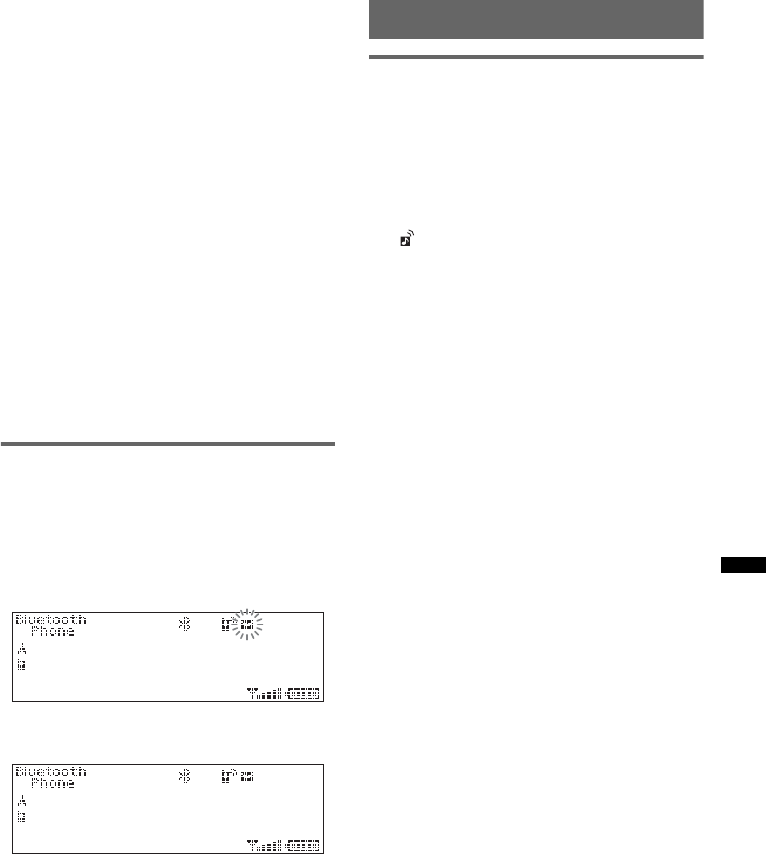
39
Notas
•Antes de comenzar, compruebe que la unidad y el
teléfono celular estén conectados.
•Almacene una etiqueta de voz en el teléfono celular
de antemano.
•Si activa la marcación por voz con un teléfono
celular conectado a la unidad, es posible que esta
función no esté disponible en algunos casos.
•Los ruidos, como el del motor en marcha, pueden
interferir en el reconocimiento del sonido. Para
mejorar el reconocimiento, utilice la unidad en
condiciones en que el ruido sea mínimo.
•Es posible que la marcación por voz no funcione en
algunas situaciones según la eficacia de la función
de reconocimiento de voz del teléfono celular. Para
obtener más información, consulte el sitio web de
soporte técnico.
•No utilice la marcación por voz en el teléfono celular
durante la conexión del dispositivo de manos libres.
Sugerencias
•Hable del mismo modo que cuando almacenó la
etiqueta de voz.
•Almacene una etiqueta de voz mientras se
encuentra sentado en el automóvil, a través de esta
unidad y con la fuente “Bluetooth Phone”
seleccionada.
Indicador de SMS
Cuando conecta un teléfono celular a esta
unidad, el indicador de SMS le informa si existen
mensajes SMS en la bandeja de entrada o sin
leer.
Si recibe un nuevo mensaje SMS, el indicador de
SMS parpadea.
Si existen mensajes SMS sin leer, el indicador de
SMS permanece encendido.
Nota
Es posible que el funcionamiento del indicador de
SMS dependa del teléfono celular.
Transmisión de música
Reproducción de música desde un
dispositivo de audio
Esta unidad permite escuchar música de un
dispositivo de audio si el dispositivo de audio es
compatible con A2DP (Advanced Audio
Distribution Profile) de la tecnología Bluetooth.
1Conecte esta unidad y el dispositivo
de audio Bluetooth (página 35).
“ ” aparecerá durante la conexión.
2Baje el volumen de esta unidad.
3Presione (SOURCE/OFF) varias veces
hasta que aparezca “Bluetooth
Audio”.
4Para comenzar la reproducción, utilice
las funciones del dispositivo de audio.
5Ajuste el volumen de esta unidad.
Ajuste del nivel de volumen
Puede ajustar cualquier diferencia en el nivel de
volumen entre la unidad y el dispositivo de audio
Bluetooth.
1Inicie la reproducción en el dispositivo de
audio Bluetooth con un volumen moderado.
2Seleccione el volumen habitual en la unidad.
3Presione el codificador multidireccional.
4Gire el codificador multidireccional hasta que
aparezca “Bluetooth Audio Level” y, a
continuación, presiónelo.
5Gire el codificador multidireccional para
ajustar el nivel de entrada (“+ 18dB” – “0dB”
– “– 8dB”).
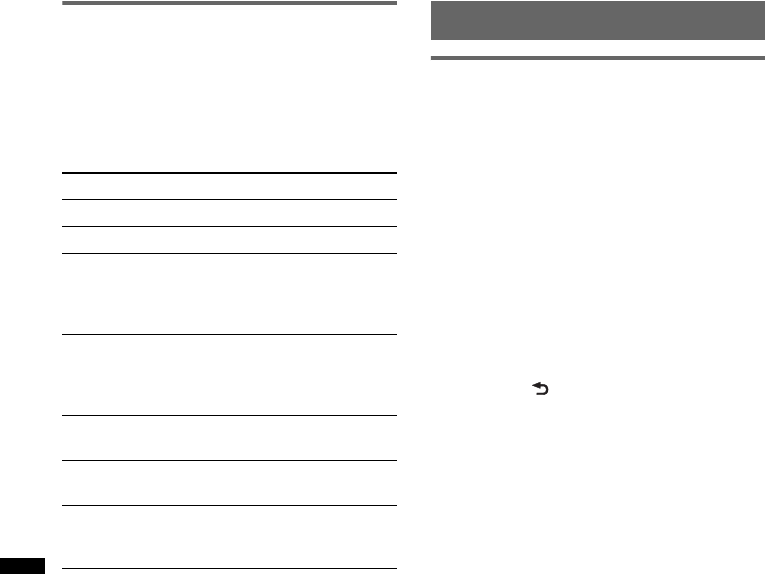
40
Operación de un dispositivo de
audio con esta unidad
Puede realizar las siguientes operaciones en esta
unidad si el dispositivo de audio es compatible
con AVRCP (Audio Video Remote Control
Profile) de la tecnología Bluetooth. (La
operación puede variar en función del tipo de
dispositivo de audio).
*1 Según el tipo de dispositivo, es posible que sea
necesario presionar dos veces.
*2 Presione varias veces hasta que aparezca el
ajuste deseado.
*3 Además, es posible reproducir en modo aleatorio.
Para ello, mantenga presionado (ZAP/SHUF) en
esta unidad.
Cualquier otra operación se debe realizar
directamente en el dispositivo de audio.
Notas
•En función del dispositivo de audio, es posible que
no se muestre en esta unidad cierta información,
por ejemplo, el título, el número de pista y la
duración, el estado de la reproducción, etc. La
información se muestra solamente durante la
reproducción de audio Bluetooth.
•Incluso si se cambia la fuente en la unidad, la
reproducción de la señal del dispositivo de audio no
se interrumpe.
Sugerencia
Puede conectar un teléfono celular que sea
compatible con A2DP (Advanced Audio Distribution
Profile), como un dispositivo de audio, y escuchar
música.
Otros ajustes
Inicialización de los ajustes de
Bluetooth
Es posible inicializar todos los ajustes relativos a
Bluetooth desde esta unidad.
1Mantenga presionado el codificador
multidireccional.
Aparecerá la lista de menús.
2Gire el codificador multidireccional
para seleccionar “BT Initialize” y, a
continuación, presiónelo.
Aparece la pantalla de confirmación.
3Gire el codificador multidireccional
para seleccionar “Yes”.
Aparece el mensaje “Initializing...” durante la
inicialización de los ajustes de Bluetooth.
4Presione (BACK).
La pantalla vuelve al modo de recepción/
reproducción normal.
Nota
Al desechar esta unidad, se deben eliminar los datos
de la agenda telefónica mediante la función “BT
Initialize”.
Para Realice esta acción
Reproducir Presione (PAUSE).*1
Pausar Presione (PAUSE).*1
Omitir pistas Presione el codificador
multidireccional hacia la
izquierda o hacia la derecha
[una vez para cada pista].
Retroceder/
Avanzar Mantenga presionado el
codificador multidireccional
hacia la izquierda o hacia la
derecha.
Reproducir en
forma repetida Presione (REP) en el control
remoto de tarjeta.*2
Reproducción
aleatoria Presione (SHUF) en el control
remoto de tarjeta.*2*3
Omitir álbumes Presione el codificador
multidireccional hacia arriba o
hacia abajo.
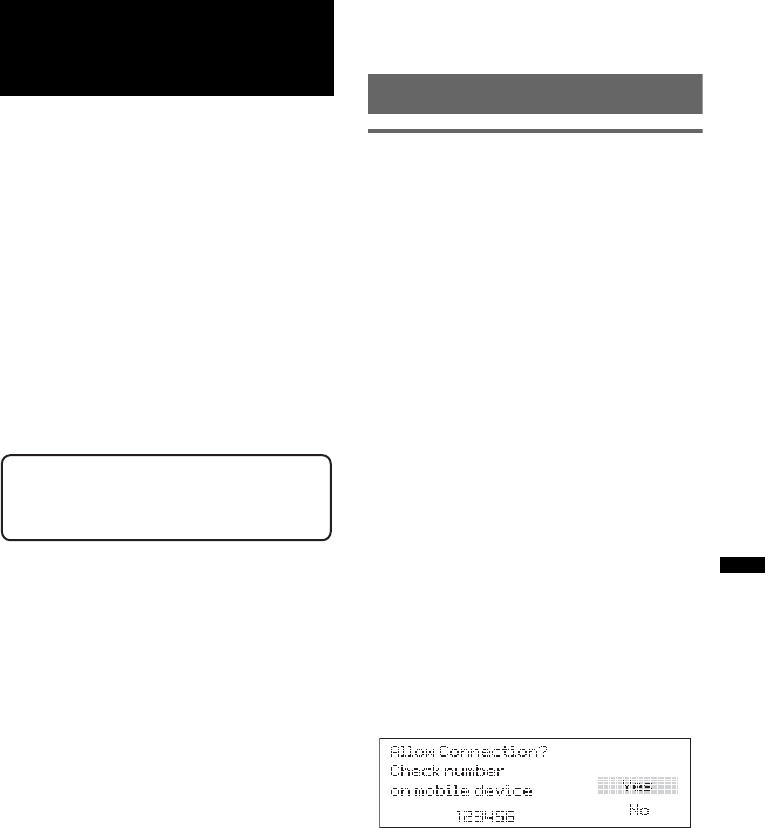
41
Pandora a través de Bluetooth
(teléfonos Android™ y
BlackBerry®)
Pandora Radio es un servicio de radio
personalizado GRATIS, que ahora está
disponible para transmitir música a través de su
teléfono Android y BlackBerry.
Sólo debe comenzar con el nombre de uno de sus
artistas, canciones o compositores clásicos
favoritos y Pandora creará una “estación” que
reproduce esa música y otra música similar.
Puede controlar Pandora en teléfonos Android y
BlackBerry con conexión Bluetooth que tengan
instalada la última versión de Pandora desde esta
unidad.
Descargue la última versión de Pandora y
obtenga más información en www.pandora.com
Para obtener más información acerca de los
dispositivos que se pueden utilizar, visite el sitio
web de soporte técnico.
Notas
•No coloque un teléfono celular o un dispositivo con
funciones de comunicación inalámbrica en la TUNE
TRAY, ya que es posible que no reciba señales
telefónicas o que la comunicación se corte.
•Algunas funciones del servicio de Pandora podrían
no estar disponibles.
•No puede controlar Pandora en teléfonos
inteligentes que no sean Android y BlackBerry.
•En este momento, el servicio de Pandora sólo está
disponible en los EE.UU.
Para utilizar la función Bluetooth, es necesario
realizar el procedimiento siguiente.
1Emparejamiento
Cuando se conectan dispositivos Bluetooth
por primera vez, se requiere un registro
mutuo. Este proceso se denomina
“emparejamiento”. Solamente es necesario
realizar el registro (emparejamiento) la
primera vez, ya que esta unidad y los otros
dispositivos se reconocerán entre sí
automáticamente la próxima vez. Puede
emparejar hasta 9 dispositivos.
2Conexión
Una vez realizado el emparejamiento, conecte
esta unidad y el dispositivo Bluetooth. Según
el dispositivo, la conexión se puede realizar
en forma automática junto con el
emparejamiento.
3Reproducción en Pandora
Por medio de esta unidad, puede escuchar la
radio por Internet Pandora.
Reproducción en Pandora
Reproducción por medio de
Bluetooth
1Conecte esta unidad y el dispositivo
Bluetooth (página 35).
2Baje el volumen desde esta unidad.
3Presione (SOURCE/OFF) varias veces
hasta que aparezca “Please launch
Pandora App on mobile device and
press (PAUSE) on this unit.”.
4Inicie Pandora en el dispositivo
Bluetooth.
5Presione (PAUSE) en esta unidad.*1
6Ajuste el volumen desde esta unidad.
Para pausar la reproducción
Presione (PAUSE). Para cancelar esta función,
vuelva a presionarlo.
Para omitir una canción
Presione el codificador multidireccional hacia la
derecha.
Notas
•No se puede retroceder a la canción anterior.
•Pandora limita la cantidad de saltos permitidos.
*1 Una vez conectado el dispositivo móvil, podría
aparecer el siguiente mensaje. Asegúrese de que
el número del dispositivo se muestre en pantalla
(por ejemplo, 123456) y luego seleccione “Yes” en
el dispositivo y en la unidad.
Sitio Web de soporte técnico en línea
http://esupport.sony.com
http://www.sony.com/mobileAV
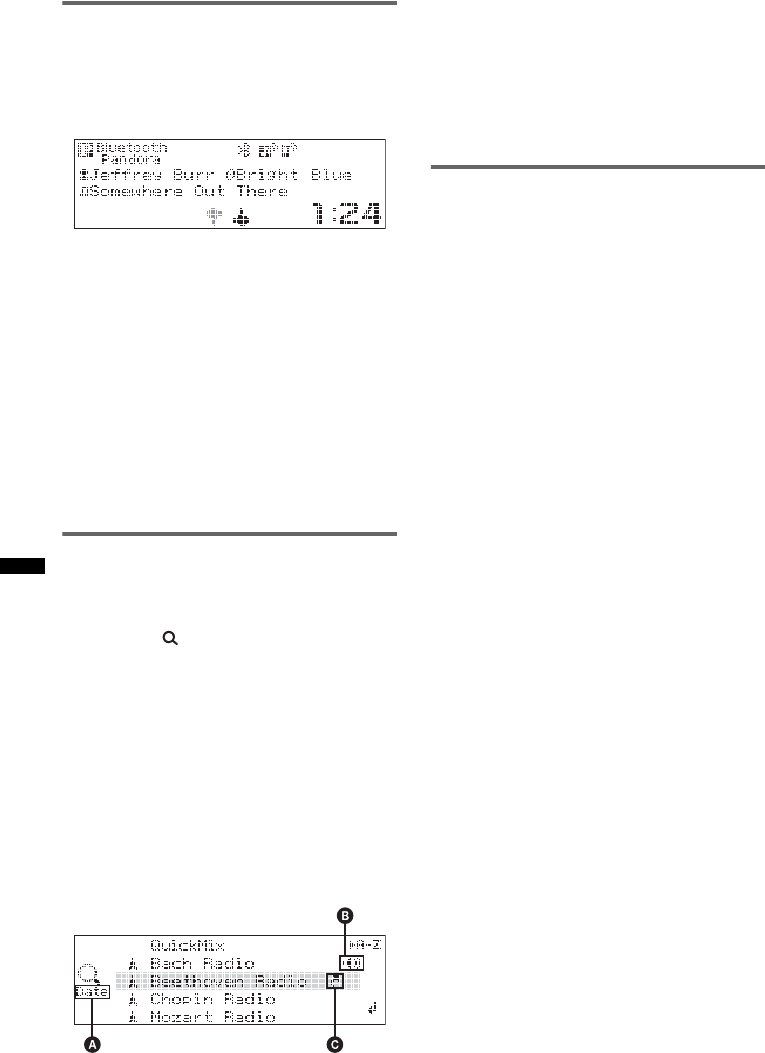
42
Clasificación por “Thumbs
(Pulgares)”
La clasificación por medio de “Thumbs Up
(Pulgares arriba)” o “Thumbs Down (Pulgares
abajo)” le permite personalizar las estaciones
según su gusto personal.
Thumbs Up (Pulgares arriba)
Durante el modo de reproducción, mantenga
presionado el codificador multidireccional hacia
arriba durante 1 segundo.
Thumbs Down (Pulgares abajo)
Durante el modo de reproducción, mantenga
presionado el codificador multidireccional hacia
abajo durante 1 segundo.
Nota
Bajo ciertas circunstancias, la clasificación por
“Thumbs (Pulgares)” podría no estar disponible. En
ese caso, aparecerá en pantalla “Cannot Thumbs Up/
Down”.
Lista de estaciones
La lista de estaciones le permite seleccionar
fácilmente la estación que desea.
1Durante el modo de reproducción,
presione (BROWSE).
Aparecen las estaciones Pandora que están en
su lista.
2Presione el codificador
multidireccional hacia la derecha para
seleccionar el orden: “Date” o “A-Z”.
“Date” ordena las estaciones según la fecha
en que se agregaron a la cuenta y “A-Z”
ordena los nombres de las estaciones en orden
alfabético.
3Gire el codificador multidireccional
para seleccionar la estación deseada y
luego presiónelo.
Se inicia la reproducción.
AOrden actual
BEstación actual
CÍcono compartido
QuickMix
QuickMix le permite escuchar de manera
aleatoria canciones que se reproducen en dos o
más estaciones Pandora de su lista de estaciones.
Edite sus selecciones de estación de QuickMix
en el dispositivo antes de iniciar la conexión.
Agregar marcadores
Se puede agregar un marcador a la canción o al
artista que se reproduce actualmente y se puede
guardar en su cuenta Pandora.
1Durante el modo de reproducción,
mantenga presionado (MODE) hasta
que aparezca “Bookmark”.
2Gire el codificador multidireccional
para seleccionar “Song” o “Artist” y
luego presiónelo.
El marcador se guardará y el sistema
regresará a la pantalla anterior.
Nota
Bajo ciertas circunstancias, el marcador podría no
guardarse. En ese caso, aparecerá en pantalla
“Bookmark Error”. Si esto sucede, intente agregar el
marcador más tarde.

43
Ajustes de sonido y menú de
configuración
Cambio de los ajustes de
sonido
Ajuste de las características de
sonido
1Durante la recepción/reproducción,
presione el codificador
multidireccional.
2Gírelo hasta que aparezca el elemento
de menú deseado y, a continuación,
presiónelo.
3Utilice el codificador multidireccional
para seleccionar el ajuste y, a
continuación, presiónelo.
4Presione (BACK).
El ajuste finaliza y la pantalla regresa al modo
de recepción/reproducción normal.
Puede ajustar los elementos siguientes:
El funcionamiento del codificador
multidireccional varía según los elementos.
: presione el codificador multidireccional
hacia arriba o hacia abajo
: presione el codificador multidireccional
hacia la izquierda o hacia la derecha
: gire el codificador multidireccional
Uso de funciones de sonido
sofisticadas — Advanced
Sound Engine
Advanced Sound Engine, el nuevo motor de
sonido de Sony, crea un campo de sonido ideal
en el automóvil gracias a su procesamiento
digital de sonido. Advanced Sound Engine
ofrece las siguiente funciones: EQ7, Listening
Position, DM+ Advanced, Rear Bass Enhancer y
Dynamic Loudness.
Selección de la calidad de sonido
— EQ7 Preset
Se puede seleccionar una curva de ecualizador de
entre 7 curvas (“Xplod”, “Vocal”, “Edge”,
“Cruise”, “Space”, “Gravity”, “Custom” u
“off”).
1Durante la recepción/reproducción,
presione el codificador
multidireccional.
2Gire el codificador multidireccional
hasta que aparezca “EQ7 Preset” y, a
continuación, presiónelo.
3Presione el codificador
multidireccional hacia arriba y hacia
abajo hasta que aparezca la curva de
ecualizador que desee y, a
continuación, presiónela.
4Presione (BACK).
La pantalla vuelve al modo de recepción/
reproducción normal.
Para cancelar la curva de ecualizador, seleccione
“off” en el paso 3.
EQ7 Preset (página 43)
EQ7 Parametric Tune (página 44)
Listening Position Front/Rear (página 44)
Listening Position Subwoofer (página 45)
Listening Position Custom Tune
(página 45)
Fader & Balance
Front/Rear/Center ()
Permite ajustar el nivel relativo.
Right/Left/Center ()
Permite ajustar el balance de sonido.
Subwoofer Tune & LPF
Phase ()
Permite seleccionar la fase: “Normal”,
“Reverse”.
FREQ ()
Permite seleccionar la frecuencia de corte del
altavoz potenciador de graves: “50Hz”, “60Hz”,
“80Hz”, “100Hz”, “120Hz”.
Slope ()
Permite seleccionar el nivel LPF: ”1”, ”2”, ”3”.
Subwoofer Level ()
Permite ajustar el volumen del altavoz
potenciador de graves: “+10 dB” – “0 dB” –
“–10 dB”.
(“– ∞” aparecerá con el valor más bajo).
HPF
FREQ ()
Permite seleccionar la frecuencia de corte:
“off”, “50Hz”, “60Hz”, “80Hz”, “100Hz”,
“120Hz”.
Slope ()
Permite seleccionar el nivel HPF: ”1”, ”2”, ”3”.
DM+ Advanced (página 45)
Rear Bass Enhancer (página 46)
Dynamic Loudness (página 46)
Bluetooth Audio Level (página 39)
continúa en la página siguiente t

44
Sugerencia
La configuración ajustada de la curva de ecualizador
se puede memorizar por separado para fuentes Tuner,
USB (SensMe™, Pandora USB) y audio Bluetooth
(Bluetooth Pandora).
Personalización de la curva de
ecualizador — EQ7 Parametric
Tune
“Custom” de EQ7 le permite realizar sus propios
ajustes en el ecualizador.
Seleccione “Custom” de EQ7 Preset.
Si configura “off” para EQ7 Preset, “EQ7
Parametric Tune” no aparece en el menú de
ajustes de sonido.
1Seleccione una fuente y, a
continuación, presione el codificador
multidireccional.
2Gire el codificador multidireccional
hasta que aparezca “EQ7 Parametric
Tune” y, a continuación, presiónelo.
3Ajuste de la curva de ecualizador.
•Rango de frecuencia
Gire el codificador multidireccional para
seleccionar “Band1” a “Band7”.
•Frecuencia central
Presione el codificador multidireccional hacia
la izquierda o hacia derecha para seleccionar la
frecuencia central.
Frecuencias centrales que se pueden
seleccionar en cada banda:
Band1: “40 Hz” o “63 Hz”
Band2: “100 Hz” o “160 Hz”
Band3: “250 Hz” o “400 Hz”
Band4: “630 Hz” o “1.0 kHz”
Band5: “1.6 kHz” o “2.5 kHz”
Band6: “4.0 kHz” o “6.3 kHz”
Band7: “10.0 kHz” o “16.0 kHz”
•Nivel de volumen
Presione el codificador multidireccional hacia
arriba/abajo para ajustar la curva de
ecualizador.
El nivel de volumen puede ajustarse en
intervalos de 1 dB, entre –6 dB y +6 dB.
4Presione el codificador
multidireccional una vez terminados
los ajustes del ecualizador.
5Presione (BACK).
La pantalla vuelve al modo de recepción/
reproducción normal.
Para ajustar la curva de ecualizador
predeterminada de fábrica, seleccione
“Initialize” y “Yes” en el paso 3.
Sugerencia
También es posible ajustar otras curvas de
ecualizador.
Optimización de sonido por
alineación de tiempo — Listening
Position
La unidad puede demorar la salida de sonido de
cada altavoz para cambiar la ubicación del
sonido a fin de adaptarse a su posición y simular
un campo de sonido natural con la sensación de
estar en el centro independientemente de la
ubicación del automóvil en que se siente.
A continuación, se enumeran las opciones de
“Listening Position Front/Rear”.
Además, puede configurar la posición
aproximada del altavoz potenciador de graves
desde su posición de escucha si:
– el altavoz potenciador de graves está conectado
– la posición de escucha está configurada en
“Front R”, “Front L”, “Front” o “All”.
A continuación, se enumeran las opciones de
“Listening Position Subwoofer”.
“Near” (A): cerca
“Front R” (1): derecha
delantera
“Front L” (2): izquierda
delantera
“Front” (3): delantera
central
“All” (4): en el centro del
automóvil
“Custom”: posición
calibrada con precisión
(página 45)
“off”: sin configuración de
posición

45
“Normal” (B): normal
“Far” (C): lejos
1Durante la recepción/reproducción,
presione el codificador
multidireccional.
2Gire el codificador multidireccional
hasta que aparezca “Listening
Position Front/Rear” y, a continuación,
presiónelo.
3Presione el codificador
multidireccional hacia arriba y hacia
abajo para seleccionar “Front R”,
“Front L”, “Front”, “All” o “Custom” y,
a continuación, presiónelo.
4Gire el codificador multidireccional
hasta que aparezca “Listening
Position Subwoofer” y, a
continuación, presiónelo.
Si selecciona “Front R”, “Front L”, “Front” o
“All” en el paso 3 anterior, puede configurar
la posición del altavoz potenciador de graves.
Presione el codificador multidireccional hacia
arriba y hacia abajo para seleccionar “Near”,
“Normal” o “Far” y, a continuación,
presiónelo.
5Presione (BACK).
La pantalla vuelve al modo de recepción/
reproducción normal.
Para cancelar la posición de escucha, seleccione
“off” en el paso 3.
Nota
Si selecciona “Custom” en el paso 3, no puede
configurar la posición del altavoz potenciador de
graves.
Calibración precisa por alineación
de tiempo
— Listening Position Custom Tune
Puede calibrar detalladamente la posición de
escucha de cada altavoz para que la demora de
sonido llegue a las personas con más precisión.
Antes de comenzar, mida la distancia entre la
posición de escucha y cada altavoz.
Seleccione “Custom” de Listening Position
Front/Rear.
1Durante la recepción/reproducción,
presione el codificador
multidireccional.
2Gire el codificador multidireccional
hasta que aparezca “Listening
Position Custom Tune” y, a
continuación, presiónelo.
3Configure la posición de escucha.
•Selección del altavoz
Presione el codificador multidireccional hacia
la izquierda o hacia la derecha para seleccionar
el altavoz.
•Distancia
Presione el codificador multidireccional hacia
arriba y hacia abajo para ajustar la distancia
entre la posición de escucha y los altavoces.
La distancia se puede ajustar en intervalos de
2 cm, entre 30 cm y 300 cm.
4Presione el codificador
multidireccional una vez terminados
todos los ajustes.
5Presione (BACK).
La pantalla vuelve al modo de recepción/
reproducción normal.
DM+ Advanced
DM+ Advanced mejora el sonido comprimido
digitalmente ya que restaura las altas frecuencias
perdidas en el proceso de compresión.
Esta función se activa cuando se selecciona
únicamente la fuente de audio USB, SensMe™,
Pandora USB, audio Bluetooth o Bluetooth
Pandora.
1Durante la reproducción, presione el
codificador multidireccional.
2Gire el codificador multidireccional
hasta que aparezca “DM+ Advanced”
y, a continuación, presiónelo.
3Mueva el codificador multidireccional
hacia arriba o hacia abajo para
seleccionar “on” y, a continuación,
presiónelo.
4Presione (BACK).
La pantalla vuelve al modo de recepción/
reproducción normal.
Sugerencia
La configuración ajustada de DM+ se puede
memorizar por separado para fuentes USB
(SensMe™, Pandora USB) y audio Bluetooth
(Bluetooth Pandora).
continúa en la página siguiente t

46
Uso de los altavoces posteriores
como altavoz potenciador de
graves — Rear Bass Enhancer
Rear Bass Enhancer mejora los sonidos graves ya
que aplica el ajuste del filtro de paso bajo
(página 43) a los altavoces posteriores. Esta
función permite que los altavoces posteriores
funcionen como altavoces potenciadores de
graves si uno no está conectado.
1Durante la recepción/reproducción,
presione el codificador
multidireccional.
2Gire el codificador multidireccional
hasta que aparezca “Rear Bass
Enhancer” y, a continuación,
presiónelo.
3Mueva el codificador multidireccional
hacia arriba o hacia abajo para
seleccionar “Level 1”, “Level 2” o
“Level 3” y, a continuación,
presiónelo.
4Presione (BACK).
La pantalla vuelve al modo de recepción/
reproducción normal.
Compensación del nivel de
volumen — Dynamic Loudness
“Dynamic Loudness” hace referencia a la
compensación del nivel de volumen y la ganancia
de señal.
1Durante la recepción/reproducción,
presione el codificador
multidireccional.
2Gire el codificador multidireccional
hasta que aparezca “Dynamic
Loudness” y, a continuación,
presiónelo.
3Mueva el codificador multidireccional
hacia arriba o hacia abajo para
seleccionar “on” y, a continuación,
presiónelo.
4Presione (BACK).
La pantalla vuelve al modo de recepción/
reproducción normal.
Ajuste de los elementos de
configuración — MENÚ
1Mantenga presionado el codificador
multidireccional.
2Gire el codificador multidireccional
para seleccionar el elemento deseado
del menú y, a continuación,
presiónelo.
3Mueva el codificador multidireccional
hacia arriba o hacia abajo para
seleccionar el ajuste y, a continuación,
presiónelo.
El ajuste finalizó.
4Presione (BACK).
El ajuste finaliza y la pantalla regresa al modo
de recepción/reproducción normal.
Se pueden ajustar los elementos siguientes
(consulte la referencia de página para obtener
más información):
Ajuste
Clock Adjust (página 8)
CT (Hora del reloj) (página 19)
Beep
Activa el sonido de los pitidos: “on”, “off ”.
RM (Mando rotatorio)
Permite cambiar la dirección de funcionamiento
de los controles del mando rotatorio: “NORM”,
“REV”.
Auto Off
Desconecta la alimentación automáticamente
una vez transcurrido un período de tiempo
deseado cuando la unidad está apagada: “NO”,
“30sec” (segundos), “30min” (minutos),
“60min” (minutos).
DEV Inside Alert
Activa la función Device Inside Alert: “off”,
“on”.
Pantalla
Demo
(Demostración)
Activa la demostración: “on”, “off”.
Image
Permite establecer que se muestren distintas
imágenes.
– “All”: para mostrar todas las imágenes.
– “Movie”: para visualizar una película.
– “SA 1 – 3, All”: para visualizar el analizador
de espectro.
– “Wall.P 1 – 4, All”: para visualizar un papel
tapiz.
– “off”: para no visualizar ninguna imagen.
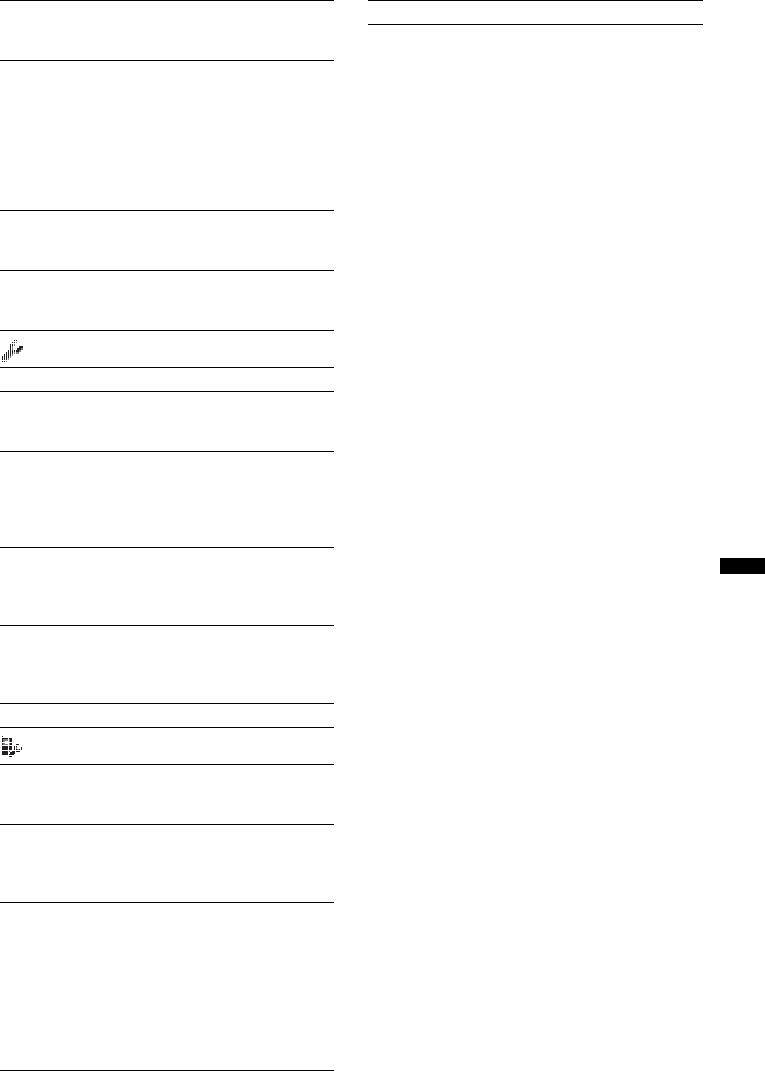
47
Information
Permite mostrar los elementos (en función de la
fuente, etc.): “on”, “off”.
Dimmer
Cambia el brillo de la pantalla.
– “Auto”: para que la pantalla se atenúe
automáticamente al encender la luz.
(Disponible únicamente si la antena
monitorizada de iluminación está conectada).
– “on”: para atenuar la pantalla.
– “off”: para desactivar el atenuador.
Illumination
Permite cambiar el color de la iluminación:
“Blue”, “Red”.
Auto Scroll
Permite desplazarse por los elementos de la
pantalla automáticamente: “on”, “off ”.
Modo de reproducción
Repeat (página 22, 28)
ZAPPIN Tone*1
Permite ajustar el sonido de los pitidos entre
segmentos: “on”, “off”.
ZAPPIN Time*1
Permite seleccionar el tiempo de reproducción
de la función ZAPPIN: “1 (aprox. 6 segundos)”,
“2 (aprox. 15 segundos)”,
“3 (aprox. 30 segundos)”.
Local (Modo de búsqueda local)
– “on”: para que se sintonicen solamente las
emisoras de señal más intensa.
– “off”: para ajustar la recepción normal.
Mono*2 (Modo monoaural)
Selecciona el modo de recepción monoaural
para mejorar una recepción de FM deficiente:
“on”, “off”.
BTM (página 18)
Bluetooth
PhoneBook Select
Selecciona la agenda telefónica: “Cellular”,
“Head Unit”.
Ringtone
Permite utilizar el tono de llamada de esta
unidad o del teléfono celular conectado:
“Default”, “Cellular”.
Auto Answer
Contesta una llamada entrante automáticamente.
– “off”: para no contestar automáticamente las
llamadas entrantes hasta que se presione el
codificador multidireccional.
– “Short”: para contestar automáticamente
después de 3 segundos.
– “Long”: para contestar automáticamente
después de 10 segundos.
BT Initialize*3 (página 40)
*1 Cuando la fuente USB/SensMe™/iPod está
activada.
*2 Cuando se recibe FM.
*3 Cuando la unidad está apagada.
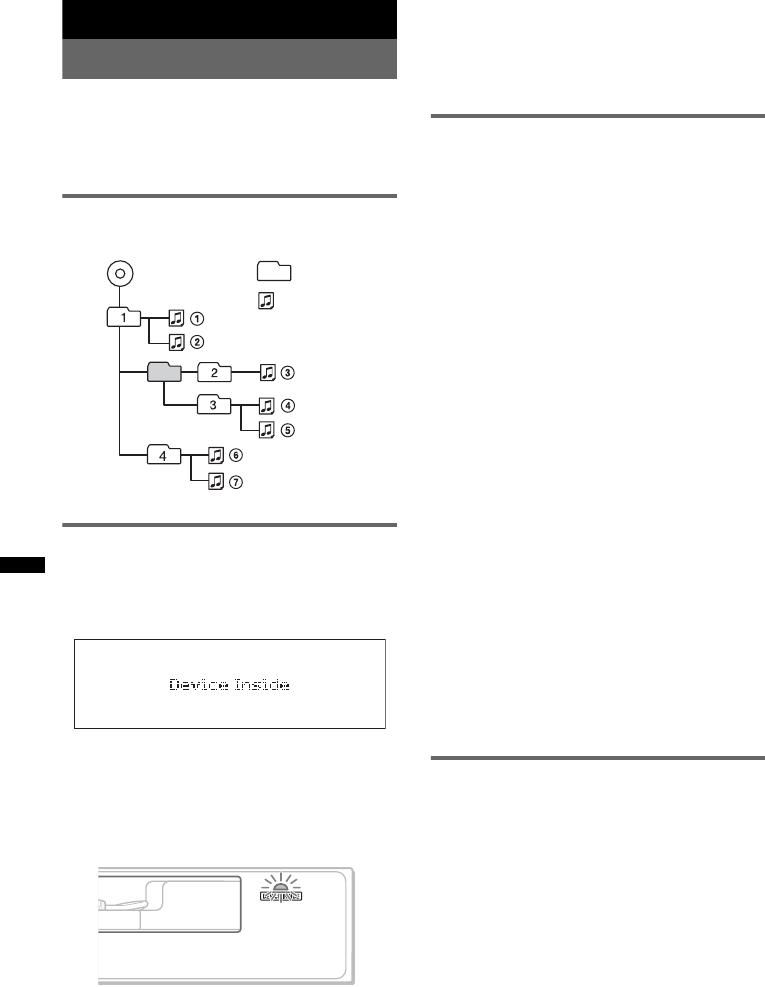
48
Información complementaria
Precauciones
• Deje que la unidad se enfríe antes de usarla si el
automóvil ha estado estacionado bajo la luz
directa del sol.
• La antena motorizada se extiende
automáticamente.
Orden de reproducción de los
archivos MP3/WMA/AAC
Acerca de Device Inside Alert
Si ajusta el interruptor de la llave de encendido
en la posición OFF sin extraer el dispositivo USB
o el iPod, aparecerá “Device Inside” en la
pantalla.
Abra el panel frontal para extraer el dispositivo
USB o el iPod.
Si el panel frontal no está colocado
cuando el motor está apagado.
El LED de Device Inside Alert parpadea.
Sugerencia
Para obtener más información acerca de la extracción
del dispositivo USB o del iPod, consulte la página 21
(USB), 26 (iPod).
Notas
•Device Inside Alert sonará solamente si se utiliza el
amplificador integrado.
•Para obtener información acerca de cómo
desactivar la función Device Inside Alert, consulte
página 46.
Acerca de iPod
• Puede conectarse a los siguientes modelos de
iPod. Actualice sus dispositivos iPod a la última
versión de software antes de utilizarlos.
Made for
– iPod touch (4ª generación)
– iPod touch (3ª generación)
– iPod touch (2ª generación)
– iPod touch (1ª generación)
– iPod classic
– iPod con video*
– iPod nano (6ª generación)
– iPod nano (5ª generación)
– iPod nano (4ª generación)
– iPod nano (3ª generación)
– iPod nano (2ª generación)
– iPod nano (1ª generación)*
–iPhone 4
– iPhone 3GS
– iPhone 3G
–iPhone
*El control del pasajero no está disponible para
iPod nano (1a generación) ni para iPod con video.
• “Made for iPod” y “Made for iPhone” indican que
un accesorio electrónico se diseñó para conectarse
específicamente a los dispositivos iPod o iPhone
respectivamente, y que el fabricante obtuvo la
certificación necesaria para que cumpla con los
estándares de rendimiento de Apple. Apple no se
hace responsable del funcionamiento de este
dispositivo en cumplimiento de los estándares de
seguridad y normativa. Tenga en cuenta que el uso
de este accesorio con el iPod o el iPhone puede
afectar al rendimiento inalámbrico.
Acerca de la función Bluetooth
¿Qué es la tecnología Bluetooth?
• La tecnología inalámbrica Bluetooth es una
tecnología de corto alcance que permite la
comunicación inalámbrica de datos entre
dispositivos digitales, como un teléfono celular y
un auricular. La tecnología inalámbrica Bluetooth
tiene una cobertura de aproximadamente 10 m
(unos 33 pies). Lo habitual es conectar dos
dispositivos, aunque algunos dispositivos pueden
conectarse a varios dispositivos al mismo tiempo.
• No es necesario utilizar un cable para realizar la
conexión ya que la tecnología Bluetooth es
inalámbrica. Tampoco es necesario que los
dispositivos estén orientados entre sí, como sucede
con la tecnología infrarroja. Por ejemplo, puede
utilizar este tipo de dispositivos dentro de una
bolsa o un bolsillo.
Carpeta
(álbum)
Archivo MP3/
WMA/AAC
(pista)
MP3/WMA/AAC

49
• La tecnología Bluetooth es un estándar
internacional admitido por millones de empresas
en todo el mundo y que utilizan varias compañías
a escala internacional.
Acerca de la comunicación Bluetooth
• La tecnología inalámbrica Bluetooth tiene una
cobertura de aproximadamente 10 m.
El área de cobertura puede variar en función de los
obstáculos (personas, objetos metálicos, paredes,
etc.) o del entorno electromagnético.
• Las siguientes condiciones pueden afectar la
sensibilidad de la comunicación Bluetooth.
– La existencia de obstáculos como, una persona,
un objeto metálico o una pared, entre esta unidad
y el dispositivo Bluetooth.
– El uso de dispositivos que utilicen una
frecuencia de 2,4 GHz, como un dispositivo
LAN inalámbrico, un teléfono inalámbrico o un
microondas cerca de la unidad.
• Como los dispositivos Bluetooth y las redes LAN
inalámbricas (IEEE802.11b/g) utilizan la misma
frecuencia, pueden producirse interferencias de
microondas que provoquen el deterioro de la
velocidad de comunicación, la aparición de ruido
o una conexión no válida si la unidad se utiliza
cerca de un dispositivo LAN inalámbrico. En este
caso, realice el procedimiento siguiente.
– Utilice esta unidad a una distancia mínima de
10 m del dispositivo LAN inalámbrico.
– Si utiliza esta unidad a menos de 10 m de un
dispositivo LAN inalámbrico, apague el
dispositivo LAN inalámbrico.
– Instale esta unidad y el dispositivo Bluetooth a la
distancia más corta posible entre sí.
• Las microondas que emite un dispositivo
Bluetooth pueden afectar el funcionamiento de
dispositivos médicos electrónicos. Apague esta
unidad y los demás dispositivos Bluetooth en los
lugares siguientes ya que podrían provocar un
accidente.
– Lugares con presencia de gas inflamable,
hospitales, trenes, aviones o gasolineras.
– Lugares cerca de puertas automáticas o alarmas
de incendios.
• Esta unidad admite recursos de seguridad que
cumplen con el estándar Bluetooth para
proporcionar una conexión segura al utilizar la
tecnología inalámbrica Bluetooth, pero es posible
que la seguridad sea insuficiente según el ajuste.
Tenga cuidado al realizar una comunicación con la
tecnología inalámbrica Bluetooth.
• No se aceptan responsabilidades por la pérdida de
información que pudiera producirse durante una
comunicación Bluetooth.
• No se garantiza la comunicación con todos los
dispositivos Bluetooth.
– Un dispositivo que disponga de la función
Bluetooth debe cumplir el estándar Bluetooth
SIG y estar autenticado.
– Incluso en el caso de que el dispositivo
conectado cumpla el estándar Bluetooth
mencionado anteriormente, es posible que
algunos dispositivos no puedan conectarse o
funcionar correctamente, según las
características o las especificaciones del
dispositivo.
– Mientras esté hablando con el manos libres del
teléfono, puede producirse ruido, según el
dispositivo o el entorno de comunicación.
• En función del dispositivo que vaya a conectarse,
es posible que transcurra cierto tiempo antes de
que se inicie la comunicación.
Otros
• Es posible que el dispositivo Bluetooth no
funcione en teléfonos celulares según las
condiciones de las ondas de radio y la ubicación
en la que se utilice el equipo.
• Si no se siente cómodo después de utilizar el
dispositivo Bluetooth, deje de utilizarlo
inmediatamente. Si el problema persiste, consulte
con el distribuidor Sony más cercano.
Si desea realizar alguna consulta o solucionar algún
problema relativo a la unidad que no se trate en este
manual, póngase en contacto con el distribuidor
Sony más cercano.
Mantenimiento
Sustitución de la pila de litio del
control remoto de tarjeta
En condiciones normales, la pila dura
aproximadamente 1 año. (La duración puede ser
menor en función de las condiciones de uso.)
El alcance del control remoto de tarjeta disminuye a
medida que se agota la pila. Sustitúyala por una pila
de litio CR2025 nueva. El uso de cualquier otra pila
podría provocar un incendio o una explosión.
Notas sobre la pila de litio
•Mantenga la pila de litio fuera del alcance de los
niños. Si se ingiriese, póngase en contacto
inmediatamente con un médico.
•Limpie la pila con un paño seco para garantizar un
contacto óptimo.
•Asegúrese de observar la polaridad correcta al
instalarla.
continúa en la página siguiente t
Lado + hacia arriba
c

50
•No sujete la pila con pinzas metálicas, ya que podría
producirse un cortocircuito.
Sustitución del fusible
Al sustituir el fusible, asegúrese
de utilizar uno cuyo amperaje
coincida con el especificado en
el original. Si el fusible se
funde, verifique la conexión de
alimentación y sustitúyalo. Si el
fusible vuelve a fundirse
después de sustituirlo, es
posible que exista alguna falla
de funcionamiento interno. En
tal caso, consulte con el
distribuidor Sony más cercano.
Limpieza de los conectores
Es posible que la unidad no funcione correctamente
si los conectores entre ésta y el panel frontal están
sucios. Para evitar esta situación, extraiga el panel
frontal (página 8) y limpie los conectores con un
hisopo de algodón. Realice esta operación con
suavidad. De lo contrario, los conectores podrían
resultar dañados.
Notas
•Por razones de seguridad, apague el motor antes de
limpiar los conectores y extraiga la llave del
interruptor de encendido.
•No toque nunca los conectores directamente con los
dedos ni con ningún dispositivo metálico.
Extracción de la unidad
1Extraiga el marco de protección.
1Extraiga el panel frontal (página 8).
2Sujete el marco de protección por ambos
bordes y extráigalo.
2Extraiga la unidad.
1Inserte las dos llaves de liberación
simultáneamente hasta escuchar un clic.
2Tire de las llaves de liberación para extraer
la unidad.
3Deslice la unidad para extraerla del marco.
ADVERTENCIA
La pila puede explotar si no se emplea
adecuadamente.
No recargue la pila; tampoco la desmonte ni
la arroje al fuego.
Fusible (10 A)
Unidad principal Parte posterior
del panel frontal
x
El gancho
debe mirar
hacia adentro.

51
Especificaciones
Sección del sintonizador
FM
Rango de sintonización: de 87,5 a 107,9 MHz
Terminal de antena: conector de antena externa
Frecuencia intermedia: 150 kHz
Sensibilidad útil: 10 dBf
Selectividad: 75 dB a 400 kHz
Relación señal-ruido: 70 dB (mono)
Separación: 40 dB a 1 kHz
Respuesta de frecuencia: de 20 a 15 000 Hz
AM
Rango de sintonización: de 530 a 1 710 kHz
Terminal de antena: conector de antena externa
Frecuencia intermedia: 25 kHz
Sensibilidad: 26 µV
Sección del reproductor USB
Interfaz: USB (Velocidad máxima)
Corriente máxima: 500 mA
Comunicación inalámbrica
Sistema de comunicación:
Versión estándar Bluetooth 2.1 + EDR
Salida:
Energía estándar Bluetooth Clase 2 (Máx. +4 dBm)
Alcance máximo de la comunicación:
Línea de visión aprox. 10 m (33 pies) *1
Banda de frecuencias:
Banda de 2,4 GHz (2,4000 a 2,4835 GHz)
Método de modulación: FHSS
Perfiles compatibles con Bluetooth*2:
A2DP (Advanced Audio Distribution Profile) 1.2
AVRCP (Audio Video Remote Control Profile) 1.3
HFP (Handsfree Profile) 1.5
PBAP (Phone Book Access Profile)
OPP (Object Push Profile)
*1 El alcance real variará según factores, como los
obstáculos entre los dispositivos, los campos
magnéticos alrededor de un horno de microondas,
electricidad estática, sensibilidad de recepción,
funcionamiento de la antena, sistema operativo,
aplicación del software, etc.
*2 Los perfiles estándar de Bluetooth indican el
propósito de la comunicación Bluetooth entre
dispositivos.
Sección del amplificador de potencia
Salida: salidas de los altavoces
Impedancia de altavoz: de 4 a 8 Ω
Salida de potencia máxima: 52 W × 4 (a 4 Ω)
Generales
Salidas:
Terminal de salidas de audio (frontal/posterior)
Terminal de salida del altavoz potenciador de
graves (mono)
Terminal de control del relé de la antena
motorizada
Terminal de control del amplificador de potencia
Entradas:
Terminal de entrada del control remoto
Terminal de entrada de la antena
Terminal de control ATT de teléfono
Terminal de control de iluminación
Terminal de entrada de control BUS
Terminal de entrada de audio BUS
Conector de entrada de señal USB (interno/
externo)
Terminal de entrada del micrófono
Requisitos de alimentación: batería de automóvil de
cc 12 V (masa negativa, tierra)
Dimensiones: aprox. 178 × 50 × 180 mm (an/al/prf)
Dimensiones de montaje: aprox. 182 × 53 × 163 mm
(an/al/prf)
Peso: aprox. 1,1 kg
Accesorios suministrados:
Control remoto de tarjeta: RM-X306
Conector USB para iPod: XA-50IP
Componentes de instalación y conexiones
(1 juego)
Micrófono
Equipo y accesorios opcionales:
Selector de fuente: XA-C40
Cable de conexión USB para iPod: RC-100IP
Sintonizador de HD RadioTM: XT-100HD
Adaptador de Walkman: XA-50WM
Es posible que su distribuidor no comercialice
algunos de los accesorios que figuran en la lista
anterior. Pídale información detallada.
El diseño y las especificaciones están sujetos a
cambios sin previo aviso.
Requisitos del sistema para usar
SensMe™
Equipo
•CPU/RAM
– Máquina compatible con IBM PC/AT
– CPU: Intel Pentium III con procesador de 450 MHz
o superior
– RAM: 256 MB o más (para Windows XP), 512 MB
o más (para Windows Vista o posterior)
• Puerto USB
SO
Windows XP, Windows Vista, Windows 7
Para obtener más información acerca de las ediciones
compatibles o Service Pack, visite el siguiente sitio de
soporte:
http://esupport.sony.com
http://www.sony.com/mobileAV
Monitor
Color de alta densidad (16 bits) o superior, 800 × 600
puntos o más
Otros
Conexión a Internet
continúa en la página siguiente t

52
Notas
•No se admiten los siguientes entornos de sistema.
– Ningún equipo PC IBM, como Macintosh, etc.
– Equipos caseros
– Equipos con SO actualizados
– Entornos con pantallas múltiples
– Entornos con arranques múltiples
– Entornos de equipos virtuales
•Según el estado del equipo, es posible que no
funcione aún con el entorno recomendado.
Solución de problemas
La siguiente lista de comprobación le ayudará a
solucionar los problemas que puedan producirse con
la unidad.
Antes de consultarla, revise los procedimientos de
conexión y de funcionamiento.
Si no se resuelve el problema, visite el siguiente
sitio web de soporte técnico.
Generales
La unidad no recibe alimentación.
• Revise la conexión o el fusible.
• Si la unidad está apagada y la pantalla desaparece, no
se puede operar con el control remoto.
tEncienda la unidad.
La antena motorizada no se extiende.
La antena motorizada no dispone de una caja de relé.
No se emite el sonido.
• La función ATT está activada o la función ATT de
teléfono (cuando se conecta el cable de interfaz de un
teléfono para automóvil al cable ATT) está activada.
• La posición del control de equilibrio “Fader &
Balance” no está ajustada para un sistema de 2
altavoces.
El contenido de la memoria se borró.
• Presionó el botón RESET.
tVuelva a almacenar los datos en la memoria.
• Se desconectó el cable de fuente de alimentación o la
batería, o no están conectados correctamente.
Las emisoras almacenadas y la hora correcta
se borraron.
El fusible se fundió.
Se escucha ruido cuando se cambia la
posición de la llave de encendido.
Los cables no se conectaron de forma correcta al
conector de alimentación auxiliar del automóvil.
Durante la reproducción o la recepción, el
modo demostración se inicia.
Si no se realiza ninguna operación durante 5 minutos y
la opción “Demo on” está ajustada, se inicia el modo
de demostración.
tAjuste “Demo off” (página 46).
Sitio Web de soporte técnico en línea
http://esupport.sony.com
http://www.sony.com/mobileAV
Las indicaciones desaparecen de la pantalla o
no aparecen en el visualizador.
• El atenuador está ajustado en “Dimmer on”
(página 47).
• La pantalla se apaga si mantiene presionado
(SOURCE/OFF).
tPresione (SOURCE/OFF) en la unidad hasta que
se ilumine la pantalla.
• Los conectores están sucios (página 50).
La función de desconexión automática no
funciona.
La unidad está encendida. La función de desconexión
automática se activa después de apagar la unidad.
tApague la unidad.
Recepción de radio
No es posible recibir las emisoras.
Hay ruidos que obstaculizan el sonido.
• La conexión no es correcta.
tConecte un cable de control de la antena
motorizada (azul) o un cable de fuente de
alimentación auxiliar (rojo) al cable de fuente de
alimentación del amplificador de señal de la
antena del automóvil (solamente cuando el
automóvil tenga una antena de FM/AM integrada
en el cristal posterior o lateral).
tCompruebe la conexión de la antena del
automóvil.
tSi la antena motorizada no se extiende,
compruebe la conexión del cable de control de la
antena motorizada.
No es posible utilizar la sintonización
programada.
• Almacene la frecuencia correcta en la memoria.
• La señal de emisión es demasiado débil.
No es posible utilizar la sintonización
automática.
• El ajuste del modo de búsqueda local no es correcto.
tLa sintonización se detiene con demasiada
frecuencia:
Ajuste “Local on” (página 47).
tLa sintonización no se detiene en una emisora:
Ajuste “Local off” (página 47).
• La señal de emisión es demasiado débil.
tUse la sintonización manual.
Durante la recepción de FM, la indicación “ST”
parpadea.
• Sintonice la frecuencia con precisión.
• La señal de emisión es demasiado débil.
tAjuste “Mono on” (página 47).
Un programa de FM emitido en estéreo se
escucha en monoaural.
La unidad se encuentra en el modo de recepción
monoaural.
tAjuste “Mono off” (página 47).

53
RDS
PTY muestra “- - - - - - - -”.
• La emisora actual no es una emisora RDS.
• No se recibieron datos RDS.
• La emisora no especifica el tipo de programa.
Reproducción USB
No es posible reproducir elementos a través de
un concentrador USB.
Esta unidad no puede reconocer dispositivos USB a
través de un concentrador USB.
No se pueden reproducir elementos.
Un dispositivo USB no funciona.
tVuelva a conectarlo.
El dispositivo USB tarda en reproducirse.
El dispositivo USB contiene archivos con una
estructura de árbol compleja.
Los elementos de pantalla no se desplazan.
• Es posible que una gran cantidad de caracteres no se
desplacen.
• La opción “Auto Scroll” está “off”.
tAjuste “Auto Scroll on” (página 47).
tMantenga presionado (DSPL) (SCRL).
El sonido es discontinuo.
Es posible que la discontinuidad del sonido se deba a
una tasa alta de bits de más de 320 kbps.
No es posible realizar la conexión con
Pandora.
Apague Pandora en el dispositivo móvil e inícielo de
nuevo.
Función Bluetooth
El dispositivo de conexión no puede detectar
esta unidad.
• Antes de realizar el emparejamiento, configure esta
unidad en el modo de espera del emparejamiento.
• Mientras se conecta al otro dispositivo Bluetooth,
esta unidad no puede detectarse desde otro
dispositivo. Desconecte la conexión actual y busque
esta unidad desde otro dispositivo.
• Una vez realizado el emparejamiento del dispositivo,
active la salida de señal de Bluetooth (página 35).
No es posible realizar la conexión.
Compruebe los procesos de emparejamiento y
conexión en el manual del otro dispositivo, etc. y
repítalos.
No aparece el nombre del dispositivo
detectado.
Según el estado del otro dispositivo, es posible que no
se pueda obtener el nombre.
No se emite ningún tono de llamada.
• Ajuste el nivel de volumen en “Ring Volume”.
• Según el dispositivo de conexión, es posible que el
tono de llamada no se emita correctamente.
tAjuste “Ringtone” en “Default” (página 37).
El volumen de la voz de la persona que habla
es bajo.
Ajuste el nivel de volumen en “Talk Volume”.
El interlocutor de una llamada le notifica que el
volumen es demasiado bajo o demasiado alto.
Ajuste el volumen según corresponda mediante MIC
Gain (página 37).
Se producen ecos o ruidos durante las
conversaciones telefónicas.
• Baje el volumen.
• Ajuste “EC/NC Mode” en “EC/NC Mode 1” o
“EC/NC Mode 2” (página 37).
• Si el ruido ambiental ajeno al de la llamada telefónica
es alto, intente reducirlo.
Ej.: Si una ventana está abierta y el ruido de la calle,
etc., es excesivo, ciérrela. Si el aire acondicionado
está alto, bájelo.
El teléfono no está conectado.
Durante la reproducción de audio Bluetooth, el
teléfono no está conectado aunque presione el
codificador multidireccional.
tRealice la conexión desde el teléfono.
La calidad de sonido del teléfono es baja.
La calidad del sonido del teléfono depende de las
condiciones de recepción del teléfono celular.
tMueva el automóvil a un lugar en el que pueda
mejorar la señal del teléfono celular si la recepción
es de mala calidad.
El volumen del dispositivo de audio conectado
es bajo (alto).
El nivel de volumen cambiará dependiendo del
dispositivo de audio.
tAjuste el volumen del dispositivo de audio
conectado o de esta unidad.
No se oye ningún sonido proveniente del
dispositivo de audio Bluetooth.
El dispositivo de audio se encuentra en pausa.
tCancele la pausa del dispositivo de audio.
Se omite el sonido durante la reproducción de
un dispositivo de audio Bluetooth.
• Reduzca la distancia entre la unidad y el dispositivo
de audio Bluetooth.
• Si el dispositivo de audio Bluetooth está guardado en
un estuche que interrumpe la señal, retírelo para
utilizarlo.
• En los alrededores, se utilizan varios dispositivos
Bluetooth u otros dispositivos que emiten ondas de
radio.
tApague los otros dispositivos.
tReduzca la distancia entre la unidad y los otros
dispositivos.
• El sonido de reproducción se detiene
momentáneamente mientras se establece la conexión
entre esta unidad y el teléfono celular. No se trata de
una falla de funcionamiento.
No es posible controlar el dispositivo de audio
Bluetooth conectado.
Compruebe que el dispositivo de audio Bluetooth
conectado sea compatible con AVRCP.
Algunas funciones no están disponibles.
Compruebe que el dispositivo de conexión sea
compatible con las funciones en cuestión.
continúa en la página siguiente t

54
Mensajes/indicaciones de error
El nombre del otro interlocutor no aparece al
recibir una llamada.
• El número y el nombre del interlocutor no se
encuentran almacenados en la agenda telefónica.
tAlmacene dichos datos en la agenda telefónica
(página 38).
• El teléfono desde el que se llama está ajustado para
no mostrar el número de teléfono.
Se contesta una llamada accidentalmente.
• El teléfono conectado está configurado para iniciar
las llamadas automáticamente.
• “Auto Answer” en esta unidad se encuentra ajustado
en “Short” o “Long” (página 37).
El emparejamiento ha fallado porque se ha
superado el tiempo establecido.
Según el dispositivo de conexión, es posible que el
tiempo para el emparejamiento sea escaso. Intente
completar el emparejamiento en el tiempo establecido.
No es posible utilizar la función Bluetooth.
Presione (SOURCE/OFF) durante 2 segundos para
apagar la unidad y, a continuación, enciéndala de
nuevo.
Durante la llamada con manos libres, los
altavoces del automóvil no emiten ningún
sonido.
Si el sonido de salida viene del teléfono celular, ajuste
el teléfono para que el sonido se emita por los
altavoces del automóvil.
No es posible realizar la conexión con
Pandora.
Apague Pandora en el dispositivo móvil e inícielo de
nuevo.
Busy now... Please try later
La unidad está ocupada.
tTras esperar un momento, inténtelo de nuevo.
Checking
La unidad está confirmando la conexión de un
dispositivo USB.
tEspere mientras finaliza el proceso de confirmación
de la conexión.
Connection Failed
El acceso a la agenda telefónica ha finalizado desde el
teléfono celular.
tAcceda a la agenda telefónica nuevamente.
Device Inside
Si ajusta el interruptor de la llave de encendido en la
posición OFF sin extraer el dispositivo USB o el iPod,
aparecerá “Device Inside” en la pantalla.
Empty
• El historial de llamadas está vacío.
• La agenda telefónica está vacía.
Error
• El dispositivo USB no ha sido reconocido
automáticamente.
tConéctelo nuevamente.
• El contenido de la agenda telefónica ha sido
modificado durante el acceso al teléfono celular.
tAcceda a la agenda telefónica nuevamente.
Failure (Permanece iluminado hasta que se presiona
algún botón.)
La conexión de los altavoces y amplificadores es
incorrecta.
tConsulte el manual de instalación de este modelo
para revisar la conexión.
Failure (Se ilumina durante 1 segundo
aproximadamente).
Cuando se conectó el sintonizador SAT, se produjo un
error al almacenar una emisora de radio SAT en un
número de presintonía.
tAsegúrese de recibir la emisora que desea
almacenar e inténtelo de nuevo.
HF Device is not available
No hay ningún teléfono celular conectado.
tConecte un teléfono celular.
Hubs Not Supported
El concentrador USB no es compatible con esta
unidad.
Invalid channel file
Es posible que se haya editado un archivo de la carpeta
de música sin utilizar “Content Transfer”.
tVuelva a realizar el ajuste de “SenseMe™ Setup”
para el dispositivo USB o Walkman nuevamente.
Para obtener más información acerca de
“SenseMe™ Setup”, consulte la página 23.
Local Seek +/–
El modo de búsqueda local está activado durante la
sintonización automática.

55
Si estas soluciones no ayudan a mejorar la situación,
póngase en contacto con el distribuidor Sony más
cercano.
NO Device
USB se selecciona como fuente sin que esté conectado
a un dispositivo USB. Se ha desconectado un
dispositivo USB o un cable USB durante la
reproducción.
tAsegúrese de conectar un dispositivo USB y un
cable USB.
NO Music
El dispositivo USB no contiene ningún archivo de
música.
tConecte un dispositivo USB que contenga algún
archivo de música.
NO Name
No se ha grabado ningún nombre de álbum/artista/pista
en la pista.
No SensMe™ data on device.
El dispositivo USB conectado no contiene datos para
la función SensMe™, o los datos han sido movidos a
una ubicación incorrecta en el dispositivo USB.
NO Track
El elemento seleccionado en el dispositivo USB no
contiene ningún álbum/pista.
Not Found
No existe ningún elemento que comience con la letra
deseada en la búsqueda alfabética.
Not Supported
El dispositivo USB conectado no es compatible.
tPara obtener más información acerca de la
compatibilidad del dispositivo USB, visite el sitio
web de soporte técnico.
Offset
Es posible que se haya producido una falla interna.
tRevise la conexión. Si el indicador de error
permanece en pantalla, póngase en contacto con el
distribuidor Sony más cercano.
Overload
El dispositivo USB está sobrecargado.
tDesconecte el dispositivo USB y, a continuación,
presione (SOURCE/OFF) para cambiar la fuente.
tIndica que el dispositivo USB está fuera de
servicio, o que hay un dispositivo incompatible
conectado.
Read
La unidad está leyendo toda la información de las
pistas y los álbumes del dispositivo USB.
tEspere hasta que finalice la lectura y se inicie la
reproducción automáticamente.
Push Reset
No es posible utilizar el dispositivo USB debido a un
problema.
tPresione el botón RESET (página 7).
“” o “”
Durante la operación de retroceso o avance rápido, ha
llegado al principio o al final del dispositivo USB, por
lo que no es posible continuar dicha operación.
“”
No se puede mostrar el carácter con la unidad.
Please launch Pandora Application on mobile
device.
Pandora no se inicia.
tInicie Pandora en el iPhone.
Please launch Pandora App on mobile device
and press (PAUSE) on this unit.
Pandora no se inicia.
tInicie Pandora en el dispositivo Bluetooth y luego
presione (PAUSE).
Application error on mobile device. Do not
check the mobile device while driving.
Pandora no se inicia.
tInicie Pandora e inicie sesión en su cuenta.
USB External Not Supported
El dispositivo USB conectado no es un dispositivo
Pandora.
tConecte un iPhone.
NO Station
No hay ninguna estación en su cuenta Pandora.
tCree la estación en el dispositivo móvil.
Cannot Skip
No se permite omitir pistas en Pandora.
tEspere a que finalice el comercial.
tPandora limita la cantidad de saltos permitidos en
su servicio. Espere a que comience la canción
siguiente o elija otra estación de la lista.
Cannot Thumbs Up/Down
No se permite la clasificación por “Thumbs
(Pulgares)”.
tEspere a que finalice el comercial.
tAlgunas funciones, como Shared Station, no
permiten la clasificación. Espere a que comience la
canción siguiente o elija otra estación de la lista.
Thumbs Up/Down Error
Falló la clasificación por “Thumbs (Pulgares)”.
tIntente “Thumbs Up/Down (Pulgares arriba/
abajo)” otra vez.
Bookmark Not Allowed
No se permite agregar marcador.
tEspere a que finalice el comercial.
tSeleccione otra canción o estación y luego inténtelo
de nuevo.
Bookmark Error
Falló la colocación de marcadores.
tIntente agregar un marcador de nuevo.
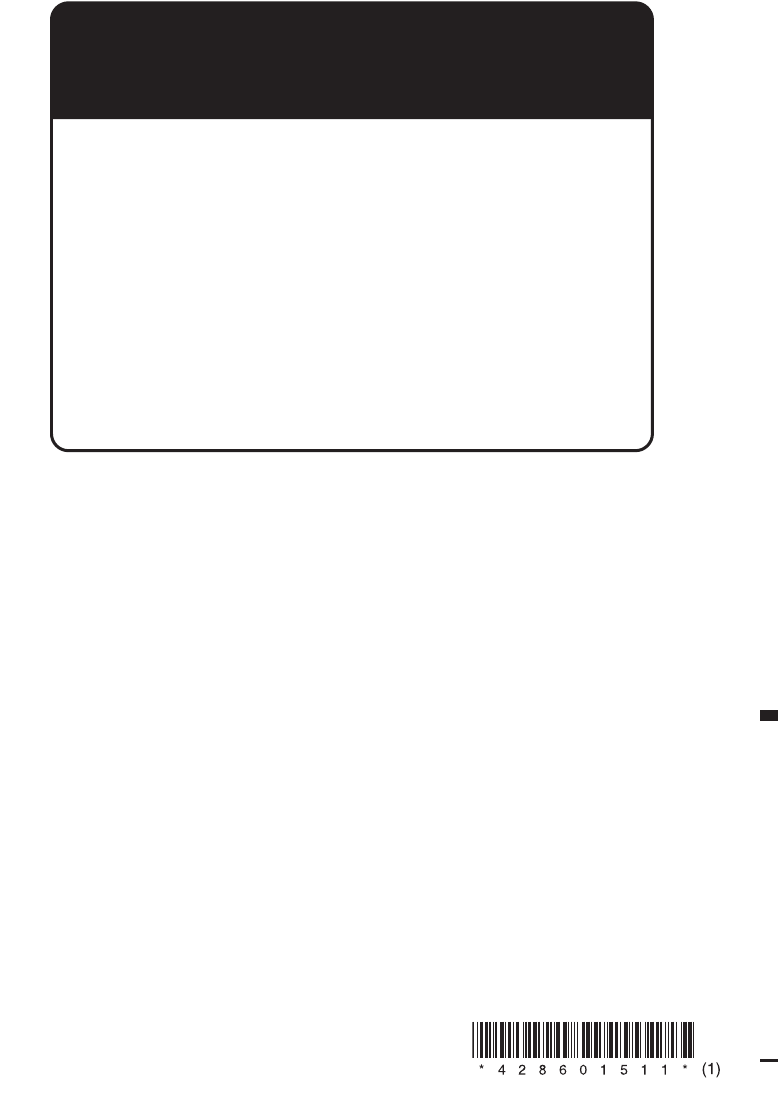
Sony Corporation
Printed in Thailand
http://www.sony.net/
If you have any questions/problems
regarding this product, try the following:
1
Read Troubleshooting in these
Operating Instructions.
2
Reset the unit.
Note: Stored data may be erased.
3
Please contact (U.S.A. only);
Call
1-800-222-7669
URL
http://www.SONY.com